
Turning the tables
Turning the tables
Karen Rolton Oval’s
Karen Rolton Oval’s
Karratha complete
Karratha complete
The
The
Welcome to Brisbane 2024 Australian Sports Turf Management Conference Welcome to Brisbane 2024 Australian Sports Turf Management Conference
drop-in
experiment
drop-in
Character restored Commonwealth GC’s course renaissance Character restored Commonwealth GC’s course renaissance
experiment
Pilbara’s first grass greens course
Pilbara’s first
greens course Heading home Profile – Cameron Smith Heading home Profile – Cameron Smith www.astma.com.au CELEBRATING THE EFFORTS OF AUSTRALIA’S SPORTS TURF MANAGEMENT PROFESSIONALS ISSN 1442-2697 VOLUME 26.3 MAY-JUN 2024
grass

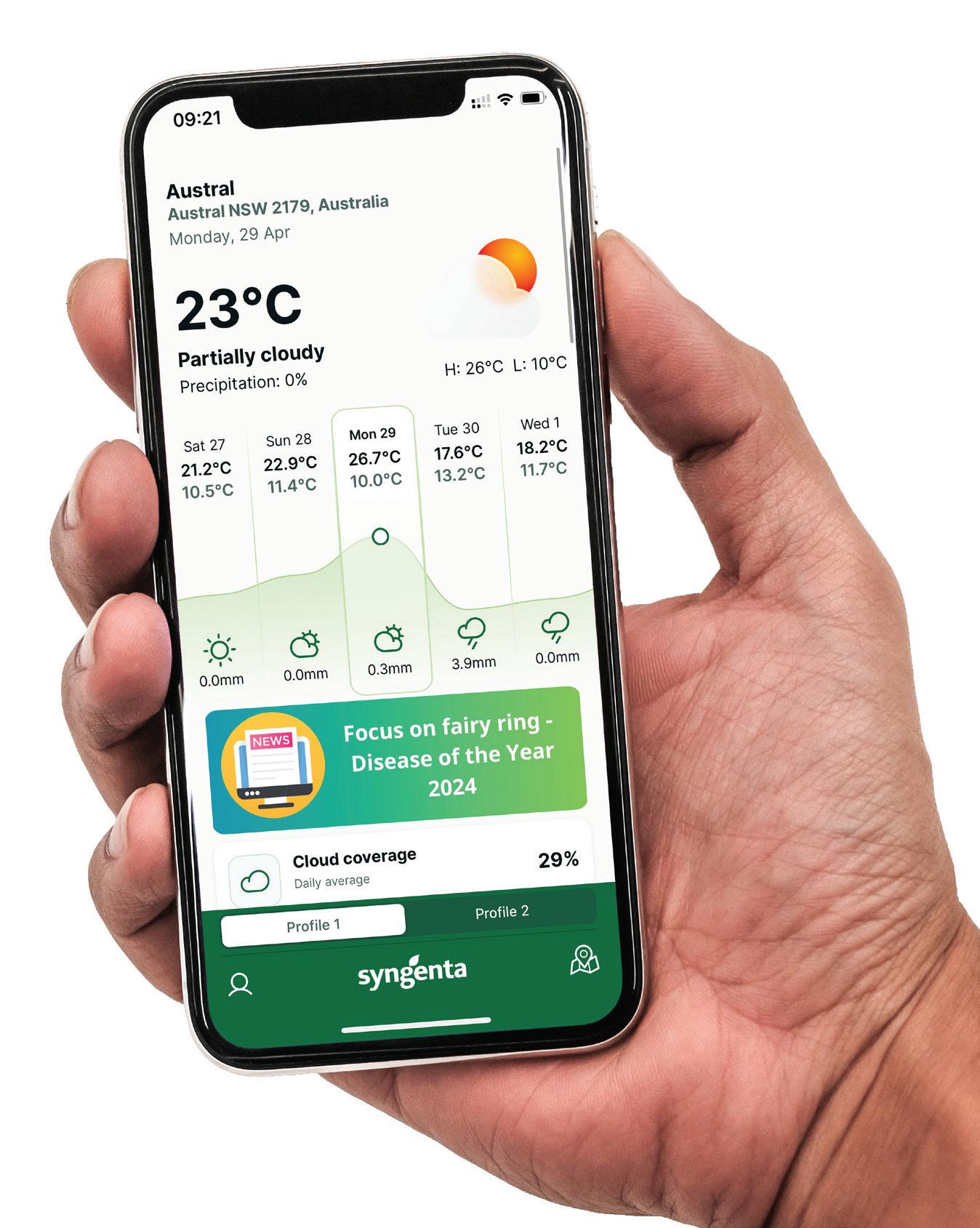

Launching at the Australian Sports Turf Management Conference Always read the label before use. Syngenta Australia Pty Ltd, Level 1, 2 Lyonpark Road, Macquarie Park NSW 2113. ABN 33 002 933 717. ®Registered trademark of Syngenta Group Company. All products written in uppercase are registered trademarks of a Syngenta Group Company. © 2024 Syngenta. AD 24-146.
Published by the Australian Sports Turf Managers Association (ASTMA)
Editorial
Brett Robinson
Office: (03) 9548 8600
Mobile: 0434 144 779
Email: brett@astma.com.au
Advertising
Pam Irvine
Office: (03) 9548 8600
Mobile: 0402 069 489
Email: pam@astma.com.au
Art Direction & Design
Jo Corne
Printed By Southern Impact Pty Ltd
Suite 1, Monash Corporate Centre
PREMIUM PARTNERS
PREMIUM PARTNERS

752 Blackburn Road, Clayton, VIC 3168
P: (03) 9548 8600 E: admin@astma.com.au
W: www.astma.com.au
ABN 96 053 205 888
ASTMA Board
Ben Tilley (Headland GC, president), David Thomson (Bermagui CC), Peter Lonergan (Coolangatta & Tweed Heads GC), Damian Hough (Adelaide Oval), Troy Jordan (MOPT) and Mark Findlay (Werribee Park GC)
Chief Executive Officer
Mark Unwin
Office: (03) 9548 8600
Mobile: 0438 320 919
E: mark@astma.com.au
Membership
Allison Jenkins
E: admin@astma.com.au
Finance Manager
Frank Joseph
E: frank@astma.com.au
Events and Education
Simone Staples
E: simone@astma.com.au
Pam Irvine
E: pam@astma.com.au
RTO/Training Manager
Albert Sherry
E: albert@astma.com.au
M: 0437 064 726
AGCSATech
Bruce Macphee (Senior Agronomist)
E: bruce@astma.com.au
Tim Fankhauser (Agronomist)
E: tim@astma.com.au


www.facebook.com/TheASTMA www.linkedin.com

www.instagram.com/the_astma

@TheASTMA
PREMIUM PARTNERS
PARTNERS
PREMIUM PARTNERS
PREMIUM PARTNERS
ASTMA PREMIUM PARTNERS
PARTNERS
indebted to the support of the following premium partner companies
The Australian Sports Turf Managers Association is indebted to the support of the following premium partner companies
The Australian Sports Turf Managers Association is indebted to the support of the following premium partner companies
The Australian Sports Turf Managers Association is indebted to the support of the following premium partner companies



PARTNERS

PARTNERS
PREMIUM PARTNERS



















































MAY-JUNE 2024 1
JOURNAL
Copyright © 2024 The ASTMA believes that material sourced and produced for Australian Turfgrass Management is accurate, but gives no warranty in relation thereto, and disclaims liability for all claims against the ASTMA, its subsidiary companies, its employees, agents or any other person which may arise from any person acting on the materials contained within. No portion, in whole or part, may be reproduced without the written permission of the ASTMA
The Australian Sports Turf Managers Association is indebted to the support of the following premium partner companies PLATINUM GOLD SILVER BRONZE The Australian Sports Turf Managers Association encourages all members to support these companies who support your association
The Australian Sports Turf Managers Association is indebted to the support of the following premium partner companies PLATINUM GOLD SILVER BRONZE The Australian Sports Turf Managers Association encourages all members to support these companies who support your association
PREMIUM
PREMIUM
Australian Sports Turf Managers Association
indebted
following premium partner companies PLATINUM GOLD SILVER BRONZE The Australian Sports Turf Managers Association encourages all members to support these companies who support your association PREMIUM
Australian Sports Turf
indebted
the following premium partner companies PLATINUM GOLD SILVER BRONZE The Australian Sports Turf Managers Association encourages all members these companies who support your association
The
is
to the support of the
PARTNERS The
Managers Association is
support of
Australian Sports Turf
PLATINUM GOLD SILVER BRONZE The Australian Sports Turf Managers Association encourages all members to support these companies who support your association
PREMIUM PARTNERS The
Managers Association is
PLATINUM GOLD SILVER BRONZE The Australian Sports Turf Managers Association encourages all members to support these companies who support your association PREMIUM
PLATINUM GOLD SILVER BRONZE The Australian Sports Turf Managers Association encourages all members to support these companies who support your association
PLATINUM GOLD SILVER BRONZE The Australian Sports Turf Managers Association encourages all members to support these companies who support your association
Australian Sports Turf Managers Association is indebted to
support of the following premium partner companies PLATINUM GOLD SILVER BRONZE The Australian Sports Turf Managers Association encourages all members to support these companies who support your association PLATINUM GOLD SILVER BRONZE The Australian Sports Turf Managers Association encourages all members to support these companies who support your association PREMIUM
Australian
the following premium partner
PLATINUM GOLD SILVER BRONZE The Australian Sports Turf Managers Association encourages all members to support these companies who support your association
The
the
The
Sports Turf Managers Association is indebted to the support of
companies
Australian Sports
PLATINUM GOLD SILVER BRONZE The Australian Sports Turf Managers Association encourages all members to support these companies who support your association
The
Turf Managers Association is indebted to the support of the following premium partner companies
Australian Sports Turf
following premium partner
PLATINUM GOLD SILVER BRONZE The Australian Sports Turf Managers Association encourages all members to support these companies who support your association
The
Managers Association is indebted to the support of the
companies

LEAD STORY
KAREN ROLTON OVAL DROPS IN 8
Following its redevelopment in 2017, Karen Rolton Oval has become one of South Australian cricket’s principal First Class venues. Working in conjunction with the Adelaide Oval Turf Solutions team, ahead of the 2023/2024 cricket season the Karen Rolton Oval crew installed two drop-in wickets in the middle of their conventional table to assist them getting early season pitches up under increasing usage pressures. Editor Brett Robinson catches up with head curator Trent Kelly (pictured above) to look at the process to get them in and how the experiment of having both styles of wickets side by side has gone after the first season.
Cover: Royal Queensland Golf Club’s par three 17th during the 2023 Australian PGA Championship. The club plays host to the 2024 ASTMA Golf Championship on 17 June.
Photo: Brett Robinson.



2 AUSTRALIAN TURFGRASS MANAGEMENT 26.3
FEATURES Commonwealth restored 16 Karratha complete 22 Welcome to Brisbane 30 2024 ASTMA Golf Championship 36 Trade Exhibition showcase 38 Graduate of the Year profiles 44 ALSO IN THIS EDITION… Foreword Thinking – Mark Unwin 4 Best on ground – Socials 6 Around the Trade 64 Association Reports 66 Up the last... 70 16 8
58 44 CONTENTS
PHOTO: DAVID SCALETTI

COLUMNS

Contributors to Australian Turfgrass Management Journal Volume 26.3 (May-June 2024): 2024 Graduate of the Year finalists; Shane Baker (GCSAWA); Leo Barber; Nathan Bennett (TMSA); John Forrest (Forrest and Forrest Horticultural Consultancy Services); Ben Gibson (The Toolbox Team); Mark Hauff (GCSAQ); Callum Hitching (Karratha CC); Damian Hough (Adelaide Oval); Trent Kelly (Karen Rolton Oval/SACA); Adam Lamb (Commonwealth GC); Peter McMaugh AM (Turfgrass Scientific Services); Adam Mills (Royal Queensland GC); Mary Napier (VGCSA); John Neylan (Sporteng); Jeff Powell (VGCSA); Albert Sherry (ASTMA); Cameron Smith (Sanctuary Cove G&CC); Simon Snedden (ACTSTMA); Simone Staples (ASTMA); Mark Unwin (ASTMA);
On a fast track
As the industry prepares to converge on Brisbane for the 2024 Australian Sports Turf Management Conference, half a world away two Australian turf managers are in the thick of one of the most unique events and experiences of their careers. Adelaide Oval head curator Damian Hough and his assistant Todd Heinrich have been based in the US since ANZAC Day, playing a key role in managing the drop-in wickets being used at New York’s Nassau County International Cricket Stadium which is hosting eight games as part of this year’s ICC Men’s T20 World Cup.
How they, and the recently formed Adelaide Oval Turf Solutions entity, ended up involved in the tournament, being jointly hosted by the US and West Indies, is a remarkable story and can be traced back to the 2023 turf conference in Adelaide. Early that week last June, Hough was walking across the pedestrian bridge which connects Adelaide Oval to the convention centre when he received a phone call from fellow South Australian curator David Agnew. Agnew has been based overseas for a number of years and has played major roles in preparing and managing wickets for T20 competitions, including last year’s inaugural season of Major League Cricket (MLC) in the US. There he helped transform Grand Prairie Stadium, a former baseball venue just outside of Dallas, Texas, into the primary host venue for the MLC and he is again in charge of preparing the venue as it hosts four matches for the World Cup.
Agnew informed Hough that the International Cricket Council (ICC) wanted to speak to him about drop-in wickets as part of their plans to construct a 34,000-seat pop up stadium to host World Cup games in Long Island, New York. They wanted Hough’s expertise to construct and eventually manage the drop-in wickets for the tournament, with the only catch being he would have effectively nine months to do it all in. No pressure!
Those discussions set in motion a flurry of activity and come the Labour Day long weekend in South Australia last October, the ICC gave Hough and the Adelaide Oval Turf Solutions team the green light. Since then 10 portable wicket trays, designed by Hough and engineered in Adelaide, were shipped over to Florida last December, bolted together, wicket soil added and meticulously consolidated in layers, turf (Tahoma 31) laid and grown in. After months of careful nurturing, on 28 April, with Hough and Heinrich watching on like nervous parents, the wickets were lifted, placed on 20 flatbed semi-trailers and transported 1800 kilometres up the east coast of the US to Long Island for installation. The trip took two days, with Hough and Heinrich jetting up to oversee four match-day wickets being installed at Nassau County and the other six at a nearby warm-up facility.
Speaking to Hough just a few days out from their first World Cup game on 3 June, he was happy with how everything had gone, especially considering the race against time to get everything completed. Producing consistent wickets is a methodical and at times slow process and to have achieved what they have given the time restraints is something quite remarkable. In an upcoming edition of Australian Turfgrass Management Journal we will relay the full story of the World Cup drop-ins and the key role that a number of Australian curators have played to bring the tournament to fruition. Along with Hough and Heinrich (and Agnew), two other members of the Adelaide Oval crew – Marcus Kightley and Sam Worley – have also been involved at varying stages assisting the Florida World Cup venue – Central Broward Park and Broward County Stadium in Lauderhill – which is hosting four games.
Our lead story in this ‘conference edition’ also focuses on drop-in wickets and the role that the Adelaide Oval team played in a unique solution at another of South Australia’s First Class venues, Karen Rolton Oval. Utilising two of Adelaide Oval’s existing drop-in wickets, they were transported through the inner suburbs of Adelaide in an impressive feat of logistics and installed in the middle of Karen Rolton Oval’s conventional wicket table. The idea behind the exercise was to enable curator Trent Kelly and his team to get early season wickets up given the increased usage of the venue in recent years. Again, it is another great story of how members of the turf industry are adept at thinking outside the square to remedy a problem.
Elsewhere in this edition, superintendent Adam Lamb looks back at the completion of Commonwealth Golf Club’s course restoration project, while Callum Hitching recounts the long journey that Karratha Country Club has been on to convert its sand scrapes to grass, becoming the first course in the Pilbara region of Western Australia to now boast turf greens.
Enjoy the read and I look forward to seeing you in Brisbane for the conference.
 Brett Robinson, Editor
Brett Robinson, Editor
MAY-JUNE 2024 3
JOHN NEYLAN 48 PETER MCMAUGH AM 52 JOHN FORREST 54 BEN GIBSON 58
MAY-JUNE 2024 3
70
6

THINKING WITH MARK UNWIN, CEO
Anticipation builds for conference return to Brisbane
As the largest event on the Australian sports turf management industry calendar draws closer, preparations for the Brisbane conference (17-20 June) have seen the team finalising the program and activities, with delegate attendance tracking ahead of last year (Adelaide) and ahead of the previous conference held in conjunction with Golf Management Australia in Melbourne, 2022.
A full preview of the conference is included in this edition of Australian Turfgrass Management (from page 30) where details of the impressive speaking line-up are explored further. Highlighting the agronomic topics is Associate Professor Jay McCurdy from the world-leading Mississippi State University Agronomy and Turfgrass Department.
Dr McCurdy has been leading a range of turf research projects in areas including developing effective herbicide programs, developing and implementing Growing Degree Day programs and pre- and post-emergent approaches to control, all of which promise to be enlightening sessions for turf managers attending the Brisbane conference.
Complementing these, the ASTMA team has put together a compelling line-up of local
and international speakers, delivering over 120 hours of education sessions across the three days, plus an expanded and sold-out trade exhibition which will be held on the Wednesday and Thursday (19 and 20 June).
As the conference nears and our activities focus on bringing it to fruition, I have found myself contemplating the importance of events of this type to sports turf managers and indeed the industry. Following on from a very challenging (and enduring) summer and autumn for many parts of the country, combined with the ongoing difficulties around workforce attraction and retention, it means that this year’s conference takes on another level of importance.
The ability to connect with peers, in person, is something highly valued by many in a challenging industry. The conference, much like state association days, allows for the sharing of issues and ideas, fostering a sense of community and connection with like-minded professionals who can share successes and find solutions. These are all brilliant examples of the power of these events and why attendance remains critical to turf managers.
Another area of importance that can often be overlooked is that of recognition and celebrating the achievements of individuals and teams. From a personal perspective, I thoroughly look forward to the Turf Industry Awards Night which enables the industry to applaud a number of turf managers and their teams, in addition to recognising emerging turf managers through the Graduate of the Year Award program. The awards night shines a spotlight on those who have achieved so much and is a real highlight of the conference week. I wish all award finalists the best and look forward to celebrating this year’s winners.
On behalf of the ASTMA Board and staff, we are excited to welcome you to Brisbane and trust you will take away plenty from this year’s conference and trade exhibition. See you there!
4 AUSTRALIAN TURFGRASS MANAGEMENT 26.3 FOREWORD
AGCSATech Independent, Analytical, Diagnostic and Consultancy Services AGCSATech Independent, Analytical, Diagnostic and Consultancy Services CONTACT THE AGCSATECH TEAM (03) 9548 8600 Senior agronomist - Bruce Macphee Agronomist - Tim Fankhauser bruce@astma.com.au 0409 183 710 tim@astma.com.au 0422 418 038 www.astma.com.au/agcsatech The Australian turf industry’s leading provider of independent agronomic services. l EXPERT AGRONOMIC ADVICE l GOLF COURSE, SPORTSFIELD AND RACETRACK ASSESSMENTS l DESIGN AND CONSTRUCTION SPECIFICATIONS l DRONE DIAGNOSTIC SERVICES AND AERIAL IMAGERY l SOIL, PLANT AND WATER ANALYSIS l DISEASE AND NEMATODE ANALYSIS l COST EFFECTIVE NUTRITION AND MAINTENANCE PROGRAMS l WATER MANAGEMENT PLANS l PROJECT MANAGEMENT

on groundBest
ATM showcases some of the best social media posts and pictures from around the sports turf industry in recent months.

 DAVID WARNAAR
DAVID WARNAAR
While not quite the Aurora Australis that lit up southern Australian skies in mid-May, Commercial Club Albury superintendent David Warnaar did manage to capture this stunningly vibrant sunrise while out mowing greens on a crisp autumnal morning.
SOCIAL MEDIA


ST ANDREWS LINKS
“An incredible night at the Home of Golf.” (A magical photo of the Aurora Borealis captured at 2.30am in mid-May by Jon Wood, course manager of the Old, New and Jubilee courses at St Andrews.)



KIM KENNEDY
“Flaggers ‘24.” (Kingston Heath greenkeeper Kim Kennedy, pictured back row second from left, was part of the victorious Commonwealth Golf Club women’s team which claimed the Golf Victoria Division 1 Pennant title in April.)


COOPS SPORTS TURF
“People ask why I get up so early for work! Best part of the day!” (Grant Cooper couldn’t have summed it up better after snapping the above photo while cutting the bowling greens at Warners Bay Sporting Club, NSW.)

SUNCORP STADIUM
“Big week for the Grounds Team with the NRL Women’s State of Origin Game 1 and Magic Round this weekend!” (The Suncorp Stadium crew of Michael Gilman, Matthew Oliver and Rob Saxby took time out from their preparations for a photo shoot and article in Brisbane’s Courier Mail newspaper.)

MAY-JUNE 2024 7
drops in Karen Rolton Oval

Following its redevelopment in 2017, Karen Rolton Oval in Adelaide has become one of South Australian cricket’s principal first-class venues. Ahead of the 2023/2024 season, two drop-in wickets were installed in the middle of the ground’s conventional wicket table to assist getting early season pitches up under increasing usage pressures. ATM editor Brett Robinson catches up with SACA grounds manager Trent Kelly to see how the experiment has fared after its first season.
Sports turf managers are, by nature, problem-solvers.
Generally, there isn’t a day goes by without something requiring their ability to come up with a solution to a problem that has arisen, whether it’s on a golf course, sportsground, racetrack or bowling green. Some are quick fixes – a sprinkler malfunction for example – while others may require a little more consideration – a disease outbreak for instance or an area of turf which might be underperforming. Then
there those which require a complete rethink and change of approach, setting in motion a flurry of activity involving multiple parties and resources which all have to come together to rectify a developing situation.
A few seasons ago, Trent Kelly, grounds manager at the South Australian Cricket Association’s (SACA) Karen Rolton Oval in Adelaide, was facing the latter scenario. On the back of increasing usage pressures, brought about in part by the COVID pandemic which saw the ground become a primary venue for
a number of domestic cricket competitions, Kelly and his team were struggling to get good quality early season wickets up. Compounding matters, the wickets were often the subject of growing criticism from players and coaches.
Those who know Kelly well will appreciate he is not the sort of guy who sits on his hands. He likes things to move at pace and with purpose, which is rather apt considering he spent a number of years as a fast bowler representing both South Australia and Western Australia at Sheffield Shield level. If there’s a
8 AUSTRALIAN TURFGRASS MANAGEMENT 26.3 CRICKET
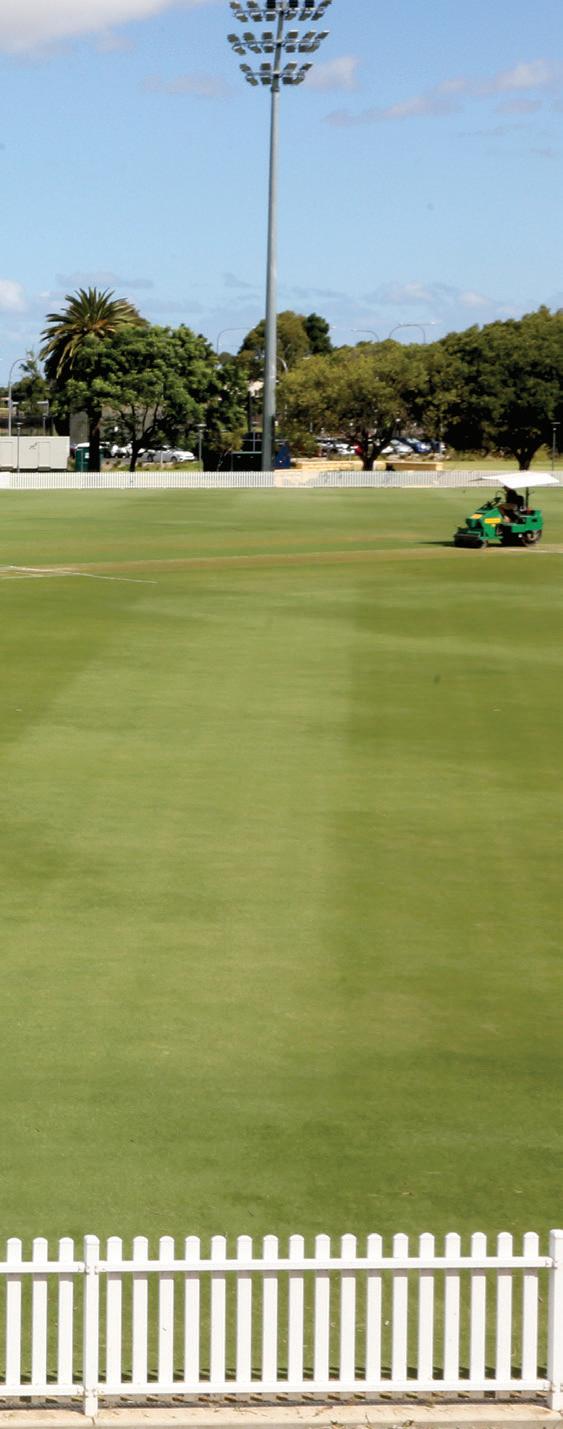
Karen Rolton Oval grounds manager Trent Kelly says having the two drop-in wickets alongside their natural wickets has been a real success and enabled them to better prepare early season decks
problem, action is required immediately and in the case of Karen Rolton Oval at that time a solution was needed.
Ultimately, the resolution that would end up being agreed upon is one which cricket curators across the country will be looking upon with keen interest. With the backing of SACA, two drop-in wickets were sourced from Adelaide Oval and placed in the middle of Karen Rolton Oval’s conventional wicket table ahead of the 2023/2024 cricket season.
The idea behind it was two-fold – to help assist in the provision of early season wickets and to provide South Australia’s high performance players and teams with a level of consistency across Adelaide’s two primary first-class venues (Adelaide Oval and Karen Rolton Oval). In doing so SACA has made an investment for the betterment of cricket in the state and is helping to provide the best possible surfaces for their players to achieve success on the national stage.
PRIMARY VENUE
Kelly has been ground manager at Karen Rolton Oval, located just outside of the Adelaide CBD, coming up to seven years this November. As mentioned, Kelly enjoyed “a shortish” first-class career which saw him represent the Redbacks for four years before finishing off his playing days with two seasons for Western Australia. After hanging up the spikes, Kelly successfully transitioned into turf management full time, a passion which had developed back in his days as a junior and which he had continued to pursue during his representative career.
Growing up, Kelly had played for local Adelaide club West Torrens where one of the junior coordinators was well known Holdfast Bay Bowling Club greenkeeper Kevin Lewis, who sadly passed away a few years ago. Lewis volunteered his time to help prepare the club’s pitches and Kelly would eagerly assist over a number of seasons. As he moved up through the playing ranks, Kelly’s affinity for cricket wickets continued to develop and he was lucky enough during his SA rep days to spend time at Adelaide Oval under Les Burdett who would later become his father-in-law.
After returning to Adelaide from Perth, Kelly started up his own business in 2009 called TK Turf Services, initially specialising in cricket pitch preparation. That soon expanded into managing sportsfields for local councils, schools and colleges, with the business eventually employing six staff. It was successful and had a good reputation and would ultimately lead to him landing the role with SACA at Karen Rolton Oval.
Kelly arrived there in late 2017 just as a major redevelopment of the ground was coming to a conclusion. Prior to that, the ground was essentially a green space known as Railway Oval which hosted local cricket and AFL. Gradual improvements started being made from 2010 onwards, with SACA eventually approving a full redevelopment which would include construction of a brand new Santa Ana couchgrass outfield and wicket square and three-level pavilion. The precinct would also have a name change to honour one of the greats of Australian women’s cricket, former captain and 2016 ICC Cricket Hall of Fame inductee Karen Rolton.
The spec for the new ground was developed by Daryl Sellar and comprised a 300mm sand capped outfield with full drainage

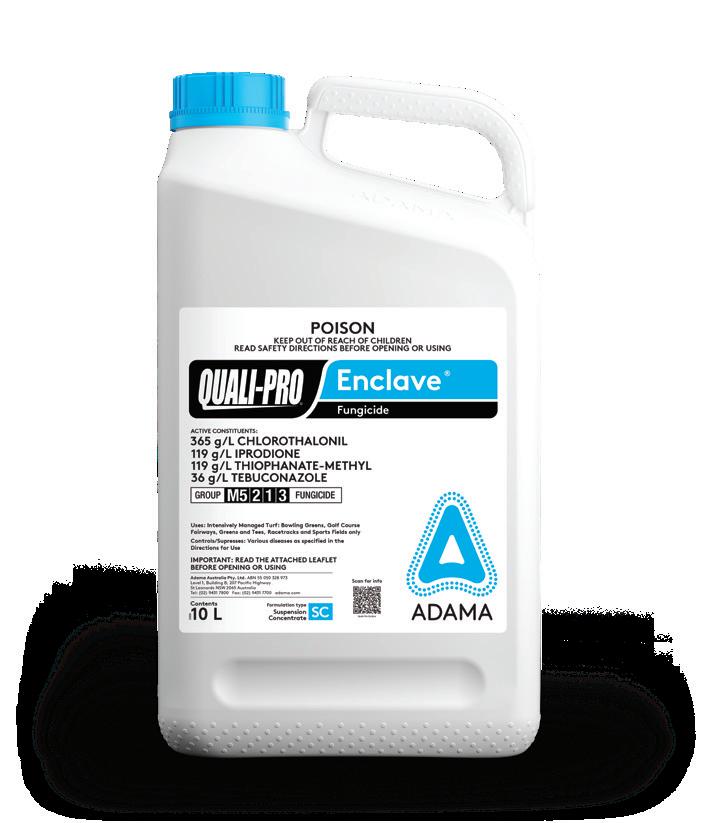
MAY-JUNE 2024 9
Quali-Pro® Enclave® – the clear choice for broad spectrum control of all major turf diseases, moss and algae. Moss and algae = problem. Quali-Pro® Enclave® = solution!

and irrigation systems. The middle would see two wicket squares built (150mm clay) containing three Santa Ana pitches each, separated by a narrow sand strip where the centre circle for AFL was. The pitches were on mains water and the outfield recycled water.
While the centre strip was beneficial for football, it did limit the number of pitches that Kelly could prepare, so in 2019 the square was extended internally and the sand strip removed, increasing the number of wickets to eight. That would prove invaluable as usage of the ground had started to ramp up significantly since the redevelopment.
VICTIM OF ITS OWN SUCCESS
A turning point for the venue came when COVID hit in 2020. With sporting fixtures thrown into chaos due to border closures, SACA floated the idea to Cricket Australia of having a Sheffield Shield hub in Adelaide utilising three venues – Karen Rolton Oval, the adjacent Park 25 ground (which Kelly and his team manage) and Glenelg Oval – to enable the season to get started. Between 10 October and 11 November, 10 Shield matches would be played in Adelaide, four each at Karen Rolton Oval and Park 25 and two at Glenelg.
The hub was a wonderful challenge and learning experience for Kelly and his team. The turf program on Park 25 was ramped up to
ensure that the wickets and outfield mirrored the quality of Karen Rolton Oval. Logistically it was a huge exercise and in addition to getting match-day wickets ready (sometimes with only a break of five days between games) they also had to prepare numerous practice wickets. Making that more challenging was doing so in early spring when soil and ambient temperatures in Adelaide were still low and not the most conducive to growing couchgrass.
Ultimately a huge success, the hub in a way would trigger the eventual path the venue would go down to installing drop-in wickets. The ground inadvertently become a victim of its own success and across the next couple of seasons, as COVID continued to impact scheduling, it would be called upon more and more to host matches. That included a lateseason national women’s U19 tournament in mid-April as well as early season starts for the Women’s National Cricket League (WNCL), Sheffield Shield and One Day Cup competitions in September. On top of all that, the venue was also seeing an increase in its high performance load, with greater demand being placed upon the centre wickets for training by SA representative teams.
The upshot of all this meant it was becoming increasingly difficult for Kelly and his team to produce good quality wickets. With the season running later, recovery of the

wicket square heading into winter was being compromised. Then, with football across the table in winter combined with earlier season starts, it was becoming harder to get wickets up, not only due to the wear but also the less than ideal growing conditions as they were doing renovations earlier. It was a vicious cycle and with games then on top of all that, by November the wicket square was often in average condition and it would take until well into summer to get a full cover of turf back on the wickets. The challenges around getting early season wickets up were also being borne out in the match results, with the wickets offering little assistance for bowlers and games often ending in draws.
As turf managers do, Kelly and his team racked their brains to remedy the issues they were facing. They reviewed their renovation and nutritional programs to see where they could make improvements or changes, but at the end of the day it all came back to one thing – how could they get grass up so early in the season? They knew the scheduling wasn’t going to change, so it was time to think outside the square.
DROP-IN SOLUTION
It was September 2022 when Kelly, SACA’s then high performance manager Tim Nielsen and Adelaide Oval head curator Damian Hough first started having discussions around the potential of using drop-in wickets. It seemed like the perfect solution to the problems that Karen Rolton Oval was experiencing, but first a business case had to be made as well as figuring out how it could actually be orchestrated. What made the option particularly attractive was that Adelaide Oval had 10 existing drop-in wickets but only room for eight, meaning there was a surplus and thus no requirement to build new trays. After numerous meetings and presentations, the SACA Board ultimately approved a plan for two of Adelaide Oval’s drop-ins to be sent across to Karen Rolton Oval and installed in the middle of the existing natural wicket table.
Excavating the centre of the existing wicket table in readiness for the two drop-ins to be installed
10 AUSTRALIAN TURFGRASS MANAGEMENT 26.3 CRICKET
PHOTOS: NEARMAP
Originally known as Railway Oval, the ground was redeveloped in 2017 and subsequently renamed Karen Rolton Oval after the famed former Australian women’s cricket captain. Photo far left shows the old ground in April 2016. The middle two images were taken during the redevelopment, with the far right image taken early March 2024



Although only separated by a little over a kilometre as the crow flies, the logistics of getting the drop-ins from Adelaide Oval to Karen Rolton Oval were substantial. With the River Torrens separating the two grounds, it wasn’t simply a matter of driving the wicket transporter through the CBD as the loads were too big (each pitch weighs about 30 tonnes and the transporter 27 tonnes). Local company Symons-Clark Logistics was brought on board to organise the various permits required and work with the SA Government’s Department of Infrastructure and Transport to come up with a designated route.
Across two days and evenings in late August 2023, the 25m long x 3m wide pitches were lifted from the Adelaide Oval nursery and placed on a flatbed truck. The wicket transporter was then placed on a second truck and both were driven in a wide loop to the north and west of the Adelaide CBD before eventually entering the Karen Rolton Oval precinct off of Port Road. The pitches were taken off the flatbed by the transporter before it was manoeuvred onto place and the trays lowered into the table (see photos above).
Prior to all that, Kelly and his staff had prepared the square to accommodate the drop-ins. They dug out the middle two pitches to the required length, width and depth and installed some levelling piers and drainage. Their wicket table soil, a traditional Adelaide cricket pitch soil, was different to that of the drop-ins which were constructed with Athelstone clay which Burdett had stockpiled during his time at Adelaide Oval.
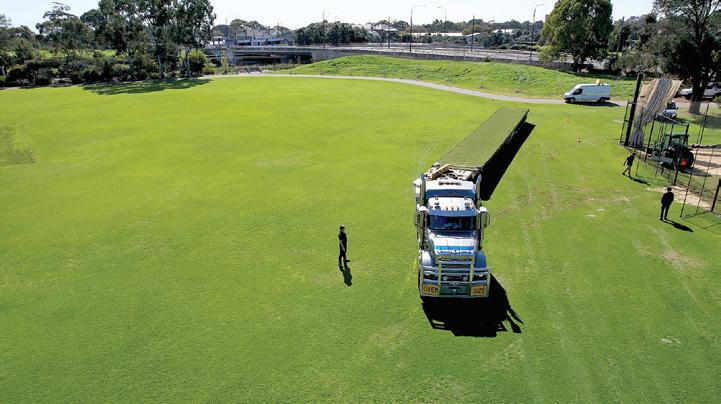
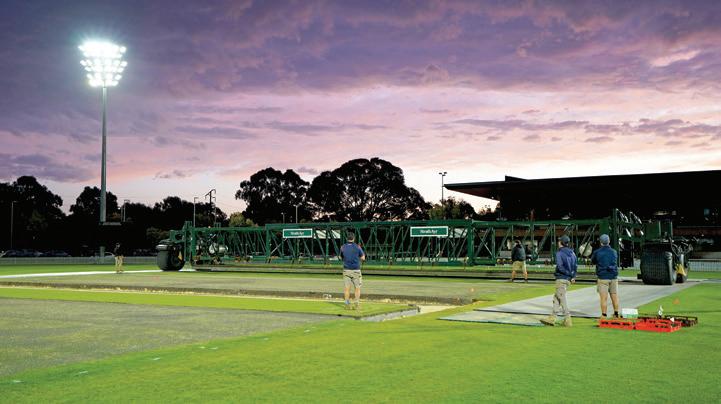
The drop-ins chosen were two that Hough and his team had constructed some 10 years earlier shortly after Adelaide Oval was redeveloped and had moved exclusively to using drop-in pitches. They had been used the previous season for Sheffield Shield and One Day Cup games and after being removed were renovated. That involved putting a Koro topmaker over them and milling out the top 10mm to remove as much organic matter as possible to allow the Santa Ana to reshoot.
Once the wickets were in place at their new home, Hough and Adelaide Oval staff worked alongside Kelly and his team to bed the wickets in and help prepare one of them for the SA v Tasmania Sheffield Shield game starting on 3 October. As part of that process they passed on some of the knowledge they had acquired over many years managing dropin wickets and dealing with their intricacies.
“After they went in, we followed our nutritional programs and did things very similar to what the Adelaide Oval guys had been doing with theirs before going into a 10-day prep for the Shield game,” explains Kelly.
“We worked closely with Adelaide Oval staff, in particular Damian, and talked about the different requirements, especially with rolling and the amount of grass you leave on them.
“We used our ride-on Mow Master WR660 for our initial roll, but Damian highlighted early on how important the walk-behind roller was for diagonal rolling in order to get the best compaction possible. That was the biggest difference for us. We don’t do a lot of diagonal rolling in-season when preparing our natural
wickets, but we do some out of season with our ride-on roller. For that Shield prep we did a lot of diagonal rolling with our Mow Master WB270 to get as much compaction as possible and then finished it off with a north-south roll so we weren’t leaving any creases. The other thing was working the grass and getting as much density as possible so we had a strong and even coverage prior to starting our prep.
“We were very happy with how that first Shield match went. Although the home side didn’t win, the feedback from the Redbacks players was that the pitch was very similar to the drop-ins at Adelaide Oval. That was what we were aiming for. We wanted a similar surface, one with good consistency and a good balance between bat and ball which I think we achieved.”
LESSONS LEARNED
All up, across their first season in the middle of Karen Rolton Oval, the drop-in wickets were used on seven occasions. In addition to that first Shield game, they were used for two WBBL games in late October as well as an Adelaide Strikers BBL trial game and a national 2nd XI four-day fixture in early December. They also hosted a Marsh One Day Cup game in mid-February and an Australian Women’s internal three-day match in early March.
The big one, however, was the three-day West Indies Tour match against Australia A which preceded the first Test at Adelaide Oval in mid-January. Although they would lose the Test by 10 wickets, playing a warm-up match on what was essentially a similar surface to
12 AUSTRALIAN TURFGRASS MANAGEMENT 26.3 CRICKET
Transporting the two drop-in wickets across from Adelaide Oval and installing them at Karen Rolton Oval was a major logistical exercise, taking two days to complete
that of Adelaide Oval proved invaluable for the tourists who were quick to praise the Karen Rolton Oval surface. As a former quick himself, Kelly says it was fascinating watching the calibre of eventual Player of the Series Shamar Joseph tearing in off a long run and getting some consistent bounce and carry.
While seven games on the drop-ins might not seem like a lot, and less than what Kelly had initially envisaged, it was seven less that the other pitches around them had to host. That enabled the natural wickets to recover a lot better and get up quicker when it was their turn. As an example of that, the Marsh One Day Cup fixture between SA and Tasmania on 8 October, a few days after the Shield game, was played on the best of the natural wickets and would end up smashing multiple records.
After Tasmania made a record 435/9 off their 50 overs, Jake Fraser-McGurk stepped in and blasted 125 off 38 balls in South Australia’s losing reply of 398. His 18-ball 50 was an Australian 50-over match record, while he needed just 11 more balls for a 29-ball century which set a new world record for the fastest white-ball ton in history. 833 runs and 19 wickets in a day’s play… not a bad return.
The remainder of the season was very much a learning experience for Kelly and the crew as they finetuned their nutritional
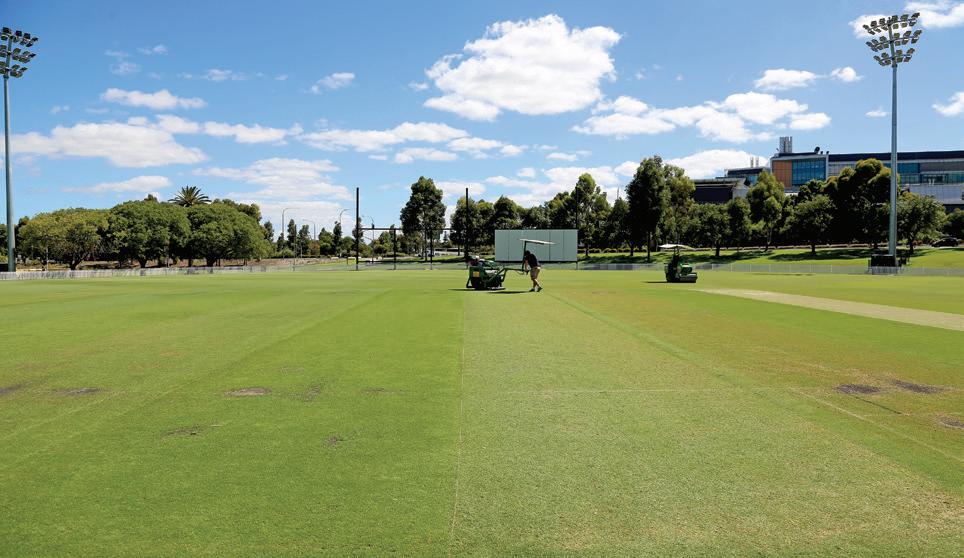
programs and preparations and ultimately got comfortable with the nuanced approach to managing the drop-ins.
“Being patient with them was key,” reflects Kelly. “As Damian told us, if you think you want to cut, hold back and keep encouraging the grass to grow and don’t be afraid to leave grass on them. Getting the moisture levels perfect ahead of the first roll was also critical and getting your timings spot on and being
really patient with what you were wanting to deliver. Damian was a great mentor and support throughout this whole process, as were all the Adelaide Oval staff.
“We managed the drop-ins similar but slightly different. They had their own dedicated turf nutrition program which was more liquids based. In saying that, we actually started to implement that approach more on the natural wickets as well because we were seeing such

MAY-JUNE 2024 13
The two Santa Ana couchgrass drop-in wickets (pictured) were used multiple times during last season, including for the West Indies Tour warm-up match against Australia A prior to the Adelaide Oval Test in mid-January

great results with the drop-ins. As a result, we saw some better recovery with the natural wickets so continued on with those programs. Certainly the more time and effort we were putting in, the more we were learning and the better we were getting at managing them.
“As part of that we also started introducing regular testing – moisture levels, bulk density – throughout our preparation processes and working on getting the right range of readings so that we had a bit of science to back up what we were doing. We followed similar practices as Adelaide Oval, with Damian helping us to make sense of the data we were collecting. It was all about making sure that the compaction was consistent through the whole profile and getting good bulk density readings which give you good bounce, carry and consistency.”
A RETURN ON INVESTMENT
With the first season under their belt, if you ask Kelly whether the drop-in experiment has been worth it and you will get an emphatic ‘Yes!’. Their addition has ticked numerous boxes and Kelly is looking forward to their second season and building on the successes of last summer. At the end of March, the two drop-ins were removed from the ground and transported
to the large practice facility which resides in between Karen Rolton Oval and Park 25. There they were renovated with a topmaker before being put on a steady nutrition program to get them as healthy as possible heading into winter. Two sand trays, which had been installed in the practice facility over summer and which utilise a new tray design that Hough has developed, were placed in the main oval ahead of the start of the local AFL season.
As well as providing SACA with better quality wickets and greater flexibility, one of the real pleasing aspects of having the drop-ins is how it has kept Kelly’s team engaged and helped to develop their skills. Assistant Ryan Schimanski (who came across from Adelaide Oval in late March), senior curators Glenn Lehman and Patrick Dewhirst, turf operations lead Dylan Fry and third year apprentice Archie Nielsen (son of Tim) have been all worked on the drop-ins at varying stages and can now add those skills to their resumes.
“To the best of my knowledge, it’s something that hasn’t been done here before,” states Kelly of their combined drop-in/natural wicket table. “I’m not sure if there would be many other venues around the world that would have a couple of drop-ins alongside six


natural wickets. We basically had a problem and needed to come up with a solution. We came up with as many different ideas as possible and discussed them before arriving at the same conclusion that, in this case, drop-ins were the best solution.
“A lot of credit has to go to Damian for the confidence he had in saying that it could be done and let’s do it. The way that he and his team and my team worked together for that 12-month period to deliver the project was amazing. It spoke volumes about both teams and how they collaborated to see such a large project through to fruition.
“It has been a huge learning curve for everyone, myself included. I had only done bits and pieces on drop-ins before but hadn’t really got into the science of how they were managed and prepared. When you are dealing with something new, you are always a little nervous to start off with. You have confidence around your ability, but you are a little anxious of what the outcome will be. After what we have been able to do and what the past summer has brought us, I think it has been successful and will only get better as we become more efficient with our processes.
“For the crew, the interest and investment has been really high as they are working with something that is new and different which is furthering their professional development. They now have an understanding of the different requirements managing drop-in wickets which is helping to make them better and more rounded turf managers. It has been really exciting to be involved in this whole experience and SACA deserves huge credit for being so supportive of it and allowing us as turf managers to showcase our skills.”
The addition of the drop-in wickets has been exciting for the Karen Rolton Oval team of six. Understanding their different requirements and management has helped to further their curatorial skills
14 AUSTRALIAN TURFGRASS MANAGEMENT 26.3 CRICKET
Increased diagonal rolling has been one of the key differences for the crew when it comes to preparing the drop-in wickets compared to the natural wickets. Pictured left is turf operations lead Dylan Fry using a pedestrian roller on one of the drop-in wickets, while third year apprentice Archie Nielsen (right) rolls one of the natural wickets








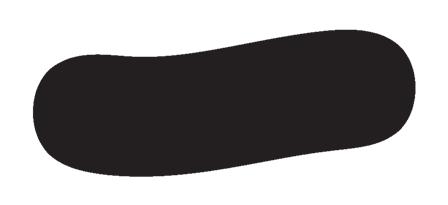


restoredCharacter

It has been a long haul for Commonwealth Golf Club in Melbourne which after plenty of investigation work, due diligence, research reports and many tough discussions, decided to embark on a course restoration project well before I started at the club in mid-2022. Following on from my report covering Stage 1 works that appeared in ATM Volume 25.2 (March-April 2023) – ‘Character building’ (pages 28-31) – we have since completed Stage 2, with the restored southern end holes open for play in early March 2024.
To briefly recap some of the details from that first article, it was in 1926 when Commonwealth captain Charles Lane travelled to the USA to spend time with Walter Travis and Joe Kirkwood before venturing across to the UK where he spent further time with Harry Colt to gain a better understanding of the fine art of golf course architecture. Lane returned to Commonwealth and commenced a full rebuild later that year. In classic ‘push-up’ style, the greens were based on the excavation of bunker material onto the green areas.
Between 1934 and 1938 Sloan Morpeth redesigned and built all 18 greens and tweaked many bunkers to create angles that rewarded those who could place their ball nearest the hazards to gain a good line for their proceeding shot. Until the recent restoration work, most of Commonwealth’s greens had remained largely unchanged, with the exception of some redesign work in the early 1990s to greens 1, 7, 10 and 12.
Commonwealth Golf Club course manager Adam Lamb looks at the second stage of their course restoration project which was completed earlier this year.
In 2019, all areas of the course were reviewed and many reports compiled to pinpoint the required work to elevate the course and reinstate Commonwealth’s true character. Tom Doak’s Renaissance Golf Design was appointed in 2020, with Brian Slawnik the principal architect for the impending works. A vegetation master plan was also identified as an area that required attention to raise the aesthetic appeal of the course, with Harley Kruse commissioned to prepare a Vegetation and Landscape Principals and Guidelines document.
With the course restoration work a focus, the vegetation document was adopted by the club. It has not only been used to help the course management team and committee decisions, but has also guided the planning process by the club’s vegetation architect Paul Mogford who has worked closely with Brian. Together they have created opportunities specifically between holes that have ultimately enhanced the course character with unique vegetation that is specific to the Ecological Vegetation Classes of our property.
STAGE TWO WORKS
The course restoration works were divided into two stages, with nine holes remaining open and in play for members during each tranche of works. Stage 1, which focused on the northern section of the property, began in August 2022 with the restored greens reopening in February 2023. Stage 2, which involved a lot more architectural changes, kicked off in September 2023 with the new greens open for play in March 2024.
McMahons were our again our earthmoving contractors and utilised survey data and their UTS equipment to ensure greens contours and slopes were reinstated. This was seen as a critical detail by Brian to maintain the character of Commonwealth’s greens. He made only a few very subtle changes in Stage 1, but ramped that up in Stage 2, in particular with the redesign of greens 1, 7, 10 and 12 (more on that below).
An average depth of 600mm was removed from each green and two-metre collar and a new 450mm sand profile imported. The sand base beneath the greens was pretty much the pure native sand. Sam Myott (STRI) assisted the club to source a suitable sand for the new greens. Burdetts were the recommended supplier who could meet the sand specification drainage rate range of between 100-150mm/ hour. Other aspects of the sand considered were particle shape and size. The Burdetts sand was fairly angular and had a silt/clay content around 1-2 per cent (a typical Sandbelt type sand is around 2-4 per cent).
16 AUSTRALIAN TURFGRASS MANAGEMENT 26.3 RESTORATIONS
PHOTO:
DAVID SCALETTI
Opposite: Commonwealth Golf Club’s 1st green and approach received a major makeover as part of Stage 2 of the recent course restoration works
Other contractors involved in Stage 2 works included Think Water which installed our new irrigation system and a second pumping station for fairways, tees and surrounds. A new Rain Bird IC and CirrusPro control system was installed with a mix of 700, 900 and 8000 Series heads. Australian Seed and Turf undertook all hydroseeding and supplied and laid large areas of Santa Ana. Melbourne Tree Works and McLeod Tree Services removed the council approved trees and grinded stumps, while Draslovka Services fumigated the practice putting and chipping greens.
Brian arrived back on site in lateSeptember 2023, around two weeks after McMahons had begun moving earth and one month after the irrigation installers started their works. He spent a day or two reacquainting himself with our property and got over his jet-lag, which was aided somewhat by riding a high on the solid start made by his successstarved Detroit Lions in the NFL.
Right: The Commonwealth greens restoration process. Top row (l-r) ripping up the old greens and preparing the sub-base; middle row (l-r) final surface prep and hydroseeding Pure Distinction; bottom row (l-r) growth mats going down and germination (9th green)
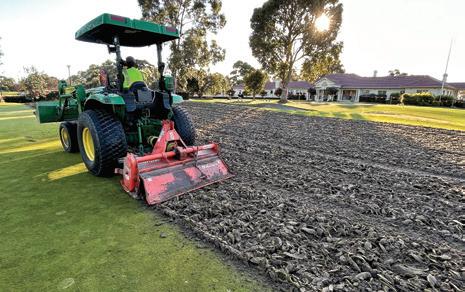
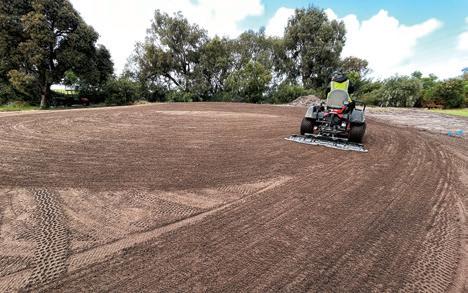









MAY-JUNE 2024 17
PHOTOS: ADAM LAMB


New fairway edges were soon marked out which allowed the irrigation mainlines to be finalised. Learning a good lesson from Stage 1, we didn’t spend too much time trying to anticipate how wide the fairways were going to expand or where they were going to be linked before installing irrigation mainlines or laterals.
McMahons had demolished all green sites before Brian arrived which worked out really well and expedited the process. This gave him a clean slate to work with on the greens and fine tune sub-base detail efficiently. McMahons could re-survey the base and move the new sand, which was already stockpiled onsite (more on that below), to the green sites.
CATCHING A BREAK
After terrible weather throughout the spring of 2022 during Stage 1 works, the weather gods squared the ledger in Stage 2 and we really couldn’t have asked for better conditions throughout the past spring and early summer. The weather was pretty much perfect which created ideal growing conditions. We had
good warmth from mid-September 2023, regular rainfall (which, importantly, was steady over long periods and didn’t come in short, heavy bursts), light winds and mild nighttime temperatures. Having experienced two contrasting years, although the work eventually gets done regardless, it certainly confirmed how much of a role the weather plays in making life easier or harder when undertaking major course works.
Although a dry spring/summer had been forecast, frequent and steady rainfall kept the topsoil moist and the onset of early warmish weather was very much welcomed. That was not only beneficial for the new areas being worked on, but we had nursed plenty of immature Santa Ana couchgrass laid the previous summer through what seemed to be a reasonable Melbourne winter. It took a lot of stress off to see the turf we had laid last season starting to grow by the end of September, which allowed us to focus on Poa annua control with herbicides without setting the Santa Ana back.
As well as the weather coming to the party, we were also able to take plenty of lessons from Stage 1 and put them into practice and plan accordingly for Stage 2. The timing of sand deliveries in Stage 1 had created some delays and was an issue at times, so for Stage 2 we made the logical decision to prepare for the delivery of 7000 tonnes of construction sand prior to the excavation works.
We closed the 10th hole four weeks prior to Stage 2 works getting under way and used it as a staging area for machinery and sand deliveries. Access was easy from Old Dandenong Road through the old maintenance shed gates and entry roadway. All testing of the sand was undertaken at the Burdetts quarry by STRI and as it was approved in 500-tonne batches it was then delivered to us. Growth mats were again used on our newly-seeded greens, which provided good insurance during Stage 1.
A ‘TRIO OF GREENS’ AND A RE-IMAGINED 1ST
As mentioned, the Stage 2 works comprised some much larger architectural changes to the southern end of the course, with the most significant occurring to greens 7, 10 and 12. Although not too far apart prior to works commencing, the three greens were previously separated by vegetation and the old maintenance facility (see 2017 aerial photo above). As part of the restoration works, the three greens complexes have been redesigned and pushed closer together (see 2024 aerial photo left). They are now identified as our ‘trio of greens’, creating a connection that is very common throughout the northern section of the course where we have a number of paired greens or ‘duos’ – 2-17, 3-16, 4-14 and 5-13 – that sit within the same complex and are interconnected by short-mown surrounds turf.
Prior to the changes made in the early 1990s, the 7th green sat on a left-to-right orientation with a single long bunker flanking the right-hand side. The new 7th has returned to this original orientation, with a bunker to the right and a moderate swale incorporated on the left. The green falls away at the back right corner and the opening to the green is tight. A tee shot that is off line will fall into the swale left or end up in the bunker on the right.
Nearby to the 7th green, Brian sensed that the 10th and 12th greens required a new look. The 10th is a 501-metre par five and although the green was shifted back by around 20m, the approach bunkers remained in place. That encourages the golfer to carry these bunkers and potentially run their ball onto a horseshoeshaped green which is now guarded in the front middle by a small deep bunker. In true Commonwealth style, the new 10th has a generous slope from the back left corner to the front right corner.
18 AUSTRALIAN TURFGRASS MANAGEMENT 26.3
RESTORATIONS
Aerial photos from 2017 (top) and 2024 (above) showing the change to Commonwealth’s ‘trio of greens’ – 7 (to the left), 10 (to the right) and 12 (middle). The three greens have pushed closer together creating a connection that is common throughout the northern section of the course
PHOTOS: NEARMAP
Similarly, the new 12th is guarded at the front left and right by deep penalising bunkers, a ridge running across the green that slopes towards the front and slopes away to the back left quarter of the green. There is also a tight pinnable area just over the front right bunker.
The 1st green and approach also received a major makeover as part of Stage 2 works. Commonwealth’s original 1st hole was a short, driveable par four that measured just over 230m, with its main defence being the slopes on the green. Although well regarded as a “gentle opener”, in 1990 the view at the time was to strengthen it, with the green pushed back and right to a distance of just over 290m.
Both Tom and Brian were keen to reinstate the 1st green in its original location, but due to a concern regarding the location of the nearby 2nd tee and a large number of well-established eucalypts, the suggestion to rebuild in this area wasn’t possible. Brian landed on an area which was essentially the midway point between the two former green sites which brought it back to a length of 250m (see photos above and right) Considering the advancements in technology over the past 30 years it is fairly comparable to the hole’s original distance.
Before Brian went to work on the new green, he used old photographs and picked the brains of several members who could

recall the original character of the green. What Brian came up with, in the eyes of those who well remember the original 1st green, is a fantastic recreation of one of the classic original holes at Commonwealth.
Elsewhere, the 6th and 11th greens, notorious for their severe slopes, were softened a touch. The front of the 11th green was also tweaked to allow for more pin placements in the front half. The 19th green, which is located on the right hand side of the 10th hole about half way down, was also redesigned (the 10th is split into two holes –10A and 10B – when the 19th is in play.)


MAY-JUNE 2024 19
PHOTO: NEARMAP
Top and above: The site of Commonwealth’s new 1st green is essentially at the midway point between the two former 1st green sites. It has brought the hole back to a length of 250m and is more reflective of the original design
RESTORATIONS
CHARACTER BUILDING
In addition to the course’s character being reinstated, one of the pleasing aspects of the project has been seeing the development of the course team. Heading into Stage 1 works we only had a limited number of staff with major construction experience. Heading into Stage 2, we had 15 staff who had gained significant experience during the previous year.
Their efficiency and eye for detail during Stage 2 was greatly enhanced, especially on works such as bunker edge construction, shaping areas and preparation for turf to be laid, as well as the transition areas between new and existing turf. They also developed a greater understanding and appreciation of how much care and nurturing is required with newly turfed and seeded areas. Assistant course manager Scott Fullarton and our two foremen, Kerrod Tuckett and Tom Carroll, worked long hours and supported the staff incredibly well to achieve fantastic results.
Vegetation work has also continued full steam ahead over the past 12 months, with the club committee resourcing this area appropriately to ensure that the vegetation complements the course restoration work. Our vegetation manager Samantha Butler has two apprentice staff as well as a weekly member working bee crew of 8-12 people for 2-3 hours that assist with the mountain of work we have in front of us. We anticipate the vegetation will take at least five years until we have that predominantly ‘woody heathland’ look we desire. The club accepts that vegetation work will always be required going forward and will never be what some might consider a ‘low maintenance’ area.

As written in the first article, Pure Distinction bentgrass was chosen for the new greens and is performing well to date. Considering it can accumulate thatch fairly quickly, we are very conservative in our nutrient applications. We were probably a little too lean early in Stage 1, but from experience last year we have found that light and frequent applications have given us the best results. Applications every 3-4 weeks are providing good, balanced and steady growth.
The members have been ecstatic with the new greens and the sharp clean look that we have from the green edges that are cut to the bunker edges. From what most of our members have experienced at other clubs, such as Peninsula Kingswood and Victoria which were among the first to use Pure
Distinction, their expectations are high. I’m not sure we have our greens quite to the same level yet, but we’ll keep working on them. As the Pure Distinction matures we expect the surfaces to improve with age and the turf will build a good resilience to the high golfing numbers that we are currently experiencing.
In closing, I would like to acknowledge the Commonwealth Golf Club committee for having the foresight and determination to complete the course restoration project and selecting Renaissance Golf Design. It has been a pleasure working with Brian Slawnik and Tom Doak over the past two years. Brian is certainly brilliant at what he does, clearly has a great appreciation for our property and most importantly has restored elements of the course perhaps lost over many years.

20 AUSTRALIAN TURFGRASS MANAGEMENT 26.3
Commonwealth’s new Pure Distinction bentgrass greens are dusted every three weeks to keep thatch levels diluted
PHOTO:
GARY LISBON
The restoration works have elevated the Sandbelt course and reinstated Commonwealth’s true character. Pictured is the par three 15th

complete Karratha

In September 2022, Karratha Country Club in WA opened its redeveloped course with brand new Velvetene paspalum greens that replaced the existing sand scrapes. For turf manager Callum Hitching and his company Turf Life, the project threw up many challenges, but it has ultimately had a very positive impact on the club.
There’s a well-known saying that ‘good things take time’ and if there is one golf club membership in Australia that can fully appreciate such sentiment it’s Karratha Country Club. Located in the Pilbara region of Western Australia, some 1600 kilometres north of Perth, the course was established in the early 1970s. In addition to sand scrape greens, for the first 20-odd years golfers would tee up on sand fairways until the installation of an irrigation system in the late 1990s meant that they could do so on grass.
It was around 2010, during a very large upsurge in mining construction, that local golfers felt the town had the population capacity and the need for a higher standard of golf facility that fit with the City of Karratha’s vision of being the most liveable regional city in the state.
After much deliberation and coercing from a small but dedicated band of golfers, the local government executive agreed to gain approval from councillors to pursue the business case and seek state and federal government funding to deliver some major upgrades to the existing maintained sand scrape course.
Multiple masterplan options were developed by Richard Chamberlain Golf Course Design (RCGCD) with the final one adopted in 2013 seeing the construction of some new holes and redirecting of other fairways to improve the layout and playability. Works would also see the installation of a new irrigation system and pump station designed by John Pryor’s Hydrogold and Hydroplan respectively and additional water storage.
The big ticket item, however, was converting the sand scrapes to grass.
Becoming the first golf club in the Pilbara region to introduce grass greens was no mean feat. The nearest grass green courses were in Kalbarri, about 1000 kilometres south, and Broome, about 800km north. There were plenty of detractors who believed it wasn’t possible to keep them alive or create any kind of surface worthy of play. Ultimately, they’d be proven wrong.
TIME FOR CHANGE
In July 2014 the City of Karratha put out to tender a ‘project supervisor’ role to oversee the various improvements planned for the golf course. At the time I was superintendent at
Busselton Golf Club in southwest WA and was encouraged to throw my hat in the ring. This was no ordinary ‘send in your resume’ type gig and involved a detailed tender document which was something I hadn’t done before.
Rolling into August, I had, as most turfies do, planned a winter escape to recharge ahead of a busy spring period. I was heading off on a boys’ trip barramundi fishing based out of Kununurra in the Kimberley. Being super organised, the three-hour plane trip from Perth was spent on the laptop furiously pumping as much weight into my tender submission as I could muster. In hindsight it would have been a lot less stressful if I had done it all before leaving, but where’s the fun in that?!
Arriving in the town known for Lake Argyle and diamonds, I was greeted by a 4WD full of primed mates with rods at the ready which made for a quick change of mood as we headed straight out for an afternoon flick.
D-day was two o’clock the next afternoon and after prioritising a decent internet connection and ensuring the zipped folder had the right amount of sub-folder attachments labelled just how they asked, so as not to be dismissed on a technicality, I hit the ‘Send’ button.
22 AUSTRALIAN TURFGRASS MANAGEMENT 26.3 REDEVELOPMENTS
PHOTOS: REILLY HITCHING/CALLUM HITCHING
Opposite: Karratha Country Club became the first course in WA’s Pilbara region to have grass greens following a multi-year project to convert the old sand scrapes. Pictured is the 7th green with Nickol Bay in the background
By mid-week, City of Karratha project manager Geoff Shoemark was in touch to organise a phone interview. Being a boys’ trip we had plans and after laying out our itinerary to Geoff I was left with no exact timing for our next catch-up. Our planned trip to the coast for some exploration of Cape Domett and Carlton Hill Station was due to start when our local tour guide finished work early on the Friday. Blow me down if I wasn’t having a phone interview about the Karratha golf course with a City director, project manager, multiple scribes, golf architect and a few golf club members midafternoon that Friday having only been given 20 minutes’ notice! Within the space of a few weeks my company ‘Turf Life Pty Ltd’ was born and we were about to head north.
A CHANGE OF PLANS
The Karratha course is located within a kilometre of the city CBD. Holes weave through the primary and tertiary dune systems parallel to the mangrove-lined tidal flats of Nickol Bay and the remnant ‘Gum’s Swamp’ cattle holding yards of the old Karratha Station. It maintains an abstract coastal desert links feel, with amazing ocean and Burrup Peninsula views to the north, while vistas south include stands of Eucalyptus victrix, the township itself framed by large hills of varying sized red oxidised boulders and pale green spinifex grasses. This combination makes for some amazing colours as the light transitions at both ends of the day, especially during summer when the odd thunderstorm pushes up from the south.
As is the cyclical nature of mining and construction projects, when we arrived in Karratha in mid-September 2014 the local economy was starting to decline. The major grant program of the time, ‘Royalties for Regions’, was on the wane and I was soon informed that the project had not received full funding to complete both the irrigation system installation as well as the capital construction phase as planned. Needless to say it was a real kick in the guts, especially after uprooting the family from down south.
That news necessitated a revised game plan, while a few things continued as expected. In the first two weeks we built a 400m2 warm-season greens grass trial plot. Two local soil types (the native golf course soil and a local dune sand) and two blends were imported for the plots which also contained a few amendments. Four grass types – Santa Ana and Tifdwarf couchgrass and Saltene and

Velvetene seashore paspalum – were planted, making for a total of 16 plots. Velvetene gave the most favourable results – it established quickly, was tolerant of the course’s effluent water and provided a smooth surface with minimal inputs.
With limited immediate construction planned, the focus shifted to overlaying the irrigation design to fit with the future planned green designs from the masterplan and keep irrigation uniformity over the current sand scrapes to ensure the new system would service both during the construction phase.
That first summer (2014/15) was long and painful nursing through an aged irrigation system with very brittle mainlines that would split full length on occasions. Leaks were common and frequent. The old system used
a Signal controller and Bermad valves into blocks of up to 10 Rain Bird 8005 sprinklers. Station flow rates were largely unknown which made it hard to program the controller to make it as easy as possible for the one VSD and two full speed pumps to operate effectively. After a couple of months of extremely painful results, I started to irrigate manually without the controller and ramped up and shut down the system gently, minimising mainline damage but working some strange shifts to ensure the course was watered well in the interim.
Between February and March 2015, Total Eden and Hydrogold were charged with the installation and design of key irrigation infrastructure on site including;
l A new 600kL storage tank, doubling the capacity of the club’s storage to 1.1ML;
l A new pump station comprising 4 x 37kW Grundfos pumps and 18kW jockey pump;
l Two 1400L tanks with Grundfos injectors;
l 300mm mainline from pump station to first junction, incremental changes 200mm, 150mm and 100mm throughout the rest of the course;
l Three sprinkler blocks on fairways, Toro P220 50mm valves, Toro DT 34s;
l Valve-in-heads around greens, QCVs at tees and greens and at 60m spacings down fairways; and
l Several mainline take offs capped ready for future extensions if further development of the site required the rerouting of any holes.
ONE GRASS GREEN AT A TIME
After the irrigation works, we began some minor reshaping works as part of the RCGCD masterplan. As stated earlier, a large portion of funding from the ‘Royalties for Regions’ scheme had been denied at a critical point in the development, drastically changing the construction timeline. Battling on, we reshaped and realigned the 18th green and approach, moving it further from the clubhouse and

MAY-JUNE 2024 23
The Hitching family moved to Karratha in 2014 and experienced the highs and lows of the project. Pictured back row (from left) is Bob (Callum’s father, who is based in Exmouth) and sons Tyler and Reilly. Front row - daughter Jaime, Callum and wife Kelli
Importing the blended greens rootzone which is a mix of a tertiary dune sand and Pindan soil. Pictured is the 11th green

creating a mid-length par four finishing hole. The green was shaped and boxed out, with a greens blend soil imported and shaped to match the design contours in readiness for stolonising.
To remedy safety issues identified during the masterplan process, new 4th and 8th holes were created. Fairways, greens surrounds and putting surfaces on these two holes were shaped with a small portion of local sand retained as a sand scrape putting surface. Fairways and greens surrounds were stolonised with Santa Ana, while new tees were shaped and solid turfed with Santa Ana also. A new practice putting green was shaped up and greens blend soil imported ready for stolonising, while two par three fairways were sprayed out and stolonised with Santa Ana.
In June 2015, after confirming Velvetene paspalum as the turf of choice for the new greens, 100m2 (in rolls) was freighted up from Perth, verti-mowed on site, spread and shallow rotary hoed into the 18th green and putting green at a 1:10 rate. Given the turf arrived dormant, it was very slow to establish even in our warmer albeit mild winter. The application of supplementary nutrition was of limited assistance during this portion of grow in.

From that experience, future planting methods for greens were adjusted to better maintain surface contours and yielded improved results in establishment speeds and evenness in root development requiring less post-establishment plugging and topdressing.
After what had proven to be a busy first 12 months on site, the next two years (20162018) would prove to be very slow. During this time several tees were rebuilt with the usual criteria of making them larger, flatter and easier to maintain. Throughout this time a consistent approach to increasing the native vegetation was also taken, either by staking new germinations and planting endemic species of eucalypts and melaleucas (for shade at tees and greens) while ensuring we didn’t lose our linksy feel and become too parkland.
Maintaining the two grass greens to a high standard was a major focus at the time to show the end result and ensure there was still the energy and drive to complete the project. As grant funding had been lost, there was plenty of ongoing negotiations between the City of Karratha and the club regarding financial responsibilities and associated costs for maintenance of the grass greens. This was eventually finalised in a joint Memorandum of

Understanding where the City would cover the costs of construction and establishment of the new grass greens for a period of nine months from planting, with ongoing maintenance costs being covered by the club.
Using the RCGCD greens contour plans, we hired equipment and I began shaping some more greens, completing the 11th in August 2018, the 12th in April 2019 and the 13th in 2020. These greens were shaped to match the future putting surface contours but were kept as sand scrapes. This wasn’t the most popular decision among the members as the 11th is close to 40m wide and the 12th a similar length. Scraping for a 20m-plus putt is not a fun prospect or easy to get right!
After making some headway, in February 2020 things were brought to a dramatic halt when Cyclone Damien crossed the coast, with the eye making a perfect bullseye above Karratha. Wind gusts of over 200kph made a mess of the town and stripped the golf course of vegetation and sand. The scrapes were left in very ordinary condition and required a lot of work to make them playable. We had to bring a screen onto the course and mined several hundred cubic meters of the native dune sand to resurface them. By contrast, the 18th green
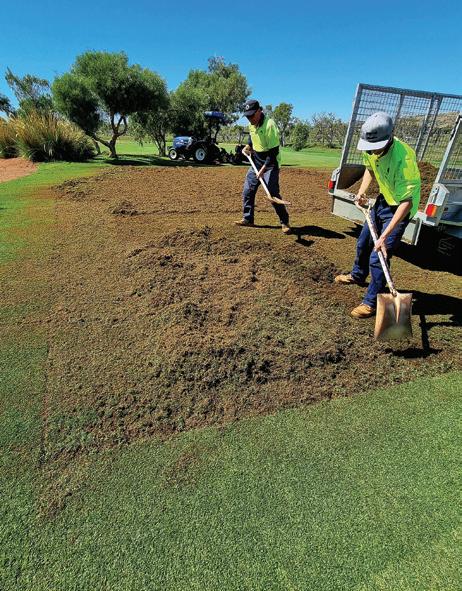
24 AUSTRALIAN TURFGRASS MANAGEMENT 26.3
REDEVELOPMENTS
Canine supervisors Narla and Marlee seem to have a particular affinity for the 16th green, both during and post construction. In the excavator (left) is Scott ‘Chicka’ King
The stolonised green and solid-turfed Santa Ana surrounds on the 17th (left) and harvesting Velvetene stolons from the putting green (right) to spread on the new greens
and putting green took just 15 minutes with a hand blower to clear any debris and they were ready for play!
FINISH LINE IN SIGHT
In February 2021 greens 11, 12 and 13 were excavated in-house, a soil blend imported and shaped to match the design contours. Due to availability issues with Velvetene in WA at the time, we were given permission to harvest from the established putting green and 18th green. The new greens surfaces were lightly raked and moisture levels maintained so as stolons were evenly spread on the surface we were able to wheel rut them in with a bunker rake to compact/combine the turf runners into the top 5mm. Short regular irrigation cycles followed to ensure establishment.
A few months later, in May, we completed the 14th fairway realignment and extension in-house. An area 100m in length and about 6000m2 of virgin ground was stripped and shaped. The mainline was extended and two new fairway stations, six valve-in-head sprinklers and QCVs were installed ready for final trim in June.
Richard Chamberlain and shaper Scott ‘Chicka’ King arrived on site in June as we stripped and shaped the 10th, 14th, 15th, 16th and 17th approaches, green surfaces

and surrounds. Every green was built with a different process as some, like the 14th, were virgin ground. With others, we retained the natural contours and boxed out the internal well of the green and made minimal changes to the surrounding contours.
Generally a process of cut and fill was completed to create the surrounds, which included recycling and/or burying the thatch generated when stripping the site. The depth and volume of thatch material varied and was located depending on proximity to the green
and also availability of head-to-head sprinkler coverage. Some areas received minimal sand capping to create a smooth finish while other areas saw thatch buried quite deep and the clean excavated soil used elsewhere.
Once the general shape was completed, the putting surfaces were boxed out to a depth of 250mm matching the projected surface contours. This clean native soil was used to enlarge mounding to enhance the shape of the surrounds and make the design pop a bit more.

MAY-JUNE 2024 25
Velvetene was chosen for its quick establishment, tolerance to effluent water and minimal input requirements

A local blended top soil that we chose combined a tertiary dune system from a quarry near Point Sampson called ‘Sam’s Creek sand’ with some Pindan (a red sand native to the Pilbara and Kimberley regions) which was imported into the green well. This was pushed out with a posi-track achieving consolidation in the process while still being able to easily see depths and match contour changes. Greens prep and final trim was done in-house with a Sand Pro 5040 and hand-dragged if required.
1000L bags of Velvetene stolons were ordered from Perth and would arrive in fair to average condition and were slow to wake up. The bags varied greatly from top to bottom – dry on the surface, some parts in the early stages of decomposition and yellow from a lack of light. We also had to contend with a massive weed load that arrived in the contaminated turf. A real mixed bag of weeds, from lupins to Poa and broadleafs, germinated within the first week. Many hours were spent hand weeding the green surfaces to minimise distress on the young Velvetene stolons and limit competition for water and nutrients.
The issues with weed load and a limited supply forced us to use our own 18th green and putting green for harvesting once again. The quality of the turf and speed of establishment jumped as there was generally only an hour from harvest to irrigation being applied and in some patches we didn’t lose any colour from the leaf at all.
By the time COVID hit, the project had started to gain some momentum and increasing golf numbers saw a push to get to the finish line. Of course this came with its own set of challenges with state borders being closed and extended periods of lockdown and isolation making it unviable to bring in a shaper to complete the remaining greens quickly.
In-house we once again tackled some additional holes, excavating the putting surface wells previously shaped on the 4th and 8th greens and completing a fresh design on
the 6th. Both the 4th and 8th needed subtle tweaking prior to final trim of the surfaces. After being shaped sand scrapes for a few years, wind had moved sand off the greens in areas by up to 200mm, raising finished contour levels in areas of the greens that were designed as exits for surface runoff in extreme rainfall events.
By March 2022 we had just six greens left to build (1, 2, 3, 5, 7 and 9). In-house we continued to remove turf from where the construction areas were, installed two additional fairway irrigation stations and 11 valve-in-heads for the 3rd and 7th greens which were relocated by about 40m each. These holes were lengthened slightly and in the case of the 7th we were able to make use of an excellent ridge line to perch the green upon (see main photo page 22), strengthening the hole considerably.
A COMMUNITY ASSET
In mid-September 2022 the redeveloped Karratha Country Club course was officially opened, bringing to a conclusion a project which was more than a decade in the making. In the near two years since, the new-look course has become a real hub for the local community and the club continues to go from strength to strength.
In recognition of all the hard work that the club and staff put in to the project, at the WA Golf Industry Awards this past March, Karratha Country Club won the Regional Golf Facility of the Year award, with the judges praising the “remarkable turnaround” in the club’s fortunes. During a standout 2023, notable achievements included a 61 per cent increase in revenue and a membership increase of 73 per cent.
Looking back on my involvement in this project, it’s not about the destination but the journey. Ten years is a long time to be attached to a project, but as it is in the regions you become part of the community and it is humbling to receive all the positive feedback about what has been achieved here. It was certainly a big call to take on this project all those years ago, but if you get the opportunity to step out of your comfort zone and do something completely different to the everyday norm, back yourself and have a go.
There were many people who assisted along the journey. To Scott ‘Chicka’ King and Richard Chamberlain, you both made it way too much fun to be called work. To the small but dedicated team of lads and ladies who worked with me during this process, thank you for providing your skills and dedication to delivering high standards. And thanks to the volunteers also. They are such a critical component to small clubs like Karratha and if you treat them with respect and make them feel appreciated they will always come and help and have your back. Turf laying is probably the least desirable job during construction and voluntary labour from the club saw over two hectares of turf cut, rolled and reused on site.
Above all, I could not have completed this project without the support of my wife Kelli and children Jaime, Tyler and Reilly, a crazy bunch of people who loved being in the middle of it all, whether that was helping to lay turf, installing irrigation or bringing food and drinks to the course and enjoying the exciting atmosphere that construction brings. The kids started out in primary school when we first arrived here and now we have just one left to finish high school this year. How time flies…

26 AUSTRALIAN TURFGRASS MANAGEMENT 26.3 REDEVELOPMENTS
Course architect Richard Chamberlain, who developed the Karratha CC masterplan, tests out the new grass greens
The course redevelopment (pictured is the 8th green) has given Karratha Country Club a new lease on life. In 2023, the club experienced a 61 per cent increase in revenue, with membership also up by 73 per cent












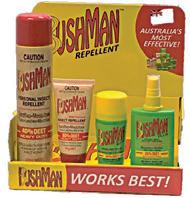











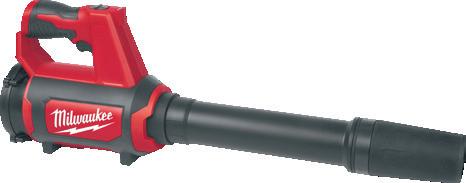



COMMERCIAL BATTERIES BULK OILS PERSONAL HOISTS CONSUMABLES SPARK PLUGS & BATTERIES OUTDOOR POWER TOOLS commercialenquiries@repco.com.au VIC Michael Sammons 0434 689 534 Brett Wright 0421 057 412 NSW/ACT Michael Hull 0413 090 111 Kelly Abraham 0437 020 829 WA Nat Eddy 0408 990 417 Wayne Mollenoyux 0488 491 400 QLD Tamazyn Kettleton 0437 215 110 QLD/NT Nic French 0434 601 296 SA Brian Jessett 0478 319 561 TAS Kelly Wilton 0478 312 911
HUSQVARNA COMMERCIAL ROBOTICS
Ready for your golf course challenges

Catch Erwan, Head Greenkeeper and Technology Specialist from WINSTONgolf, at the 2024 Australian Sports Turf Management Conference.
As a Keynote Speaker, he’ll be hosting two must-attend sessions packed with cutting-edge insights into turf care innovations. Don’t miss out on learning from a top industry expert!
Wednesday 19 June | 9.50 – 10.30 am
Data collection and technologies for golf course management
Thursday 20 June | 9.10 – 9.50 am
The role of automation and electrification in sustainable turf care management
Sessions are proudly sponsored by Husqvarna. ERWAN LE COCQ

At the 2024 Australian Sports Turf Management Conference: Stand #24
+ + VISIT US

PERFECT CONDITIONS, EVERY MORNING
Wouldn’t it be nice to arrive, each morning, to a freshly cut turf? A fairway or semi-rough that’s cut in a way that – compared to conventional petrol and diesel machines – saves on equipment and maintenance expenses, and that produces zero CO2 emissions during use? With Husqvarna CEORA™ robotic mowers you get a freshly cut golf course every morning, every day.
If you would like to speak with a Husqvarna representative, scan the QR code to book a consult now.
BOOK A CONSULT
Brisbane Welcome to

For the second time in six years the Australian Sports Turf Management Conference and Trade Exhibition returns to the warmer climes of Brisbane, Queensland.
The Australian Sports Turf Managers Association (ASTMA), in conjunction with Golf Management Australia (GMA), welcomes delegates to the Brisbane Convention and Exhibition Centre which will play host to the industry’s biggest gathering in 2024. This year’s conference is along similar lines to the highly successful joint venture between the two organisations in 2022 (Melbourne) and we again look forward to the collegiality and collaboration that a combined event of this magnitude generates.
Like Melbourne two years ago, this year’s education component will again include separate ASTMA and GMA content, but also provide the opportunity for both groups to come together for a number of joint sessions. This includes the opening day’s Plenary session which includes a compelling line-up of industry experts and inspirational presenters.
Over the next 18 pages, ATM takes a look at some of the major speakers and highlights of this year’s education sessions, previews the ASTMA Golf Championships which will be played at Australian PGA Championship host venue Royal Queensland and profiles the Graduate of the Year Award finalists. From pages 38-43 we also feature some of the trade exhibition highlights along with a full list of exhibitors and floorplan so you can plan
ATM previews the 2024 Australian Sports Turf Management
Conference to be held in Brisbane from 17-20 June.




your visit across the two-day trade exhibition (Wednesday and Thursday).
On behalf of principal sponsors Toro and Schweppes and conference partners Syngenta and Husqvarna, the ASTMA and GMA thank you for your attendance at this year’s event and trust you get plenty out of the week.
DR JAY MCCURDY
The first speaker confirmed by the ASTMA for this year’s conference, Mississippi State’s Dr Jay McCurdy (pictured left) is an associate professor and extension specialist in the university’s Department of Plant and Soil Sciences. Jay received a Bachelor of Science degree from the University of TennesseeMartin, a Master of Science degree from the University of Tennessee-Knoxville and a PhD from Auburn University. He has worked as a golf course superintendent, turfgrass sod producer and private consultant. His current research projects include precision assessment of turfgrass growth and development, weed ecology and management, herbicide resistance (including the USDASCRI-funded ResistPoa Project) and wildlife habitat inclusion within the built environment.
Jay teaches and advises students studying weed science and turfgrass management. He has authored more than 50 peer-reviewed publications as well as numerous trade journal and extension articles. He provides leadership for the Mississippi Turfgrass Association and Louisiana-Mississippi Golf Course Superintendents Association. He serves as an
30 AUSTRALIAN TURFGRASS MANAGEMENT 26.3 BRISBANE 2024
PHOTO: STOCK.ADOBE.COM/MEL CAMPBELL
Dr Jay McCurdy is an associate professor and extension specialist with Mississippi State University
editor for the Mississippi Turfgrass Magazine and was an associate editor for the Crops, Forage and Turfgrass Management Journal.
Jay will be making a number of presentations across the week in both the Golf and Sportsfield streams and will also team up with Envu’s Jyri Kaapro and AGCSATech senior agronomist Bruce Macphee for a Wednesday morning workshop exploring the development of weed management programs in warm-season grasses.
ERWAN LE COCQ

Frenchman Erwan Le Cocq joins this year’s conference direct from WINSTONgolf in Germany, a 45-hole complex located just over two hours northwest of Berlin. Erwan is a seasoned greenkeeper with nearly 15 years of experience in the golf industry, holding multiple managerial roles across various European countries. For the past six-and-a-half years he has served as head greenkeeper/technology specialist at WINSTONgolf where he oversees the implementation of technologies to improve the day-to-day maintenance of one of Germany’s largest and leading golfing facilities.
WINSTONgolf comprises two 18-hole championship courses and a nine-hole par
FROM THE PRESIDENT…

Itake great pleasure in welcoming delegates to the 2024 Australian Sports Turf Management Conference and Trade Exhibition in Brisbane. Once again we partner with Golf Management Australia (GMA) to combine our education sessions and trade shows to make it the biggest golf and sports turf management conference to be held in Australia this year.
ASTMA chief executive Mark Unwin and the ASTMA team have done a fantastic job in procuring highly credentialled international presenters and local experts to stimulate and challenge our thoughts on why we do what we do. The Sportsfields and Technicians streams also add to the diversity of content to cater for delegates.
The sold out trade exhibition is also testament to the strong support we receive from our industry trade partners and I am sure there will be something for all as you move through the trade show floor. I thank all our trade partners for then continued commitment and support of our association.
I am also looking forward to hosting the National Turf Industry Awards Dinner, sponsored by Syngenta, where we showcase outstanding achievements in our profession from across the country. It is a great way to start conference week and a fantastic opportunity to reunite with our peers and acquaintances to talk all things turf.
It is a significant exercise to run an event such as this and we certainly couldn’t do it without our principal sponsors Toro and Schweppes and our conference partners Syngenta and Husqvarna. I would sincerely like to thank them for their continued support of the conference and our industry in general.
I am looking forward to an exciting week in Brisbane and hope that you all enjoy the educational component as well as the camaraderie that comes with an event such as this. Enjoy the week and I look forward to seeing you there.
Ben Tilley Superintendent, Headland GC President, ASTMA

MAY-JUNE 2024 31
three course. Erwan has been at the forefront of innovation at the club, leading the charge in the integration of robotics, drones and sensors as part of day-to-day course operations. WINSTONgolf is one of the first courses in the world to embrace and deploy autonomous mowers on a large scale, with 123 robotic mowers included as part of their maintenance fleet. In addition to autonomous mowing, Erwan also employs a range of digital and technological tools to help with data collection and management of the course, including drones and soil moisture sensors. Erwan will be delivering presentations on both of these aspects while in Brisbane.
DR JULIETTE TOBIAS-WEBB

One of Australia’s leading behavioural scientists, Juliette Tobias-Webb has a PhD in Experimental Psychology from the University of Cambridge. She enjoyed stints as a lecturer and research officer at globally-renowned institutions including the University of British Columbia, the University of Sydney, Bond University and Kaplan University. She has also published a number of journal articles in leading psychology and neuroscience journals. She currently teaches an evidenced-based MBA leadership course that covers topics such as empowerment, motivation, resilience, wellbeing and equality through organisational design.
Juliette is passionate about working with companies and researchers to design and rigorously test solutions that encourage positive behavioural outcomes. She specialises in large scale behavioural change and in designing for individuals facing more complex cognitive situations (mental health, addiction, cognitive decline). She is also passionate about helping individuals be more productive, set and stick to goals, have better wellbeing and feel happier.
Her Plenary session address will focus on understanding and using behavioural evidence of teams to explore complex leadership issues and assist workplaces to develop practical and innovative solutions to improve performance.
ADAM SPENCER

For over two decades, Adam Spencer has been one of Australia’s best and foremost speakers, delivering cutting edge conversations with an attention to detail and passion that stands out as a hallmark of his intellect and style. As one of Australia’s most dynamic and engaging minds, Adam is informative, fun and guaranteed to impart takeaways you’ve never heard before.
Adam’s greatest strength is his versatility. With an extensive background in mathematics, he is particularly strong in presenting on

topics such as science, technology and digital innovation. Humour and intellect is a rare combination that Adam has in spades. He loves curating challenging and thoughtprovoking conversations to engage his audience – skills learnt from over 25 years’ experience in television, radio and events, interviewing Prime Ministers, Hollywood stars, Fortune 500 CEOs, Nobel Prize-winning scientists and Australians of the Year. Through his own unique and entertaining style, Adam will present on how digital transformation is changing business operations and how we can adapt to and embrace emerging technologies.
CLAIRE MADDEN
Fostering an engaging culture and building multigenerational teams has become a key skill for leaders as they negotiate a changing world, where creating a vibrant and dynamic workplace is key in attracting and retaining top talent. As an author, social researcher and media commentator, Claire Madden (pictured above) has become one of the world’s leading voices on Generation Z and is in high demand as an expert interpreting social trends, demographics and the implications of generational change on the workplace.
Highly regarded for her dynamic and engaging presentations, Claire can easily translate robust, research-based content into strategic applications for managers and leaders. She has been commissioned by some of Australia’s largest companies and leading brands to interpret the changing landscape and communicate the implications for business and society. From embracing a culture of collaborative innovation through to creating ownership around a shared purpose and vision, Claire will present on the keys to facilitating greater engagement across multigenerational teams, with an extensive array of takeaways that can be easily implemented in workplaces.
OLLY BRIDGE

Dedicating his life to helping individuals and teams unleash their full potential and achieve extraordinary results, Olly Bridge has forged a career working with elite athletes. He has harnessed the power of sustainable peak performance and honed it into a dynamic methodology that extends far beyond the sports arena. Through leading high-performing teams in organisations like BMW and Medibank, driving smaller start-ups to successful exits and being COO of a joint ASX- and NASDAQ-listed health tech company, Bridge has a deep understanding of the corporate landscape and the balance between performance and wellbeing.
CAMERON SCHWAB

Those who attended the 2019 conference in Brisbane will recall the riveting presentation that Cameron Schwab gave to round out that year’s Plenary session which drew widespread praise. We are delighted to welcome Cameron back in 2024 who will bring his wealth of knowledge and experience to speak on what businesses can learn from elite sport. Cameron was appointed chief executive of Richmond Football Club at age 24, the youngest in the history of the game. He then spent the next 25 years as the chief executive of three AFL clubs, the second longest serving in the modern game. He believes that creating an environment that enables teams and organisations to access the full range of their capabilities is an important component to a successful organisation.
MARK CARTER

A conference favourite, Mark Carter has been a regular keynote at past events and will again kick off this year’s Plenary session with a presentation on effective leadership. Mark is an international keynote speaker, trainer and coach who has worked with the ASTMA over a number of years doing roving and conference workshops and more recently the Future Turf Managers’ Initiative. He has over 25 years’ experience as a global learning and development professional and works as an inspirational international speaker. For anyone that hasn’t experienced one of his keynotes before, they are not to be missed.
ELSEWHERE IN THE PROGRAM…
l Presentations from last year’s ASTMA Award winners – Craig Walker (Devonport CC, Excellence in Golf Course Management Award); Nick Marino and Paul Locke (City of Boroondara, Team of the Year); and Lachlan Roache (The Gabba, SF&G Graduate of the Year).
32 AUSTRALIAN TURFGRASS MANAGEMENT 26.3
BRISBANE 2024
Claire Madden is a leading voice on Generation Z and implications of generational change on the workplace

l The Lakes Golf Club superintendent Anthony Mills looks back on preparations for last year’s Australian Open tournament.
l Local sports turf managers Matthew Oliver (Suncorp Stadium) and David Sandurski (The Gabba) look at the management
of their facilities, with Oliver to reflect on hosting the FIFA Women’s World Cup.
l The theme of sustainability will feature prominently, with Chris Gray and John Kemp presenting on The R&A’s Carbon Capture research project, while Monina Gilbey and Kate Torgersen will look at ways to reduce roadblocks on a turf facility’s journey to sustainability.
l Presentations on ERI fungi and invasive pest threats such as army worm and fire ants.
2024 AUSTRALIAN SPORTS TURF MANAGEMENT CONFERENCE PROGRAM
MONDAY 17 JUNE
9am: 2024 ASTMA Golf Championships (presented by Toro Australia). Buses depart Brisbane Convention & Exhibition Centre (BCEC) 7.30am. Royal Queensland Golf Club
12pm-4pm: Registration desk open. BCEC Foyer
6.30pm-10.30pm: Syngenta President’s Dinner and Turf Industry Awards Boulevard Room, BCEC
TUESDAY 18 JUNE
7.45am-4pm: Registration Desk open
PLENARY
Great Hall A
8.15am-8.40am: Welcome to Country and official opening Mark Unwin, Paul Vardy and MC Tim Gilbert
8.40am-9.40am: Innovation and leading teams Mark Carter
9.40am-10.30am: Behavioural change, health and wellbeing Dr Juliette Tobias-Webb
10.30am-11.15am: Morning Tea
11.15am-12.10pm: Understanding innovation and emerging technologies Adam Spencer
12.10pm-1pm: Unleashing your potential and being your best self Olly Bridge
1pm-2pm: Lunch
2pm-3pm: Understanding and engaging with multigenerational teams and members Claire Madden 3pm-4pm: Levelling up – What businesses can learn from elite sport Cameron Schwab
TECHNICIANS STREAM
Off site
8.30am-4pm: Powerup Lawncare Products/Roy Gripske warehouse and manufacturing site tour; Brisbane Golf Club maintenance facility tour and training workshop presented by John Deere.
TRADE EXHIBITION
4pm-5.30pm: VIP Trade Session BCEC Exhibition Hall (fully registered and Tuesday delegates only)
WEDNESDAY 19 JUNE
8am-5pm: Registration Desk open
GOLF STREAM
Mezzanine M1
8.30am-9.10am: Course construction – A team effort. 2023 ASTMA Team of the Year/City of Boroondara Nick Marino and Paul Locke
9.10am-9.50am: Three sites, one superintendent Craig Walker
9.50am-10.30am: Data collection technologies for golf course management Erwan Le Cocq
10.30am-11.30am: Morning Tea/Trade Exhibition
COMBINED GOLF/GMA SESSION
11.30am-12pm: La Trobe University Turf Industry Staff Engagment Study Dr Alex Donaldson
12pm-12.30pm: Golf Australia update James Sutherland
12.30pm-1pm: Community benefits of golf Carly Goodrich
1pm-2pm: Lunch/Trade Exhibition
2pm-3pm: The R&A carbon capture research project Chris Gray and John Kemp
SPORTSFIELDS STREAM
Mezzanine M2
8.30am-9.10am: 2023 Sportsfield Graduate of the Year presentation Lachlan Roache
9.10am-9.50am: Sand and soil for sportsfield construction – Getting it right Gary Beehag
9.50am-10.30am: Facility communication Ben Gibson
10.30am-11.30am: Morning Tea
11.30am-12.15pm: The importance of pre-season preparation Bruce Macphee
12.15pm-1pm: Effective herbicide applications on sportsfields Dr Jay McCurdy
1pm-2pm: Lunch and Trade Exhibition
2pm-3pm: Invasive pest threats (fire ants and army worm) Peter Ambrose-Pierce & Dr Brett Morris
WORKSHOP
Mezzanine M5-M6
8.30am-10.30am: Developing management programs for weeds in warm-season grasses Dr Jay McCurdy, Jyri Kaapro and Bruce Macphee
TECHNICIANS STREAM
Mezzanine M9
8.30am-9.10am: Think safe, work safe Ben Gibson 9.10am-9.50am: Verti-drain care Nick Curtain
9.50am-10.30am: Ventrac compact tractor and attachments care and maintenance Shaun Blosser
10.30am-11.30am: Morning Tea
11.30am-12.15pm: Lithium technology Ray Grech 12.15pm-1pm: Technical presentation TBC
1pm-2pm: Lunch and Trade Exhibition
2pm-2.45pm: Men’s health Beyond Blue 2.45pm-3.30pm: Technical presentation – Future technologies Toro Australia
ASSOCIATION
Mezzanine M2
3.15pm-4pm: 2024 ASTMA Annual General Meeting
TRADE EXHIBITION
4pm-5pm: Trade Exhibition Happy Hour
THURSDAY 20 JUNE
8am-2.30pm: Registration Desk open
GOLF STREAM
Mezzanine M1
8.30am-9.10am: Best management practices in warm-season turfgrass Dr Jay McCurdy
9.10am-9.50am: The role of automation and electrification in sustainable turf care management Erwan Le Cocq
9.50am-10.30am: Exploring roadblocks on your path to sustainability Monina Gilbey/Kate Torgersen
10.30am-11.30am: Morning Tea/Trade Exhibition
11.30am-12.15pm: 2023 Australian Open tournament preparation Anthony Mills
12.15pm-1pm: ERI fungi running rings around researchers – An investigation into ERI diseases Dr Paul Melloy
1pm-2pm: Lunch/Trade Exhibition
SPORTSFIELD STREAM
Mezzanine M2
8.30am-9.30am: FIFA World Cup turf management and pitch maintenance Steve Wilson
9.30am-10.30am: Ground Pearl Anthony Young
10.30am-11.30am: Morning Tea/Trade Exhibition
11.30am-12.05pm: 2023 FIFA Women’s World Cup at Suncorp Stadium Matthew Oliver
12.05pm-12.45pm: The Gabba - Staff and stadium management David Sandurski
12.45pm-1pm: Panel session Matthew Oliver and David Sandurski
1pm-2pm: Lunch/Trade Exhibition
TECHNICIANS STREAM
Off site
9am-1pm: Brookwater Golf Club maintenance facility tour and training workshop presented by Toro Aust.
PLENARY
Great Hall A
2pm-3pm: Closing keynote presentation – Reaching new heights Daniel Bull
SOCIAL
6pm-8.30pm: Farewell Bash, presented by Greenway Turf Solutions Southbeach
Please Note: Times, topics and speakers listed were correct at the time of this edition going to print. Please refer to the conference app and/or the boards inside the Brisbane Convention and Exhibition Centre for any updates or changes to the program.
To get the conference app, download ‘SPRINTR Events’ from your app store and enter the code ASTMA2024
34 AUSTRALIAN TURFGRASS MANAGEMENT 26.3 BRISBANE 2024

test RQ’s championship

After being held at Royal Adelaide last year, it’s Royal Queensland’s turn to host the ASTMA’s premier golfing event to kick off conference week.

The ASTMA, in conjunction with long-standing Platinum Partner Toro Australia, is excited to welcome this year’s field that will contest the ASTMA Golf Championship. Last year the tournament was held across the superb Sandbelt surfaces of Royal Adelaide Golf Club and in 2024 we head to another establishment to have been assigned the ‘Royal Charter’ – Royal Queensland Golf Club. Home to course superintendent Adam Mills for nearly seven years, Royal Queensland has a storied history and for the past three years it has been the stage for the Fortinet Australian PGA Championship, where the likes of Min Woo Lee, Cameron Smith and Jed Morgan have all held aloft the coveted Joe Kirkwood Cup.
It has been 22 years since the ASTMA Golf Championship was last played at Royal Queensland (2002). The course has changed significantly in that time, including a major rerouting following the loss of six holes due to the duplication of the Gateway Bridge in the mid-2000s. The ASTMA’s premier golf event arrives at another exciting juncture for the club after it was announced it will host the golf event when the 2032 Olympic Games come to Brisbane, becoming the first Australian golf club to achieve Olympic status.
As a result of that, the club is set to embark upon some major improvement works, including the construction of a new Short Course ahead of potential works to the championship course. All things going to plan, the improvement works will kick off in

April 2025 with the construction of the OCMdesigned Short Course on a 35-hectare parcel of land on the eastern side of the Gateway Bridge. The masterplan has been completed and includes a mix of par three and par four holes, along with a 4500m2 Himalayas-style putting green. Ahead of the Short Course works starting, later this year the club will also construct a new 18 megalitre irrigation dam.
In expectation of the course improvements on both sides of the Gateway, last October, in the lead-up to the Australian PGA, Mills and his crew reconstructed the club’s par three 19th hole which sits between the 4th green and 5th tee. The hole, which ASTMA Golf Championship players will get to see during their round, is being used to trial a number of new turf varieties as well as bunker liners.
36 AUSTRALIAN TURFGRASS MANAGEMENT 26.3 BRISBANE 2024

Just before Christmas the green was stolonised with TifEagle couchgrass (the championship course greens are currently 328), while the fairways and surrounds were stolonised half and half with Tahoma 31 (lefthand side) and Ironcutter (right-hand side) in mid-January (the championship course currently has Queensland blue couch fairways and surrounds). Two different porous bunker liners are also being trialled – Capillary Concrete and Bunker Drain.
The grow-in and establishment of the trial hole was hindered a little by the challenging weather conditions which prevailed across southeast Queensland in the first four months of 2024. While less than what other courses further inland received, Royal Queensland has notched up 700mm of rain year-to-date. Extended periods of low light conditions also made it a challenge to obtain full coverage, with Mills waiting for the turf to be at its best before opening the hole.
“The weather since the start of the year has been pretty horrible,” says Mills. “As well as the rain, we have had a lot of overcast days with barely any sunshine which caused a bit of havoc with our 328 greens early on. But we have got them going good now and I’m pretty happy with where they are at heading into the ASTMA Golf Championship.
“The trial hole is pretty close to opening up, but the conditions we have experienced has put it back a little. The TifEagle is ready to go but I just want to make sure that all the other couchgrass areas are at full health before we put traffic over them. That way the trial will be fair and we can see how the Tahoma 31 and Ironcutter perform side by side.
“We are also still in the process of working with a sand supplier to get the right spec for the bunker sand. We have the colour we want and now it’s just about getting the moisture release curve right, which we are hoping to have finalised shortly.”
Royal Queensland has hosted the past three Australian PGA Championships. Pictured is the 18th green
IN CONTENTION
This year’s championship is set to be hotly contested, with the marquee Stroke group featuring last year’s winner Ben Hallam (Tea Tree Gully GC) and 2021 victor and fellow South Australian Jordan Sherratt (South Lakes GC). They will be joined by 2022 Red Jacket winner Shaun Page (Southern GC) who triumphed at Huntingdale Golf Club in 2022. The trio all contested the GCSAA Golf Championships held in Phoenix, Arizona earlier this year, with Sherratt finishing fourth overall. Sherratt finished runner-up to Hallam at last year’s ASTMA event at Royal Adelaide Golf Club, with the duo combining to help SA win the state teams title.
The SA stranglehold, however, could be threatened by the return of Tony McFadyean who is now superintendent at Albany Golf Club in Western Australia. Like Hallam and Sherratt, McFadyean is a former touring pro and when he was superintendent at Nedlands Golf Club in Perth won back-to-back Red Jackets at the 2018 and 2019 conferences (Wellington and Brisbane). The 2019 victory came at The Brisbane Golf Club where McFadyean cruised to a four-shot win with a 1-under 71 which nearly included a hole-in-one.
McFadyean will tee up at Royal Queensland looking to join an elite group to have won three ASTMA Golf Championship titles. Former Sawtell Golf Club superintendent Trevor Ridge (now assistant at Sanctuary Cove) won in 2004, 2005 and 2010, while former Glenelg Golf Club superintendent Daryl Sellar (now Living Turf) won three consecutive championships between 2001 and 2003, including the last time the championship was played at Royal Queensland. McFadyean is grouped in another strong quartet of Stroke contenders that includes former Red Jacket winner Scott Harris (Narooma GC), Bradley Foster (Tura Beach CC) and Daniel Christian (Blue Lake GC).
“We are looking forward to having all the superintendents and sports turf managers out here putting their golfing skills to the test,” says Mills of the championship. “It is certainly one of my favourite parts of the annual conference and I hope that everyone will enjoy themselves. After a few challenging months with the weather, May has been really good and the course is looking good. It will certainly provide a true championship test come June.”
The ASTMA Golf Championship tees off at 9am (shotgun start), with buses departing the Brisbane Convention and Exhibition Centre at 7.30am sharp. The ASTMA wishes all competitors the best and expresses its sincere thanks to Royal Queensland and Adam Mills and his staff for hosting the day.
MAY-JUNE 2024 37
PHOTO: BRETT ROBINSON
show Best in
ATM looks at some of the new products and promotions set to feature during the Brisbane conference trade exhibition.
CONFERENCE SPONSOR
HUSQVARNA
Stand 24
Experience the cutting-edge revolution in commercial turf care with Husqvarna Commercial Robotics at the 2024 Australian Sports Turf Management Conference and Trade Exhibition, showcased at Stand 24. Discover Husqvarna’s unparalleled lineup of autonomous commercial robotic lawn mowers, setting new standards in large scale turf maintenance, efficiency and precision. Join us for two enlightening sessions at the conference sponsored by Husqvarna, featuring guest keynote speaker Erwan Le Cocq, head greenkeeper and robot and technology specialist at WINSTONgolf, Germany. Erwan will share his knowledge on data collection and technologies, including the role of automation and electrification in sustainable turf care management and their application in golf course management. Erwan’s expertise promises insights into how data technologies and automation are reshaping traditional approaches, optimising resource utilisation

and enhancing overall turf health. Do not miss this exclusive opportunity to hear firsthand from Erwan on how he is redefining turf care through innovation and electrification.
At Husqvarna, we are committed to empowering turf care professionals with state-of-the-art solutions and knowledge, ensuring sustainable and efficient maintenance practices. To elevate your turf care strategies, stop by Stand 24 and discover the groundbreaking Husqvarna CEORA designed for high-precision cutting of large-scale areas, along with the rest of our innovative commercial Automower range.
ASTMA GOLD PARTNER
JOHN DEERE
Stand 42
John Deere has made a landmark expansion into fully electric golf and sports turf equipment for the Australian and New Zealand markets with its latest product launch. The 185 E-Cut and 225 E-Cut Electric Walk Behind Greens Mowers (pictured below) are the first fully electric models in John Deere’s lineup of walk-

behind greens mowers, which includes E-Cut Hybrid and PrecisionCut models. With no fuel consumption, no engine and virtually silent operation, these new mowers are making a big statement on courses around the globe and are soon to be seen on local greens.
The 185 E-Cut and 225 E-Cut models are powered by a 58-volt, 3.56 kWh (maximum) lithium ion battery pack which, combined with the electric reel and traction motors, keeps operating noise to a minimum. The included 700-watt charger recharges the battery pack from flat to 100 per cent within six hours, giving enough power to mow more than 4600 square metres of turf on a single charge.
John Deere Australia and New Zealand production systems manager Stephanie Gersekowski says the new greens mowers will make life easier both for operators and those living near golf courses. “Reducing noise to this extent opens up the operating window to include early morning and late evening mowing with zero disruption to surrounding areas.” For more information visit us at Stand 42 where the 225 E-Cut will be on display, or visit www.johndeere.com.au.
ASTMA SILVER PARTNER
JACOBSEN, A TEXTRON COMPANY
Stand 34
Jacobsen’s industry-leading lithium-powered SLF1 ELiTE (pictured top, opposite page) will be on display at the ASTMA trade exhibition, with the mower having a standout year of on-site testing, demonstrating its reliability and performance in the most demanding environments.
To put the SLF1 ELiTE through its paces, it was sent to Ryder Cup, French Open and 2024 Olympic Games golf tournament venue Le Golf National, where the power and traction of the machine were standout features for course superintendent Lucas Pierre. “The battery is excellent, but the big improvement on this
38 AUSTRALIAN TURFGRASS MANAGEMENT 26.3 BRISBANE 2024
machine is the traction because everything is electric,” Lucas explains. “When you’re going from one fairway to another, and on this golf course there are a lot of hills, you can go everywhere and you don’t slip or get stuck. It’s a really good improvement, and together, the battery and traction are amazing.”
In soccer, the machine was put through its paces at English Championship team Ipswich Town Football Club. Here, it was put through a relentless cutting schedule, being used in excess of 200 hours, with the operator experience, quiet operation and reduction in maintenance costs impressing grounds manager Ben Connell and his team.
“I’d estimate that our maintenance costs have reduced by 40 per cent,” says Ben. “We don’t have the oil filters, so we’re saving on those and other parts, and you then don’t have the waste products you get from changing them. We’ve also received fewer fuel deliveries because our consumption is lower, so it’s a win-win for us going forward.”
ASTMA BRONZE PARTNERS
ADAMA
Stand 43

Adama is an agricultural chemical manufacturer and solutions provider with a global presence in the professional turf and amenity horticulture markets. Quali-Pro is the core turf-specific brand that Adama markets globally – it is the brand best known for our range of innovative products such as Quali-Pro Enclave fungicide and Quali-Pro Twister insecticide in the Australian market. However, we are equally well known for our extensive range of off-patent

fungicides, insecticides, herbicides, plant growth regulators and other specialty products for the turf and amenity markets.
Label extensions and new products feature heavily at the Adama stand this year. We have had some important upgrades to products this past year, including our high-load QualiPro Evolution Advance Fungicide (which also gains some useful extensions for ERI and pythium) and ERI diseases, moss and algae extensions to Quali-Pro Enclave Fungicide to name a couple. Additionally, we are launching a new high-load trinexapac formulation at the conference (registration pending). Be sure to drop in and discuss this new, exciting product with the Adama team.
Being a Bronze Partner of the ASTMA, Adama is pleased to have a stand at this year’s trade exhibition. At Adama, we are all about
innovative, quality products that you can use to produce a quality turf surface. In line with that thought, come and see Cameron, Ben and Matt at Stand 43 and enter our promo to win some great additions to your maintenance shed. No-one will go home empty handed either – every entry receives a handy drum spanner! www.adama.com | 1800 423 262.
CENTAUR ASIA PACIFIC Stand 2
Visit the Centaur Asia Pacific stand to find out more about the Loksand Rootzone System which has revolutionised grass and sand stabilisation for architects, contractors and turf managers in the landscape, sports field and golf course sectors. In golf and landscape shaping, Loksand is proven to make the moulding of golf course profiles easier during

MAY-JUNE 2024 39
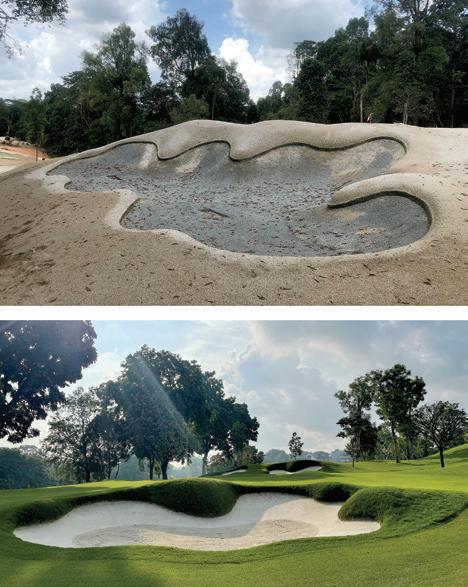
construction, simplifying grow-in management and holding designers’ shapes permanently for many years after completion. During the mixing process, the crimped fibres are entwined with the sand, increasing the sand’s overall strength and resistance and improving its structure.
Sports surfaces benefit from this very latest step forward in turf technology. The ‘crimped’ fibre is mixed with sand to provide stabilisation of the rootzone, as well as introducing a shock-absorbing effect which rapidly restores surface uniformity after load distortion. Turf nurseries are also benefiting from a reduced grow-in and establishment period. Allowing a better growing environment through improved porosity, drainage and airflow gives a stronger and healthier turf that also makes it easier to transport and transfer.
Loksand gives the ability to maintain a natural grass access road as it dramatically improves the load bearing capacity. It greatly reduces rutting, furrows and grooves and wear in high traffic areas like golf course cart paths, tee-boxes and walkways. It is a cost effective and aesthetically pleasing solution for emergency and service vehicle access routes around buildings, airports, racetracks and golf courses.
COLIN CAMPBELL (CHEMICALS)
Stand 40
Colin Campbell (Chemicals) is proud to announce our stalwart herbicides Methar Tri-Kombi and Sportsground are available again! Marketing manager Nadeem Zreikat is delighted to have these products back. “After supply of mecoprop ceased, we never thought we would ever see Tri-Kombi and Sportsground back. We have been continuously looking for mecoprop and have been able to source material from a reputable supplier we work with. This is great news for the industry especially with the fate of bromoxynil-based products changing poison
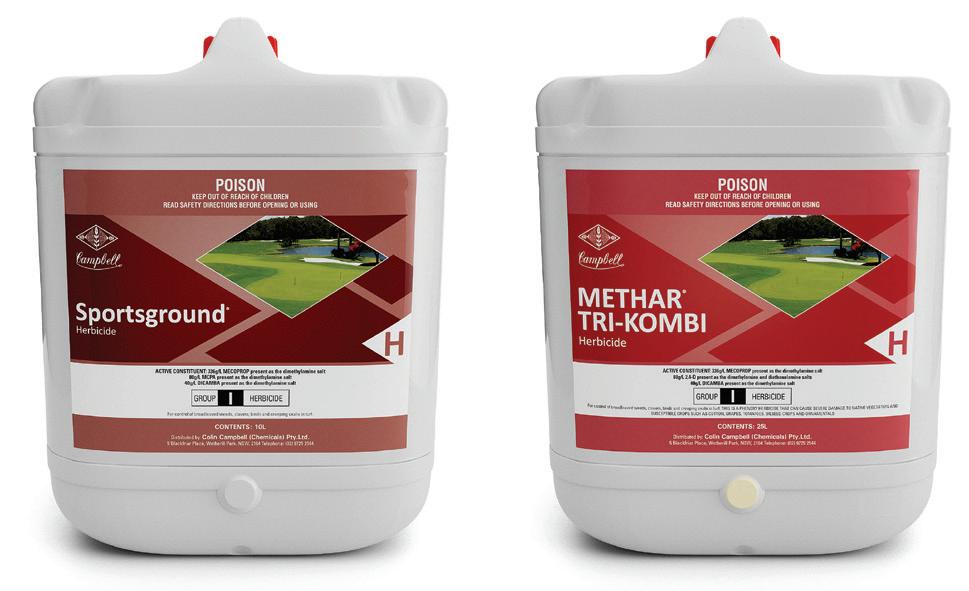
scheduling in February. Methar Tri-Kombi and Sportsground gives turf managers reliable cost effective broad leaf herbicides.” Methar Tri-Kombi will initially be available in a 25L container, with a new 20L pack size to come along with the reliable 5L. Sportsground will be available in 10L containers.
DAVID GOLF
Stand 39
David Golf is delighted to release the most advanced broadcast spreader to Australia! Designed in Sweden by KSAB Golf, the DUO Spreader (pictred below) is unique in that it is equipped with patented dual spreading plates, which provide a wider and more uniform dispersal pattern than any other spreader – eliminating the need to go over the same areas twice. Unlike other broadcast spreaders with plastic components, the 100 per cent stainless steel metal components make it the ideal solution for spreading sand, seed and fertilisers. Visit Stand 39 to check out the new industry standard in broadcast spreaders – the DUO Spreader, only available from David Golf.

NUTURF
Stand 28
Precision, efficiency and seamless organisation are critical to a well-run facility. Nuturf is proud to announce its exclusive partnership with TaskTracker, bringing a cutting-edge software solution to Australian turf managers. TaskTracker represents a shift in how turf managers can coordinate their teams and operations. Tailored specifically for the unique demands of superintendents, TaskTracker (pictured opposite page) empowers turf professionals with a comprehensive suite of tools designed to streamline tasks, optimise resource allocation and elevate course maintenance standards. From scheduling routine activities to managing inventory and equipment, every aspect is seamlessly integrated into a single platform.
With TaskTracker, superintendents and general managers gain valuable insights into how time and resources are used to improve their operations. Nuturf’s partnership with TaskTracker heralds a new era of efficiency in turf management, reaffirming its commitment to providing turf managers with the solutions they need to thrive in an evolving landscape.
In addition to highlighting its new partnership with TaskTracker, Nuturf will also be launching its complete all-in-one Financial Solutions offer tailored to turf management facilities to make buying equipment, fertilisers, chemistries and more completely seamless. Enjoy the convenience of packaging all your machinery and chem-fert supplies into one easy repayment. With Nuturf Financial Solutions, facilities can gain control over cashflow and budgets to simplify their finances. Whether you’re upgrading your fleet or stocking up on supplies, Nuturf can finance the lot! Say goodbye to financial barriers and hello to streamlined operations. Contact your Nuturf territory manager or visit www.nuturf. com.au for more information today.
40 AUSTRALIAN TURFGRASS MANAGEMENT 26.3
BRISBANE 2024

SUNDEW SOLUTIONS
Stand 46

Join Sundew Solutions at Stand 46 during this year’s Australian Sports Turf Management Conference and Trade Exhibition to discover our cutting-edge solutions for protecting your investment in sports turf from red imported fire ants (RIFA).
As leaders in pest management, we are proud to showcase our latest products tailored specifically for turf situations. Our comprehensive range of products offers effective treatment solutions for a broad spectrum of insect pests, including the
notorious RIFA. With years of research and development behind them, our solutions have been rigorously tested and proven to deliver outstanding results in the field.
At our stand you’ll have the opportunity to engage with our knowledgeable team who will provide insights into the unique challenges posed by fire ants in sports turf and demonstrate how our products can effectively mitigate these risks. From rapid response treatments to long-term prevention strategies, Sundew Solutions has you covered. Don’t miss this chance to learn more about protecting your turf from fire ants and other insect pests. Visit Stand 46 and discover why Sundew Solutions is the trusted choice for turf managers across Australia.

ALSO EXHIBITING… BROWN BROTHERS ENGINEERS AUSTRALIA
Stand 1
Introducing Brown Brothers Engineers’ innovative trailer-mounted pump set (pictured above). Engineered with precision and tailored to your unique needs, it offers an alternative to the way you manage irrigation on the move and provides a cost-effective solution to flood mitigation management.
A custom solution was recently installed at a flood-prone golf course in southeast Queensland. After enduring recurring flooding events that damaged the course and more recently, washed away it’s pumping infrastructure, our team engineered a mobile pumping system fitted onto a trailer. Despite further flooding, the course immediately reaped the benefits. With just two people, the pumps could be relocated in 15 minutes by towing it to higher ground.
Typically, a custom-mounted booster set features a Lowara e-SV Series pump renowned

MAY-JUNE 2024 41
BRISBANE 2024
for its hydraulics and IE2 high-efficiency motor. Complemented by an INCA control panel, our solution offers optimal system control and flexibility. Designed for practicality and ease of use, installation is seamless while the quickrelease electrical connection to the control panel enables fast and safe shutdowns as well as quick transportation, allowing sports turf managers to relocate the entire pump unit to higher ground within minutes.
Brown Brothers Engineers Australia is committed to delivering high-quality pumps and custom engineered pumping solutions to meet the diverse requirements of the turf and golf course markets. Visit us on Stand 1 to find out more about our custom trailer mounted solutions.
CAMPEY TURF CARE SYSTEMS
Stand 15
Campey Turf Care Systems is one of world’s largest independent sports turf and ground care machinery suppliers, distributing innovative sports turf maintenance equipment and has earned a reputation for offering practical advice and superb aftercare service.
In 2022 Campey Turf Care Systems launched Campey Australia. This expansion has led to an established presence in Australia delivering the leading machinery and customer service which Campey is known for across the globe, through local dealers.
The Australian arm is overseen by Campey export sales manager Nick Brown who is responsible for building relationships with customers and allowing the company to get valuable insights and solve problems with new practical and mechanical products. Working with dealers and customers on an individual basis, through export development, Campey has earned the trust of greenkeepers and groundsmen worldwide delivering natural approaches to rejuvenating the soil.
Campey’s ideology is to provide the widest range of sports turf renovation equipment designed to revive worn pitches quickly. By understanding the science behind turf care Campey supplies machinery that works on the principle of sustainability, such as scarifiers, brushes, rakes, drag mats and sprayers, including Campey Uni-Scratch (pictured below), UniRake, Campey Speedresser and the ML Sprayer.


GEORIPPER (ADE TURF)
Stand 58

Introducing MiniTrencher’s all-new GeoRipper e/B. Recognising the market shift towards electric battery outdoor power equipment, MiniTrencher now gives users the option of having a GeoRipper minitrencher that utilises the GreenWorks Commercial 82V or the Makita 40V MAX XGT battery powered motor. GeoRipper is the trusted name for handheld trenching since 2016 and is perfect for irrigation, electrical, root barriers, plumbing, fencing, erosion control and more. Lightweight for easy manoeuvrability and control, GeoRipper’s self-sharpening digging chains cut through tree roots up to 3” thick. It can dig up to 16” and 20” deep and 2” wide depending on the model.
GREEN WORKZ
Stand 21
Head toward the Green Works stand to experience GKB and SISIS! As leaders in sports turf machinery, we’re excited to showcase our reliable and robust machinery designed specifically for the demands of the sports turf industry. From pristine fields to top quality greens, our equipment is engineered to elevate every aspect of sports turf management and renovations.
At GKB, where “The Worker is King”, the machines are from The Netherlands. On our stand we will be showcasing the robust Sand Spreader and Deep Tine Aerator (pictured above) as well as showing the full range of machinery which ensure only the best quality renovations. Meanwhile, SISIS equipment sets the benchmark for world-class design and manufacturing direct from Derbyshire, England. From the Veemo scarifier to the Multitiner Aerator which will be on stand, our
machinery tackles maintenance challenges with unrivalled efficiency and precision.
But it’s not just about performance – it’s about passion. With both brands still being owned and operated family business, they and we understand the dedication that goes into sports turf management, which is why the machinery is crafted with the expertise and insight of industry professionals and made to deal with the tough Australian conditions. Visit our stand to experience firsthand how GKB and SISIS are setting the standard in sports turf maintenance machinery.
YG SOFTWARE (HYDROSIGHT) Stand 65

The Hydrosight wireless soil monitor is revolutionising water use management for sports fields, optimising labour costs and enhancing aesthetic appeal. This innovative device provides real-time, underground soil moisture data, enabling precise irrigation control. By ensuring that water is applied only when and where needed, Hydrosight can help significantly reduce water consumption. This not only saves resources but also reduces the cost associated with over-watering and labourintensive soil management.
With Hydrosight, sports field managers can maintain perfectly hydrated turf which is crucial for both the playability and visual quality of sports surfaces. Healthy, wellwatered grass displays a vibrant green that enhances the aesthetic appeal of any sports venue. Integration capabilities allow Hydrosight to connect with existing irrigation systems, further streamlining operations and cutting down on manual labour. All data is accessible through the Hydrosight mobile app, providing managers with the information they need to make decisions quickly and efficiently.
42 AUSTRALIAN TURFGRASS MANAGEMENT 26.3
2024 Australian Sports Turf Management Conference Trade Exhibition -
Brisbane (19-20 June)

MowMaster
Kress
Fernland 21 Green Workz/Dennis/SISIS
Green Ward Soil Solutions (Green Turf)
SME Mowers
Bernhard and Company 48 Indigo Specialty
GMA AREA
101 Golf Management Aust 102 Scent Australia 103 The Golf Travel Agency 105 Avenue Press
MiClub
NHP 110 My Golf Challenge
Debortoli
Foley & Harper
120 Schweppes
128 First Choice Services
129 Vittoria
130 Club Car
Note: Floorplan/stand numbers correct at the time of printing. For any updates, download the conference app –‘SPRINTR Events’ from your app store and
MAY-JUNE 2024 43
ASTMA PLATINUM PARTNERS 25 Toro Australia 26 Syngenta Australia ASTMA GOLD PARTNERS 37 Envu 42 John Deere ASTMA SILVER PARTNERS 20 Kubota Australia 34 Jacobsen, A Textron Company 35 Rain Bird Australia 36 Living Turf ASTMA BRONZE PARTNERS 1 Brown Brothers Engineers Australia 2 Centaur Asia Pacific 22 Greenworks Commercial (JAK Max) 23 Ventrac Australia 24 Husqvarna Group 27 ICL Specialty Fertilizers 27 K&B Adams Turf 28 Nuturf Australia 29 Sustainable Machinery 30 Dint Golf Solutions 31 Country Club International 32 Hunter Industries 33+44 Greenway Turf Solutions 38 Lawn Solutions Australia 39 David Golf & Engineering 40 Colin Campbell (Chemicals) 41 Fieldquip 43 Adama 46 Sundew Solutions 47 Advanced Seed 53 Repco Australia ALSO EXHIBITING 3 Helix Hydro 4 Trench It - Terraway Attachments 4a Floratine 5 Leemco Piping Solutions 6 Powerup Lawncare Products 7 Tru-Turf 8 The Toolbox Team 9 Land Watch Aust (Blind Shot) 10 BA Group Australia 11 Turfcare Australia 12 GreenPro (Quick Corp) 13 E-Z-GO/Cushman 14 Mentay Steel Fab Constructions 15 Campey
Technology
17a
18
19
Products 49 Olelon Energy USA/Shenzhen Green Energy 50 DKSH Agrisolutions 51 Evergreen Turf Group 52 Trimax 54 Turf Breed 55 The Spray Shop 56 Environmental Golf Solutions 57 CoolTops 58 Georipper (ADE Turf) 60 Wessex Int’l Machinery 62 Fertec 63 Plasson Australia 65 YG Software (Hydrosight) 66 Mineral Magic 67 Blue Pacific Minerals
Colbrook Industries
Global Turf
Agsafe/drumMuster/ ChemClear
Australasia 16 Nano Bubble
16a Bardee 17 Positioned
21a
21b
45
68
69
70
107+123
109
116
117
119+121
106 59Club
108 Senpos
111 North Star 113 Pariter 115 Golf Australia
Bidfood 118 Host Plus
122 Transform Golf 124 Parklink 126 Astrowave 127 Callaway
put in code ASTMA2024.
steps First
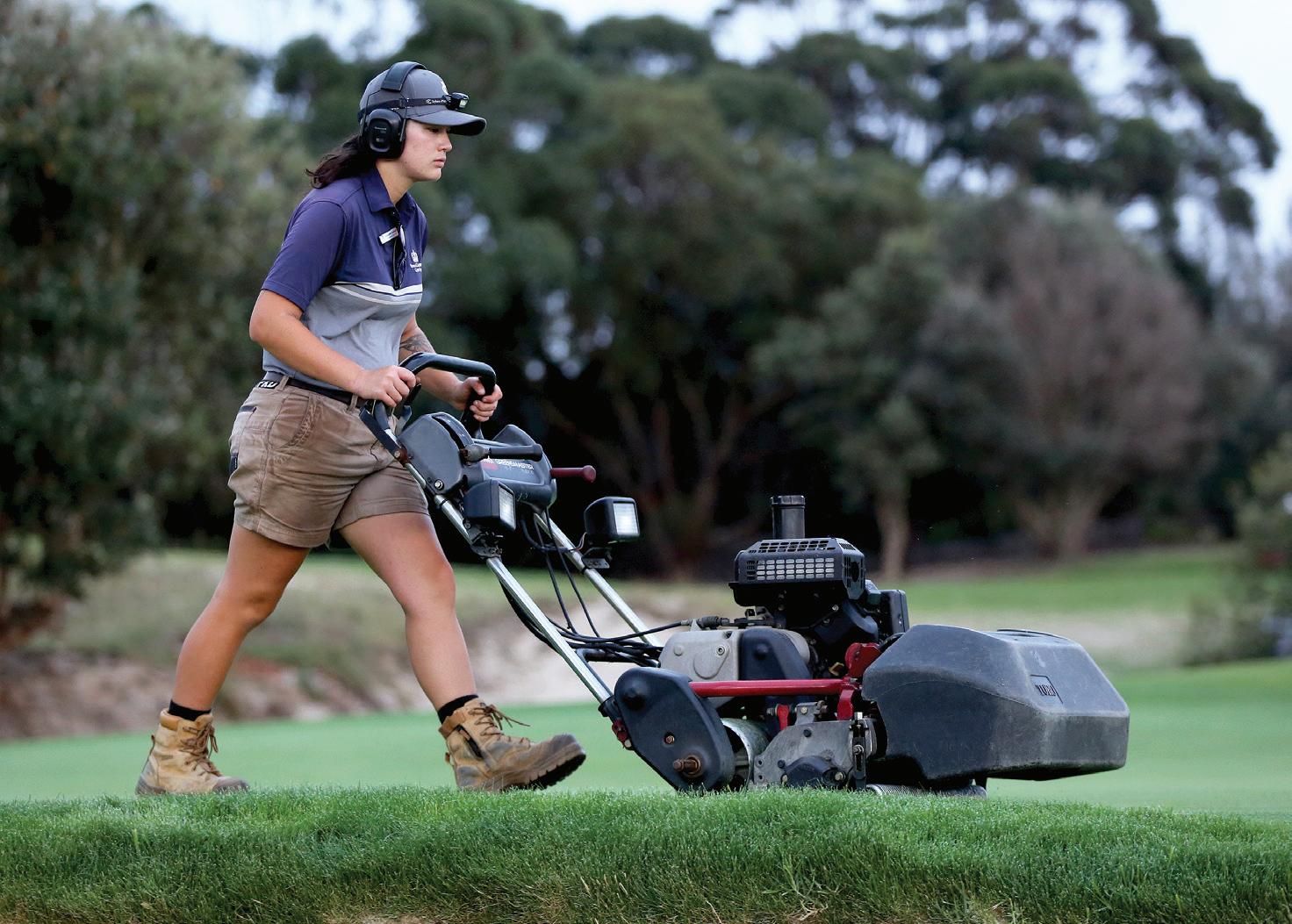
ATM profiles this year’s crop of recently qualified sports turf managers who will vie for the respective Graduate of the Year awards, sponsored by Toro Australia.

The Australian turf industry’s rising talent will be celebrated at the National Turf Industry Awards on the opening night of this year’s conference, with the respective Graduate of the Year Awards to be announced in partnership with ASTMA Platinum Partner Toro. The ASTMA Graduate of the Year Award, which recognises the top graduating golf apprentice, is now in its 29th year, while the sportsfields and grounds graduate award has been bestowed since 2011.
On the back of the ASTMA’s Women in Turf Strategy initiative, pleasingly this year’s finalist cohort includes three female sports turf managers – Sophie Warren (Glenelg GC, SA) and Annabelle Southall (Royal Canberra GC, ACT) in the golf award and Kelsey Lovell (Museum of Old and New Art, Tas) in the sportsfields and grounds award. All up there are 11 finalists (five golf and six sportsfields) with the ASTMA congratulating the following state winners and wishing them all the best for the national award judging which will take place on the eve of the Brisbane conference.
ASTMA GRADUATE OF THE YEAR
BESCHEN POU
Rockingham GC/The Links, Kennedy Bay | GCSAWA

Pou has spent most of his life on golf courses, with greenkeeping father Jason and extended whanau (family) involved in the construction and maintenance of Kauri Cliffs and Cape Kidnappers in their native New Zealand. After the family moved to Perth, Pou began an apprenticeship under his dad who had gained the superintendent role at Rockingham Golf Club, an Australian parkland-style, warm-season course with Saltene (Paspalum vaginatum) greens and kikuyu fairways. Working in a small team, Pou began to build his skillset in all areas of course management and developed a deep appreciation for sports turf management.
In 2023, Pou joined The Links, Kennedy Bay as a foreman under superintendent Mark Bilsborough as part of NewGround Facilities Management. The course is currently

undergoing a major redevelopment, with Pou gaining hands-on experience growing in the new 007 bentgrass greens, stolonised Wintergreen couch fairways and working with both Toro and Rain Bird irrigation systems.
During his apprenticeship, Pou started a Bachelor of Science degree majoring in sustainability through the University of Tasmania. “I feel I’ve ultimately found my passion in sports turf,” says Pou. “My focus is on holistic, sustainable solutions to address environmental, social and economic challenges in sports turf management, while also being committed to cultivating top-tier playing surfaces.”
ANNABELLE SOUTHALL

Royal Canberra GC | ACTSTMA Southall created a slice of history when she became the first female to win the ACTSTMA Apprentice of the Year Award. Southall started working as a casual at Royal Canberra at the end of 2020 and after enjoying that role transitioned into an apprenticeship.
44 AUSTRALIAN TURFGRASS MANAGEMENT 26.3 BRISBANE 2024
Opposite: Royal Canberra Golf Club’s Annabelle Southall, pictured volunteering at the 2023 Australian Open at The Lakes, became the first female to win the ACTSTMA Apprentice of the Year Award
Southall’s entry into turf management came after working casually with a landscaper where she gained an appreciation for working outdoors and physical labour. She then spied the role at Royal Canberra which not only offered her the chance to continue doing similar work that she enjoyed but also gave her a qualification.
“What I enjoy most about greenkeeping is that every day is different and the range of tasks is vast,” says Southall, who volunteered at the 2023 Australian Open at The Lakes alongside 2023 ACT Graduate of the Year Riley Willcox. “I also like the attention to detail that goes into every task. From raking bunkers to changing holes, there is always a little extra you can do to make the end product better.”
BRANDON VELLA
Campbelltown GC | NSWGCSA

Vella has been working as an apprentice at Campbelltown Golf Club in Sydney for the past threeand-a-half years. As a kid, Vella always enjoyed playing golf and would spend hours practicing after school. He would go on to win multiple junior events and was a representative in the NSW Combined Catholic Colleges golf team in 2018 and 2019. Once he turned 19, Campbelltown was looking for an apprentice and Vella gave it a go.
“In the last couple of years my passion for sports turf has grown significantly,” says Vella, who was named the NSWGCSA Vince Church Graduate of the Year recipient earlier this year. “I regularly spend time trying to learn more about turf through videos, information from my TAFE teacher, online articles and university studies online. I love working on the golf course. All the time and effort by the team that goes into the course is shown by the fantastic turf playing surfaces. Late last year I had the privilege of being part of the volunteer crew at
the 2023 Australian Open at The Lakes Golf Club. This was a real eye-opening experience seeing how tournament preparations are conducted and a great way to meet a lot of new people in the industry.”
DARREN WARDLE

Murray Downs/Royal Melbourne | VGCSA Wardle began his career at the back end of 2020 after finishing a Bachelor of Design in architecture. It was during that course he realised it wasn’t quite what he had in mind for a career, instead preferring a job working outdoors. An apprenticeship became available at Murray Downs Golf and Country Club in Swan Hill, where he is originally from, and he jumped at the opportunity and hasn’t looked back.
“I love having an input to how golf courses play and look aesthetically,” says Wardle, who in September 2023 took on a role at Royal Melbourne Golf Club. “Working out there in the Swan Hill summer never felt like a chore. The job always keeps you on your toes with all the different aspects of managing turf. A standout moment of my career to date was working the Asia Pacific Amateur Championship last October and walking around Royal Melbourne watching the world’s best amateur players playing on the course that we had worked on for months to prepare for the tournament.”
SOPHIE WARREN
Glenelg GC | TMSA

The 2024 TMSA Graduate of the Year recipient, Warren has made remarkable strides in turf management since leaving Sacred Heart College after Year 11. During her school holidays, she worked as a casual at the Glenelg Golf Club where she discovered her passion for turf management. Inspired by her dad Tim, who is the current Glenelg course superintendent, the young Warren decided to follow in his esteemed footsteps and in 2021 successfully obtained an apprenticeship with
the club. Her motivation stemmed from a love for working outdoors, collaborating with a team and witnessing the tangible results of her efforts on the golf course.
Career highlights to date include volunteering at the 2022 Australian Open at Victoria Golf Club under the stewardship of Steven Newell. The tournament experience there led to her working at the 2024 Webex Players Series Murray River tournament at Cobram Barooga Golf Club as a part of John Deere’s Women in Turf initiative. Warren’s dedication, skill and passion for turf have not only earned her the TMSA Graduate of the Year award but also set a solid foundation for a promising career in the industry.
Editor’s Note: Ethan Vickery (Rowes Bay GC) and Sam Omahoney (Devonport CC) won the respective Queensland and Tasmanian state graduate awards but due to prior commitments have elected not to vie for the national award.
SPORTSFIELDS & GROUNDS GRADUATE OF THE YEAR AWARD
MASON HANNEYSEE

Turfcare Solutions | STA Victoria After leaving school in search of a hands-on career, an apprenticeship opportunity arose for Hanneysee with Geelongbased Turfcare Solutions in 2020. As part of the Turfcare operations team that travels around Geelong and Melbourne, Hanneysee helps take care of a range of turf surfaces and undertaking various types of maintenance. At Turfcare, Hanneysee’s days are filled with all sorts of tasks, from spreading fertiliser to aerating and spraying. There is always something different which keeps things interesting and why he loves the job.
“One of the best moments in my career so far was winning the STA Victoria Apprentice of the Year Award,” says Hanneysee. “It was a huge honour and I’m looking forward to representing my state in Brisbane. The

MAY-JUNE 2024 45
highlight of TAFE was learning the science behind growing turf and delving into the complexities of turf management. Looking ahead, I’m hoping to move into project management within Turfcare as well as doing the Diploma of Sports Turf Management.”
KELSEY LOVELL

Museum of Old and New Art | TSTMA Lovell started her turf management career in 2019 as an apprentice at Blundstone Arena in Hobart after seeking a career change from being a paramedic. Having always loved sport, especially cricket, the position which arose at Tasmania’s premier cricket venue provided a perfect opportunity for Lovell to blend work with a passion. Her career highlight was being part of the team which prepared Blundstone for the historic 5th Ashes Test in January 2022. Lovell says the intensity of the work was palpable and it was thoroughly enjoyable to be part of an event that had such an impact on the Tasmanian community.
Lovell is currently a turf specialist at the Museum of Old and New Art (Mona) in Hobart where she has been since early 2023. In conjunction with a colleague, Lovell oversees the turf management at Mona where the surfaces are either integrated within art spaces or used to complement art around the site. “I believe I have a fine attention to detail and the visual aspect of turf management is highly rewarding to me,” says Lovell. “I take a lot of pride in the high-level surfaces I produce and have great satisfaction watching a surface I have prepared be enjoyed by many for its intended use.”
LUKE MIKULA
Sapphire Coast Turf Club | STA NSW

After leaving school, Mikula had a few different jobs including being a rural firefighter, farm hand, forestry worker and building labourer. Over a four-year period he also worked weekends casually at Moruya Jockey Club alongside Zac White and it was during this time that Mikula decided to undertake a sports turf management course through Yallah TAFE. After White was offered the position of turf manager at Sapphire Coast Turf Club, situated between Bega and Merimbula on the NSW South Coast, he encouraged Mikula to join him. Having worked together there for two years now, White will shortly relocate to Newcastle with Mikula set to take over as track manager.
“Working at Moruya I had to do a lot of self-learning, but going to TAFE was so beneficial as I took the knowledge I was learning from class and put it into practice at work,” says Mikula. “David Little was an awesome teacher. Being in an agricultural
area, the course focused more on agriculture, but David would adapt it to be sports turf specific to ensure we knew what we needed to know for our work.
“I’m proud of the improvements we’ve made on the track at Sapphire and excited to be stepping into the head role. I love being outdoors and the satisfaction that comes with presenting a good quality track, parade ring, gardens and healthy turf. There are eight hectares of turf plus the surrounds that we look after. The feedback from managers and trainers is very positive. Seeing the results of what I put in is paying off and knowing I’m heading in the right direction. I want to continue improving the consistency of the track so we can grow the number of trainers here and bring more funding into the club.”
JACOB MOODIE
Green Options/Royal Canberra GC | ACTSTMA

Moodie’s turf journey began in 2021 when he relocated to Canberra from Cowra, NSW to pursue a greenkeeping career, initially joining the Green Options team at the Australian National University. Halfway through his third year of studies Moodie was appointed 2IC with Green Options before seizing an opportunity at the start of 2024 at Royal Canberra Golf Club under superintendent Ryan Stores. His tenure with Green Options afforded invaluable opportunities, including stints at GIO Stadium during the NRL and Super Rugby seasons which provided Moodie with some great learning experiences in turf management.
“My motivation to pursue this career is not just a love for the game of golf but a familial connection that is involved within the turf management industry,” says Moodie. “Witnessing a relative thrive within this industry fuelled my ambition and solidified my decision to get into turf management. The appeal of outdoor work, coupled with providing perfection, is what beckons me to the course each day where I genuinely enjoy my work.”
MASON O’SULLIVAN

The Gabba | STA Queensland O’Sullivan will be hoping to follow in the footsteps of fellow Gabba crewmate Lachlan Roache who won this award last year. O’Sullivan’s first taste of turf management came in Year 10 when he did work experience at Chermside Bowling Club in Brisbane. He then undertook a school-based traineeship in years 11 and 12 with the Warehouse Cricket Association of Queensland based at Marchant Park. After leaving school O’Sullivan was able to continue at Marchant Park and undertake his sports
turf management apprenticeship. During that time he also picked up regular casual work at The Gabba. This included the 2023 ICC Men’s T20 World Cup and reconfiguring the ground for a Brisbane Broncos NRL match during the FIFA Women’s World Cup when Suncorp Stadium was unavailable. O’Sullivan has also volunteered at his local AFL club, the Sandgate Hawks, where he played most of his junior football.
“I enjoy working outdoors and I find it rewarding to create an oval or field in the best possible condition,” says O’Sullivan, who has played AFL to state league level. “It is satisfying when others comment on the great condition of the ovals I have worked on and presented. Problem-solving on the run is a big part of sports turf management which I also enjoy. For instance, during the Brisbane floods of 2022, we had two weeks to get the grounds back up. This was a huge task given the state of not only the wicket blocks but the debris all over the outfields. In the near future I would love to be a head groundsman or superintendent and would also love to work interstate or even overseas.”
HARRY QUIGLEY
Pinjarra Park | STA WA

Growing up in the small WA township of Hyden, about four hours east of Perth, sport was a huge part of Quigley’s formative years. He tried many sports from golf to tennis to cricket and AFL, but landed on soccer which changed his life. The family moved closer to Perth for Quigley’s schooling and sport, which led to state team opportunities, playing for Perth Glory youth teams and travelling to England, America, Malaysia and Singapore all for soccer.
At the suggestion his uncle who was working there at the time, Quigley started as a casual at Pinjarra Race Club in 2017. After heading to the US to pursue his soccer, Quigley returned to the racing club in 2020 and it wasn’t long before he was offered an apprenticeship. Quigley is currently the track 2IC and has aspirations of taking over in the near future. A memorable day was being track manager during the Pinjarra Cup, the club’s biggest race of the year.
“My love of turf I think connects to my love of sport and how I can be around it when I’m not playing myself,” says Quigley, who earned the Hambleton Clements Memorial Shield for best block apprentice at this year’s WA TAFE Awards night. “The satisfaction from creating a safe, reliable, consistent and aestheticallypleasing surface that you can be proud of and athletes will enjoy is something that I cannot get enough of. Finding a love and joy from the turf industry gave me the drive to take it further and to find my potential in the field.”
46 AUSTRALIAN TURFGRASS MANAGEMENT 26.3 BRISBANE
2024



establishment Organic amendments and turf
Continuing his exploration of soil amendments and their benefits or otherwise, ATM columnist John Neylan looks at the results from a recent turf establishment trial.
In ATM Volume 25.6 (NovemberDecember 2023) – ‘Assessing organic amendments’ (pages 44-48) – I discussed the research undertaken on adding different amendments to sand and whether there were suitable alternatives to coir fibre and peat moss. The research involved the laboratory testing of free-draining sand with either compost (AS 4454-2012 AMD 2:2018 compliant), coir fibre, biochar or processed poultry manure. The results can be summarised as follows:
l The addition of compost had an inconsistent effect on the capillary porosity
and at 10 per cent by volume caused a 50 per cent decrease in the drainage rate.
l Coir fibre increased the capillary porosity at the 10 per cent by volume addition.
l Biochar caused a dramatic increase in the capillary porosity.
l The processed poultry manure increased the capillary porosity at the 7.5 per cent by volume rate. At this rate of addition, it can also have a negative effect on the drainage rate.
The end result was somewhat inconclusive and challenged what we may consider to be the accepted convention.
COUCH ESTABLISHMENT TRIAL
To further explore the benefits or otherwise of these amendments, a pot trial was established in late December 2023 to assess the effects of several sand amendments on the establishment of Santa Ana couchgrass sprigs. There were 10 treatments including coir fibre, compost, biochar, processed poultry manure and a ‘standard treatment’ (see Table 1). The ‘standard treatment’ was also included with each of the amendments.
The sand used was a medium washed sand (Table 2) typical of sands used for the construction of golf greens and sportsfields.
48 AUSTRALIAN TURFGRASS MANAGEMENT 26.3 JOHN NEYLAN
PHOTOS: JOHN NEYLAN
Opposite: The turf establishment trial was set up in 3.3-litre pots with Santa Ana couchgrass sprigs planted on 30 December 2023. There were 10 treatments including coir fibre, compost, biochar, processed poultry manure and a ‘standard treatment’
The trial was set up in 3.3-litre pots with Santa Ana sprigs planted on the 30/12/23. There were three sprigs per plot with each sprig having two viable nodes and there were three replicates for each amendment treatment. The following practices were undertaken on the pots during the trial; l Irrigated 2-4 times a day, depending on the weather.
l Fertilised every 14 days using a soluble fertiliser (NPK 25:5:9) at 100kg/ha/ application and a single application of a controlled-release fertiliser (NPK 15:2:13) at 150kg/ha. Total of 173kgN/ha was applied over the 12-week establishment period.
l The per cent area covered was determined using the Canopy Cover App which uses the iPhone camera to determine the per cent green leaf/area covered. The pots were measured weekly.
l Soil moisture content and soil temperature were also measured.
l At the end of the trial the roots were washed free of sand and the depth of the main root mass measured. Root health was also rated as well as the dry weight of roots measured.
RESULTS
The results are detailed in Tables 3 and 4 (page 50) and summarised as follows:
% AREA COVER
l There was no significant difference in the per cent area cover on all assessment dates and a portion of the data is provided in Table 3.
l The per cent change in the area covered was also calculated and there was a significant difference between the treatments at 21 and 27 days after planting (DAP) (Table 4). This result indicates some initial stimulation to growth due to the amendment, however, this did not persist across the entire trial period.
l The per cent change in the area covered at 21 DAP had the following results;
l The compost at 2.5, 5 and 7.5 per cent provided the best result.
l The poorest results were with the compost at 10 per cent, the standard treatment and coir fibre at 10 per cent.
l These results indicate that there may be some initial increase in fertility from the compost.
l The per cent change in the area covered at 27 DAP had the following results;
l The compost at 2.5, 5 and 7.5 per cent and the coir fibre 5 per cent, biochar 10 per cent and processed poultry manure could not be statistically separated.
l The poorest result was with the coir fibre at 10 per cent.
l At 27 DAP the initial effects of the amendments appeared to be declining. The effects of the coir fibre at 10 per cent is difficult to explain.
ROOT DEVELOPMENT
At 130 DAP the roots were washed free of all sand and the depth of the main root mass measured. Root health was also assessed on a 1-5 scale (where 1 = very few white roots, most roots were brown and there were very few root hairs, and 5 = all white roots and excellent root hair development).
After washing the roots they were oven dried and then weighed. The results are
TABLE 1: SAND AMENDMENTS
Treatment Application rate
Compost 2.5% by volume
Compost 5% by volume
Compost 7.5% by volume
Compost 10% by volume
Coir Fibre 5% by volume
Coir Fibre 10% by volume
Biochar 5% by volume
Biochar 10% by volume
Poultry Manure 2% by volume
Standard Program (standalone treatment as well as being applied to all of the above) included:
l Processed poultry manure at 50kg/ha
l NPK (10:10:10) fertiliser at 300kg/ha
l Dolomite lime at 2000kg/ha
TABLE 2: SAND PHYSICAL CHARACTERISTICS
detailed in Table 5 (page 50) and there was no statistical difference in the depth of the main root mass, root health or root weight.

MAY-JUNE 2024 49
Sieve size (mm) (% Retained) 2 0 1 1 0.5 16 0.25 54 0.15 28 0.053 1 Pan 0 Physical tests Total porosity at 30cm tension (%) 40.5 Capillary porosity at 30cm tension (%) 15.9 Air-filled porosity at 30cm tension (%) 24.6 Saturated conductivity - 16 drops (mm/hr) 896 - 32 drops (mm/hr) 707
...a cut above the rest! Wiedenmann Terra Rake... dethatching made easy. www.fieldquip.com.au 1800 454 150 sales@fieldquip.com.au

TABLE 3: % AREA COVERED
TABLE 5: ROOT DEPTH, ROOT HEALTH AND ROOT DRY WEIGHT
Treatments
Manure 2% 13.7 3.3 2.9
SOIL MOISTURE CONTENT AND SOIL TEMPERATURE
The soil moisture content and soil temperature were measured on several occasions. Prior to planting, the pots were saturated and allowed to drain for 24 hours and then the soil moisture content measured with a TDR soil moisture probe. There was no significant difference in the soil moisture content. On other occasions the pots were allowed to dry for six hours and the soil moisture content measured at three and six hours after irrigation. Again there was no significant difference between the treatments. The soil temperature was
measured on three occasions and there was no significant difference between treatments on any of the measurement dates.
CONCLUSIONS
When undertaking trials there is an expectation that there will be some type of positive result. Achieving a significant difference certainly provides something to discuss. As we can see from the results, we had no significant results for any of the data except for the per cent change in area covered for the first 27 days. The results may be in part affected by the pot size, but all elements were strictly controlled.
TABLE 4: % CHANGE
Having a statistically non-significant result doesn’t mean that we haven’t learnt anything. What the results tell us is that the amendments were not necessarily any better than each other or the standard treatment except for a short initial period. In reviewing the results it highlights that a standard program of regular light applications of fertiliser is the key to establishing Santa Ana sprigs in a sand profile. When looking at the addition of the amendments, even at 10 per cent by volume, the amount of material is very small. Just a visual look makes you question the value of adding such amendments. They are definitely not a magic elixir, but regular fertilising is. Adding amendments such as those used in this trial are likely to have minimal effect at rates less than 5 per cent by volume, if at all. This trial in part supports the inconsistent results achieved in the laboratory tests.
The ‘take home message’ is that there are no magic formulas other than good old fashioned agronomic practices. That is, good soil aeration, adequate fertility and attention to irrigation. Don’t take the adverts and anecdotal evidence as fact and look for research data from replicated trials. If a product looks that it may have value in your situation, put out your own trial and make your own conclusions.

50 AUSTRALIAN TURFGRASS MANAGEMENT 26.3 JOHN NEYLAN The per cent area covered was determined using the Canopy Cover App which uses the iPhone camera to determine the per cent green leaf/area covered
Treatment 13 DAP* 34 DAP 48 DAP 62 DAP Compost 25% 5.5 33.0 84.3 100.0 Compost 50% 7.3 39.0 83.7 100.0 Compost 75% 5.9 32.0 84.7 100.0 Compost 100% 6.6 31.3 80.0 100.0 Coir Fibre 5% 6.6 35.3 80.0 100.0 Coir Fibre 10% 6.6 26.0 82.0 100.0 Biochar 10% 6.2 30.3 84.0 100.0 Biochar 5% 5.8 23.0 62.3 95.0 Standard Program 7.5 30.0 78.0 100.0 Poultry Manure 2% 6.5 35.7 75.7 100.0 LSD (P<0.05) NS NS NS NS *DAP – Days after planting
IN COVER Treatment % Change % Change 21 DAP 27 DAP Compost 25% 51.7 173 Compost 50% 88.9 219 Compost 75% 57.7 196 Compost 100% 2.3 117 Coir Fibre 5% 30.6 157 Coir Fibre 10% -18.6 65 Biochar 10% 5.3 149 Biochar 5% 16.8 87 Standard Program -3.2 104 Poultry Manure 2% 22.1 148 LSD (P<0.05) 54 85
Depth of main Root health Dry root root mass (cm) (0 - poor, 5 - excellent) weight (g) Compost 25% 13.3 4.0 2.3 Compost 50% 14.3 3.7 2.3 Compost 75% 18.3 4.3 2.7 Compost 100% 15.3 3.7 3.0 Coir Fibre 5% 14.3 3.0 2.7 Coir Fibre 10% 13.0 3.0 3.2 Biochar 10% 13.7 4.0 2.4 Biochar 5% 13.3 3.3 3.0 Standard Program 14.5 3.7 3.0 Poultry
LSD (P<0.05) NS NS NS

Kimihia Oceania’s Cutting-Edge Plant Breeding Facility

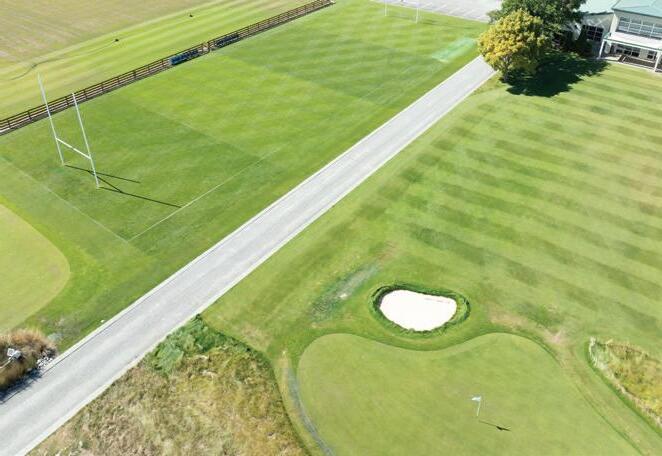
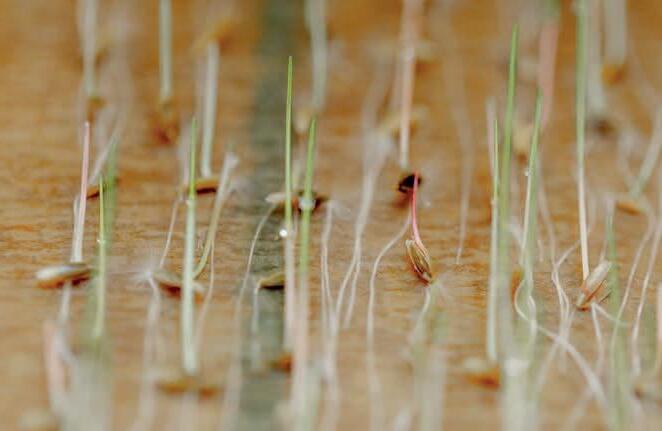
Based near Christchurch, New Zealand, Kimihia (meaning to seek, search) is the Oceania headquarters for PGG Wrightson Turf research; home to their industry-leading agronomy team and ISTA-accredited seed laboratory. Having such an asset in-house allows PGG Wrightson Turf to confidently trial, test and evaluate all turfgrass that they bring into the Australasian sports turf market.

earth
DURATURF
facebook.com/pggwrightsonturf
Experts from
to turf. Call 1800
or visit pggwrightsonturf.com


supreme A friend
Peter McMaugh AM pays tribute to friend and contemporary Dr Joe Vargas who sadly passed away in April.
On 18 April 2024 the international turfgrass community lost one of its greats. Dr Joe Vargas dedicated 55 years to the industry and left it in a much better place. His passing came just a few months after he was feted at a special retirement reception during the Michigan Turfgrass Conference, where he gave one last presentation, aptly titled ‘A turfgrass pathologist career: I did it my way’ When I first met Joe in 1973 I knew he was special. He was then into his fifth year as a faculty member at Michigan State University. He built his academic career the hard way. He did his Bachelor Degree at Rhode Island under the late Dr Noel Jackson, one of the greatest plant pathologists that has graced the turf world. He went on to do a Masters at Oklahoma State University and finally his Doctorate at the University of Minnesota.
Other members of the Michigan turfgrass group at the time were Dr Jim Beard and Dr Paul Rieke. Joe stood tall with them. He had by nature a critical and questioning mind.
His headbutts with Dr Herbert Cole (Penn State), the author of the most extensive book on turf diseases at that time, were legendary. Joe questioned everything. He championed research data and that gave him the surety to challenge current views in the disease field. He ruffled a lot of feathers early on in his career.
Joe was one of the great presenters of science for people less skilled in it than he. I greatly admired how he wore the label of a plant pathologist but was so much more than the stereotype image of that. He was dynamic with an insatiable curiosity and his mastery of plant physiology gave him a wonderful command of the ‘big picture’ in turf.
A TOUR DE FORCE
We were lucky to have Joe come to Australia several times, the first in 1986 for the 9th National Turfgrass Conference on the Gold Coast. Other international speakers that week included Dr Jim Beard (Texas A&M University) and plant breeder Dr Arden Baltensperger (New Mexico State University). It was an excellent conference which included a number
of groundbreaking talks from the overseas contingent. Joe’s contribution was enormous and his talks delivered in his inimitable style. Joe presented papers on bacterial wilt (a new disease to us then), spring dead spot and one titled ‘Ecological approach to maintaining turfgrass’. This latter paper was a ‘tour de force’ where Joe’s experience and mental skills wove together to present a unique view of Poa annua. The science was impeccable, the logic a classic, the balance (even when having subtle digs at others) totally under control.
This is a paper that no matter how much you think you know about Poa annua will both astound and humble you. For me this was the review paper of that conference. It takes the ‘fors’ and ‘againsts’ and opens them out in a way that was all Joe Vargas. The gentle subtlety of ‘failure grass’ (aka Poa) being a success story, unrespected by many, makes for life in this wonderful presentation.
His knowledge of the physiology of wintergrass in its life cycle and behaviour clearly exposed where its weak points lay and equally clearly said ‘Hey, have you missed
52 AUSTRALIAN TURFGRASS MANAGEMENT 26.3 PETER M c MAUGH AM
PHOTO: GARY BEEHAG
that in your looking at how to manage it?’ The excellent analysis of the role of PGRs showed the wrong assumptions most of us make about how to use them to our best advantage. He clearly predicted the resistance build up to endothal without having much experience of it.
How many of you know that Poa annua is 40 per cent more proficient than bentgrass at total photosynthetic efficiency? He didn’t go into whether this was from plant structure or that it is more effective in exploiting a multitude of ecological niches, but you certainly got the feeling that his opinion favoured the latter. Poa annua’s relationship to diseases was also part of his ‘tour de force’ and he raised as many questions as he did answers. Most of those answers we are still chasing today.
Joe would return for the 2002 conference in Brisbane where he gave the opening address on new turfgrass diseases and new approaches to controlling old diseases. Throughout the week he was part of various panel sessions and also gave a talk on topdressing and the development of black layer. He also featured prominently at the conference dinner, taking to the stage impersonating Elvis which he often did with

vim and vigour at turf industry events. His last visit to Australia came in 2019 as part of a tour organised by Turfcare Australia. He spoke at a day at Gosford Race Club and again commanded the room with his presence.
PILLAR OF TURFGRASS SCIENCE
Joe achieved many remarkable research breakthroughs in his 50-year-plus career. He developed a lifelong cooperative friendship with Dr Jim Beard. They had a shared respect for one another that provided a great stimulus for both of them. Joe in more recent times did a great deal of consulting work all over
the world and was much admired and valued by the international turfgrass community. He also penned a number of books, among them Management of Turfgrass Diseases and Poa Annua: Physiology, Culture and Control of Annual Bluegrass, the latter with Al Turgeon.
Joe’s devotion to superintendents and his covering of their backs is the thing for which he will be long and lovingly remembered. He was their friend supreme and in the many tributes that followed his passing that was a common thread. Ohio State University’s Dr Karl Danneberger wrote on golfdom.com:
“Vargas was a prodigious researcher who could relate his research results to the golf course industry better than most. Because of that, he became one of the most iconic figures in our industry. In turfgrass diagnosis, turfgrass pathologists are the tip of the spear. They are often the first contacted regarding turfgrass decline on a golf course. Vargas was one of the best – if not the best – on-site diagnosticians I have known. His ability was due, in large part, to his work on golf courses and responsiveness to golf course superintendents.”
Joe did indeed do things his way and his uniqueness will be sorely missed. In the words of another brilliant turf industry mind, Dr Leah Brilman, who posted on social media shortly after Joe’s passing, ‘It makes me sad’

MAY-JUNE 2024 53
Opposite: Dr Joe Vargas (centre) with Peter McMaugh AM (left) and Dr Percy Wong during his 2019 visit to Australia and (right) as Elvis at the 2002 conference


Stands of sheaoks (Allocasuarina fraseriana) under significant drought stress and in some cases dying as a result of the prolonged dry period that Perth has experienced over the past seven months
pressure Parched and under
John Forrest looks at the challenges facing Western Australian turf managers after another brutal season which has seen just 30mm of rain recorded in the Perth metropolitan area from October 2023 to May 2024.
Weather predictions in southwestern Western Australia are not new, with a hotter and drier forecast proving to be well qualified. The summer of 2021-2022 was Perth’s hottest on record and the summer which has just passed was the second hottest. The prolonged dry period that Perth has experienced has placed turf managers under intense pressure, with just 30mm of rain recorded for the metropolitan area between October 2023 and May 2024. As well as putting turf surfaces under stress, the dry spell is also having a major impact on the health of natural vegetation across the region.
Water sourced from Perth’s groundwater aquifers make up 70 per cent of all water used
across the Perth and Mandurah region. This water is used to supply Perth’s Integrated Water Supply Scheme (IWSS) for industry and horticulture, for irrigating almost all recreational green spaces as well as lawns and gardens through domestic bores. The IWSS is made up of desalinated seawater, groundwater, dams and groundwater replenishment.
The Gnangara groundwater system stores Perth’s largest amount of good quality water. Figure 1 (page 55) shows a cross-section of the Gnangara system, layering of major aquifers and confining units’ connection between aquifers, directions of groundwater movement, saltwater interface and the Darling Fault. As part of the Gnangara system structure there are four main aquifers;
l The shallow, confined superficial aquifer (water table) known as the Gnangara Mound;
l The shallow, semi-confined Mirrabooka aquifer;
l The deep, partially confined Leederville aquifer;
l The deep, mostly confined Yarragadee aquifer.
The Western Australian Government, through the Department of Water and Environment Regulation (DWER), spells out the challenges currently facing the Perth and Mandurah region in regards to water on its website:
“Western Australians need to adapt to a drier and warmer climate, as climate change
54 AUSTRALIAN TURFGRASS MANAGEMENT 26.3 JOHN FORREST
has significantly reduced rainfall over the past four decades in the southwest of our state. Since the mid-1970s, annual average rainfall has declined by about 15 per cent and resulted in an average 80 per cent reduction in streamflow runoff. Before 1975, the average streamflow to Perth’s drinking water dams was 420GL (gigalitres or billion litres). Now, we expect to receive only about 25GL annually.
“The impacts of climate change and increasing groundwater use have shifted our groundwater system out of balance. Since 1980, groundwater levels across the Gnangara Mound have fallen by up to 10 metres in some areas, representing a 1000GL loss of aquifer storage – the equivalent of 1000 Optus Stadiums full of water.
“The lowered water table is evident through the visible drying of wetlands such as Loch McNess and the loss of the unique Yanchep cave ecosystems. Lowered water levels have also led to increased acidity in lakes Mariginiup, Gnangara, Joondalup and Goollelal. Now, over half of the 30 sites used to gauge the health of Gnangara’s groundwaterdependent ecosystems are breaching minimum water levels. Elsewhere along the Swan River and the coast, lower groundwater recharge has caused saline water to move inland, making bores more saline.”
TURF INDUSTRY IMPLICATIONS
The close relationship between the aquifers and the drying climate puts pressure on water use and a smart science-based approach is needed. For the WA turf industry, a licence is required to draw water from aquifers under DWER guidance. The amount allocated depends on several factors, such as the irrigated land size and the water source. During the year, monthly and annual water use amounts can be entered into the DWER’s Water Online website, enabling facilities to monitor their use closely.
As has been written before in Australian Turfgrass Management Journal, the WA

golf industry has proactively developed a Water Wise Golf Course Program with three achievable standards – Gold, Silver and Bronze. In a busy industry it can be timeconsuming to go through the program, but getting involved is a process of understanding how to use your allocation to assist in problemsolving and system adjustment.
It is not just about putting water out; it also looks at all the cultural controls that can work towards retaining enough water but not creating over-watered areas. Getting staff involved is important, other than irrigation technicians, as they can gain a strong understanding of the conditions required to be efficient water users.
Getting the balance right is critical and that includes understanding the weather conditions that increase water application, effectively auditing irrigation systems and knowing when to increase or decrease application rates. Understanding crop factors, soils, infiltration, compaction, thatch and matt layer implications is also key. Predominantly, the golf course
industry is very good at applying the right amount of water, but growing cool-season grasses can be challenging in a warming climate. Turf management is part of the water use environment and being engaged means being part of the environmental stewardship of the golf course or turf management site.
The pressure is only going to increase come 1 July 2028 when groundwater allocations in Perth will be cut by a further 10 per cent. Current allocations are 7500 kilolitres or 7.5 megalitres per hectare. A 10 per cent cut equates to 750KL or 750,000L reduction per hectare. These changes will present precision management challenges for golf courses, which the Water Wise Golf Course Program can help address. The key is to show water providers that best practices are being used by the golf course industry.
Recently, several private golf courses in the Perth region received an email from the DWER regarding groundwater allocation, monitoring and maintaining compliance. The letter indicated the importance of golf courses


MAY-JUNE 2024 55
GRAPHIC: DWER
Figure 1. The Gnangara groundwater system supplies up 70 per cent of all water used across the Perth and Mandurah region. It contains four primary aquifers

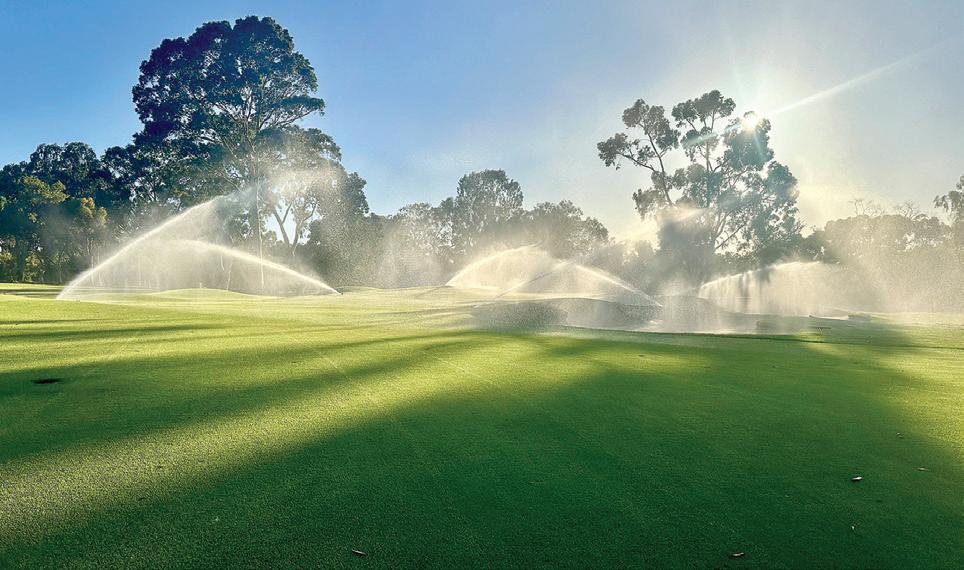
Predominantly, the golf course industry is very good at applying the right amount of water, but growing coolseason grasses, like bentgrass, can be challenging in a warming climate like Western Australia’s
being involved in the Water Wise program and showing an understanding of the water requirements and how they can be best managed. Penned by Matt Viskovich, program manager for the Swan Avon Region Water Licensing Program, the letter read…
“The Department of Water and Environmental Regulations’ Water Licensing Program understands some private golf courses may be experiencing challenges remaining within licensed entitlements due to the extended dry seasonal conditions during 2023/2024.
“The Department wishes to advise that it does not support non-compliance and recommends licensees regularly monitor water usage throughout the water year to remain within the licensed entitlement. Regular monitoring will help with forecasting future water demands and allow adjustments to irrigation practices if necessary to ensure the entitlement is not exceeded.
“If monitoring indicates the likelihood of exceeding the entitlement, please notify the Swan Avon Region’s Water Licensing Program as soon as possible for advice. If the entitlement is exceeded, then the Department’s compliance and enforcement approach will require an explanation for the breach and specify what water conservation measures will be implemented to mitigate future overuse. The information provided will be considered when the Department decides on the appropriate enforcement action.
“Please be reminded that under the Gnangara groundwater allocation plan, licensees within the plan boundary will have licensed entitlements reduced by 10 per cent from 1 July 2028. Clubs are encouraged to commence reviewing current irrigation practices and prepare a water conservation plan as soon as practicable to achieve the 10 per cent reduction. It is acknowledged that this
process may involve educating members of the likely changes to turf condition and garden areas to achieve the reduction.
“I encourage you to seek support for irrigation efficiency training and management under the Water Wise Golf Course Program. The program outlines management practices endorsed by the GCSAWA, Sports Turf Association of Western Australia and the Department of Water and Environmental Regulation. It also includes information relating to the development of a Water Conservation and Efficiency Plan that includes components for contingency planning.”
IMPROVEMENTS
Water application efficiency is central to allocating water and working within it. Applying water efficiently is easier with an up-todate irrigation system designed to suit the location. Over recent years, many changes have occurred. The spacings of sprinklers in Perth have been reduced and coverage has improved. Management systems and pumping moisture sensors have all worked to improve water application.
One barrier to upgrading for clubs or turf facilities is cost. The ever-increasing cost of components, installation and design can quickly deter any consideration of upgrading
TABLE 1. RAINFALL V EVAPORATION
systems. A grant system where clubs or facilities could get money at a reasonable rate would be beneficial. The ever-increasing demand for turf surfaces will keep putting pressure on water use. As the cost of replacing irrigation or upgrading systems increases, in many cases smaller clubs and facilities will struggle to raise the capital to maintain efficiency. Low-cost loans could be an option.
WATER EFFICIENCY SAVINGS
A general rule is that if you boost efficiency by 25 per cent, you can cut watering by 25 per cent. In this case, you could reduce water use from 1.4 million litres to 1.09 million litres while still applying the required amount. Here is the working (supplied by Adam Hutchinson, operations manager Thinkwater Perth)…
Calculate water used at 60% efficiency:
l Water used = 1.4 million litres/night.
l At 60% efficiency, only 60% of water is effectively used and 40% wasted.
l Effective water used = 60% of 1.4 million litres (0.60 × 1,400,000 = 840,000 litres).
Calculate water used at 85% efficiency:
l With 85% efficiency, more water is effectively used, reducing waste.
l Effective water used = 85% of total water consumption.
l New effective water used = 0.85 × 1,400,000 = 1,190,000 litres.
Calculate water saved:
l Water saved = Water used at 60% efficiency – Water used at 85% efficiency
l Water saved: 840,000 litres – 1,190,000 litres = -350,000 litres
WATER REPLACEMENT
The dry profile in the soil in WA at present shows that concern is warranted. For aquifers to recharge, drainage is required, meaning rainfall has to fill pore spaces at the surface to move down to recharge. Table 1 below shows the stark deficit between rainfall and evaporation taken from the Bureau of Meteorology’s Perth Airport weather station between November 2023 and April 2024.
The DWER is very proactive in creating a sustainable future for water supply and this summer has shown that it is a fine balance.
Industry plays a role in working with them for the best outcome. Rainfall is predicted to reduce and temperatures are predicted to remain above average. Programs such as the Golf Course Water Wise Program are important in working together to keep the population fit and healthy and restrict the heat island effect. The tragedy is that much of the native vegetation struggles as the soil surface is dry. Areas of Jarrah Banksia Woodland are at a tipping point in many areas with rain desperately needed.
56 AUSTRALIAN TURFGRASS MANAGEMENT 26.3 JOHN FORREST
Month Rainfall Evaporation (mm) (mm) Apr-24 0 199.7 Mar-24 1.2 234.2 Feb-24 2.6 299.2 Jan-24 0.8 304.8 Dec-23 0 311.4 Nov-23 6.6 266 Total 11.2 1615.3
Perth 2023-2024



Isanctuary Smith’s new
t’s funny how we often find our way back home. Take Cameron Smith as an example. After spending the formative years of his career at Royal Pines Resort on the Gold Coast, he headed overseas and spent nearly five years at various facilities in the USA, New Zealand, the Middle East and Mexico. Returning to Australia, he landed in Sydney where he would end up gaining his first superintendent role at one of the city’s most esteemed private clubs, Bonnie Doon. Having spent the best part of 14 years furthering his greenkeeping career away from his adopted home state (he was born and bred in Victoria), in May the 36-year-old found himself returning. In late April the 36-hole Sanctuary Cove Golf and Country Club on the Gold Coast announced it had appointed Smith as course superintendent, replacing Paul McLean who had departed after nearly a decade in charge to take on a construction superintendent role at Singapore Island Country Club. Ironically, it was McLean who had signed Smith off as an apprentice all those years earlier at Royal Pines and taking over
CAREER – CAMERON SMITH
March 2006 – April 2010: Apprentice greenkeeper/senior greenkeeper, Royal Pines Resort, Qld.
April 2010 – October 2010: Intern, Congressional CC, Bethesda, USA.
October 2010 – March 2011: Intern, Doral Golf Resort, Miami, USA.
March 2011 – September 2011: Intern, Congressional CC.
September 2011 – March 2012: Intern, Cape Kidnappers, NZ.
March 2012 – April 2013: Assistant superintendent, Al Badia GC, Dubai, United Arab Emirates.
April 2013 – December 2015: Assistant superintendent, El Dorado Golf and Beach Club, Cabo San Lucas, Mexico.
December 2015 – May 2017: Assistant superintendent, Bonnie Doon GC, NSW.
May 2017 – April 2024: Superintendent, Bonnie Doon GC.
April 2024 – Present: Superintendent, Sanctuary Cove G&CC, Qld.
from him at Sanctuary Cove in some ways had a nice symmetry about it.
Leadership and team development has always been at the top of the list for Smith as a superintendent and the culture he developed during his near seven-year tenure in charge at Bonnie Doon was a testament to that commitment. Now overseeing a team and a facility that is twice the size, Smith is looking to make his mark again, this time back on home turf. A few weeks into starting his new role at Sanctuary Cove, we sat down with Smith to reflect on his career journey and some of the lessons in leadership, and life, that he has gleaned along the way.
You have had a really interesting journey in turf. Where did it all begin and what got you started? I was introduced to the game of golf by my grandfather when I was sevenyears-old at Mt Warren Park Golf Club half way between the Gold Coast and Brisbane. Fast forward a few years and I was playing in the Greg Norman Golf Foundation Pee Wee Championships and local tournaments. Soccer
58 AUSTRALIAN TURFGRASS MANAGEMENT 26.3 BEN GIBSON
Ben Gibson profiles Cameron Smith who has recently taken over as superintendent at the 36-hole Sanctuary Cove Golf & Country Club on the Gold Coast.
PHOTO: BRETT ROBINSON
would became my favoured sport, however, I would still play golf before school on RDO days with my dad.
I went through high school (Trinity College) with the idea of becoming a physiotherapist but unfortunately finished two OP (Overall Position) points short of what was needed to get into the course I wanted. With that dream shattered, I spent the Christmas holidays stocking shelves at Big W then saw a job advertisement online for an apprentice greenkeeper. It sparked my interest so applied and had my first real job interview at Royal Pines and got the job under then superintendent Stuart Laing.
Early in your career you hit the road and headed overseas. How did that come about and how did that impact you and your career? Having a Scottish father and a mother who travelled a lot in her early years passed down the urge to travel. Once I became qualified at 20, a few fellow greenkeepers pushed me into applying for the Ohio State
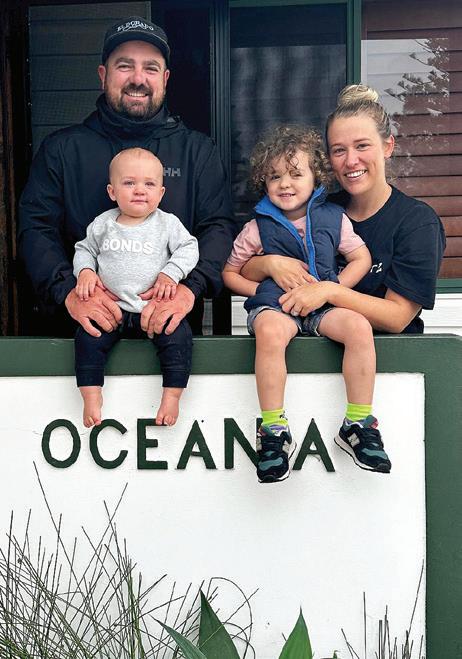
University Internship Program. Those first 18 months of my overseas travels made me realise that this career was exactly what I wanted to do for the rest of my life. I guess I always loved what I did, but the stint in the USA cemented within my own mind that I was
good enough to succeed. I could not have asked for a better place to begin my internship – Congressional Country Club in Maryland. I would end up interning there on two separate occasions with a stint at Doral Golf Resort in Miami in between.
Being a single young adult at the time, I felt like I had no reason to return back to Australia and had every opportunity to keep traveling and working at some fantastic facilities after my time on The Ohio Program. Fortunately, I got to work under some of the most successful superintendents of modern times and absorbed as much information as possible. I also got to work in some very harsh climates which allowed me to adapt to situations back in Australia that seem minor compared to what other countries have to deal with (i.e. extremely poor quality recycled water, high nematode counts and non-English speaking staff).
Working with staff who didn’t speak English was arguably the best part of my travels. It demonstrated that communication is paramount no matter what the situation, so whether that was learning the language or physically being there to show the team the processes, you had to focus on it all the time. But it’s amazing how a smile and a thumbs up is universal.

MAY-JUNE 2024 59
Opposite: Cameron Smith, pictured here volunteering at last year’s Australian Open, has packed a lot into his 18-year turf management career. After eight-and-a-half years at Bonnie Doon Golf Club in Sydney, he recently accepted the superintendent role at Sanctuary Cove on the Gold Coast
The Smith family – Cameron with one-year-old Elroy and wife Taneal with four-year-old Fraser


What were some of the biggest learnings you took from your time working overseas?
Probably understanding that there are many ways to achieve the same outcome. Each person has their own way and it’s neither right nor wrong. More importantly, I discovered that managing a golf course isn’t just about the agronomics, it’s about the people executing the day-to-day operation.
You develop an understanding of how you can squeeze the most out of an individual. Some team members are meticulous at what they do and while they may be slower than others you can utilise those strengths to create outcomes in different areas. Some team members respond better when a firmer, disciplined approach is taken whereas others respond far better with a softer more technical approach. Understanding those factors is a great thing to master and will hold you in good stead as a leader.
What was the biggest learning curve when you took the reins in your first superintendent role? I had spent around five years as an assistant overseas and then at Bonnie Doon Golf Club before taking over as superintendent there in May 2017. I guess the biggest realisation was that from fence line to fence line the property was now my responsibility and that the buck stopped with me. I had been given the responsibility to manage an invaluable piece of land as well as the health and safety of 15 staff. It was a very daunting prospect, especially at one of Sydney’s great private clubs.
Implementing your own agronomic programs was a steep learning curve too because each year was different and each site is different. For example, what I had learned and applied in my previous roles in places like Dubai or Mexico, only 25 per cent of that could be translated to Sydney.
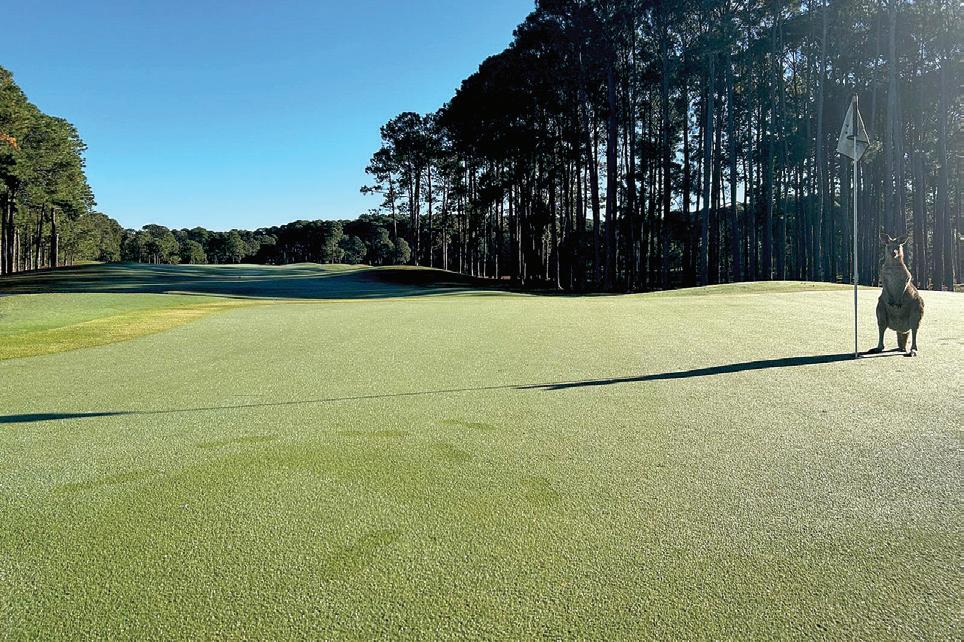
Shortly before we submitted this profile, you announced your resignation from Bonnie Doon and appointment as the new superintendent at Sanctuary Cove Golf & Country Club. What a huge decision and what prompted the move to Sanctuary Cove? After so much hard work and achieving so much with the team at Bonnie Doon, it was definitely a huge decision, probably the biggest of my career and personal life. I spent so much time at Bonnie Doon (eight-and-ahalf years total) and felt like it was my own little piece of land in the middle of one of the biggest cities on earth.
Ultimately, family was the big reason behind the decision to move. All my best friends and my wife Taneal’s family reside in Queensland. Our two young boys – Fraser (4) and Elroy (1) – are growing up fast and it was getting to the stage where we had to start thinking about schools. Taneal and I always said that when the boys started school that was where we would stay until they were done, so that was an enormous part of the decision.
From a career perspective, managing a large facility like Sanctuary Cove was always next on my personal hitlist. It’s nice to be back on couchgrass greens as well as managing multiple courses and areas – 39 holes instead of 19, double the staff, double the machinery –double everything! Bring it on!
This is ultimately a move ‘home’ for you, right? I’ve seen you in that maroon State of Origin jersey… Well, I was born in Victoria but the family moved to Queensland when I was five, so yes you could say it is home absolutely. Purely by coincidence, we will be managing the Maroons’ training camp at Sanctuary Cove in the lead-up to this year’s State of Origin, so I’ll get to see it in action and have the opportunity to pull the jumper out.
Together with your assistant Craig Geeve, you built a really strong team and culture at Bonnie Doon. Now that both yourself and Craig have moved on to new roles (Craig is superintendent at Duntryleague GC), how is the senior leadership structure there at Bonnie Doon? The structure left at Bonnie Doon is as solid as it was when Craig and I were there together. Identifying the key staff members who excel in ownership and are extremely technical on all sides of the operation was important. I personally believe it was all about allowing everyone to have a voice in the team and having an open book about things. Everyone knew what was happening and where everyone stood.
The Pines course at Sanctuary Cove (pictured is the 8th green) underwent a $5 million redevelopment in 2021 which saw all greens reconstructed to USGA spec and turf converted from 328 to TifEagle
60 AUSTRALIAN TURFGRASS MANAGEMENT 26.3
BEN GIBSON
In taking over the 36-hole Sanctuary Cove (pictured is the 9th on the Pines course), Smith now oversees 200 hectares of maintained turf surfaces and a crew that is double the size from when he was at Bonnie Doon
Ian Howell, Brad Glen, Stefano Tettamanti, Jacopo Bernasconi and Steve Blacklock are guns. They all know what it takes and will be the key guys to lead that team going forward. In saying that, the entire team were guns but these guys knew the course, knew machines and knew what was needed at any one time.
What are you most proud of from your time at Bonnie Doon? Completing the OCM Master Plan was a massive one, but also realising, only once I had left, that I had made my mark on it from an agronomic and staff culture standpoint. We all came a long way as a club and as a team from 2017. There were a few who came and went in the first few years, but once we settled on the core group the rest took care of itself. I always remember the first Toolbox Seminar I attended at Moore Park when we were given the book ‘Legacy’ about the All Blacks rugby team and how that group of people ultimately defined what a dynasty is. That book helped me in so many ways as a leader to develop more leaders within.
In my last week at Bonnie Doon I put up a post on my LinkedIn profile where I reflected on my time there. As I filtered through what seemed like thousands of photos, I was reminded of some of the amazing memories and lifelong friendships that were made

during that time. Through some crazy times we accomplished a lot and I left there with an immense amount of pride and gratitude to everyone who made that part of my career unforgettable.

What are your plans for Sanctuary Cove?
What is your approach to look after such a diverse property? I’ve only been in the role for a few weeks, so my plan has been just getting my head around the sheer size of the property and understanding how everything works. Sanctuary Cove has 200 hectares of maintained surfaces, is Audubon-certified and I have arrived in the middle of major enhancement works on the Palms Course. I am now overseeing a team that is double the size of what we had at Bonnie Doon so there is a lot to look at and understand where the team is succeeding (and celebrating that), but also identifying where I can make my mark and continue to raise the bar on a personal and facility level. Gaining the trust of the group and having them buy into what we can do as a team is really important. My job at the moment is to listen, watch and listen some more.
How would you describe your leadership style? I feel I have changed a lot over the years. I still have that mentality of leading from the front but it’s more now about empowering others to lead the team. I’m that last man behind everyone making sure that nothing is left unturned or identifying where we have some slower movements and helping those in the ‘pack’ to keep up.





MAY-JUNE 2024 61
PHOTO: CHRIS SEARL
Trust proventhe performers • Foxes take up to 30% of lambs born • Highly effective bait • Shelf stable for good control programs
native wildlife
up
50 times the costs!
residue • Available only to permitted users (RS7) Fox Bait & Econobait FOXOFF® FOXOFF® Animal Control Technologies Australia Pty Ltd Phone: 03 9308 9688 Fax: 03 9308 9622 Email: enquiries@animalcontrol.com.au More info at www.animalcontrol.com.au Protect lambs from foxes! • Sterilised (irradiated) • High Performance & Rapid Kill • Proven Attractant Formulation • Clean and Consistent bait • Biosecure - Quality controlled production • Easy application by ground and air • Reliable & Convenient supply Best Value – Result – Response RABBAIT® Pindone Oat Bait & 1080 Oat Bait
Smith with The Australian Golf Club’s second assistant Vincent Demarzo during last year’s Australian Open
• Protects
• Benefits are
to
• No


Who has influenced your turf management career and what impact did they have?
There are two superintendents who have had an equal role in developing my career – Mark Hooker and Darren Flannagan. I joined Al Badia Golf Club in Dubai in early 2012 when Mark was the superintendent. Mark really influenced my technical ability and impressed upon me the importance of collecting data to measure what we do. After leaving Al Badia in April 2013, I joined Darren as his assistant at El Dorado Golf and Beach Club in Cabo San Lucas, Mexico where I stayed for two-and-a-half years. Darren influenced my understanding of building a culture and keeping me grounded on success. His tenets were keep it simple, trust being yourself and trust being a greenkeeper – you have to feel the course.
The largest influence on my career has been my wife Taneal. There were some very long days, weeks, months and years at ‘the Doon’ and the old “Renovations again?! Didn’t you do them last week?” were all big for me personally and without her full support I could never have been able to achieve what I have so far. Now with a young family and being the brilliant mother she is, Taneal has helped me to be better with my time management. That means being as productive as possible during my time at work and first and foremost being ‘dad’ when I am at home.
How do you balance turf, family and looking after yourself? I am a firm believer that family comes first. As a superintendent you leave home early and are sometimes not back until

very late. I don’t think you can truly balance everything perfectly, but if you can be as timeefficient as possible then you will go a long way to achieving some sort of balance. If you can be as productive as possible in the 8-9 hours you are at work, or stay back late one day or have trust in the team to go home at 12pm one day and spend quality time with your family, then I believe therein lies balance. I love my family and spending as much time with them helps me to look after myself. I like to get in the ocean as much as I can, even for just 20 minutes. Swimming clears the mind.
What do you like to do outside of work?
Do you have any hobbies? Being a dad is number one, shooting hoops with my sons and swimming together. Fortunately they love the water just as much as I do. Outside of that, I like to do a bit of surfing when I can.
Where do you see yourself in 10 years? I see myself making a very good statement here at Sanctuary Cove and elevating the
conditioning of the courses to a consistent standard. My ultimate goal over the next 10 years is hopefully managing a few more facilities. I really thrive when there is a lot of moving pieces and going from 18 to 36 holes already has been a motivating step, but ideally 54-72 holes would be where I see my career.
What advice would you give younger staff just starting out in turf management today? Our trade is like no other. We have to manage a living, breathing end product. Being a superintendent may not be for everyone, but to succeed in this industry you need to do the little things right and consistently right. A few non-negotiables are being on time every day and quality over quantity. Start with straight lines. Work on being the best you can be at each job. Once a leader sees that a team member is showing pride in his/her job each day, you gain the trust of the group and more opportunities arise. Don’t be scared to ask questions and keep on asking questions. Knowledge is king and the more you can understand the movements and outcomes that are expected, then you can start to throw your twist on it and look for little efficiencies within that task.
Also, don’t be afraid to put yourself out there. Head overseas, volunteer at a tournament. They are tremendous experiences. I volunteered at the 2023 Australian Open at The Australian Golf Club where I was on back nine set up for the week. It was one of the best weeks in my career, meeting some fantastic well-grounded turfies as well as catching up with some great mates.
62 AUSTRALIAN TURFGRASS MANAGEMENT 26.3
BEN GIBSON
During his tenure at Bonnie Doon (pictured top and above), Smith not only stamped his mark on its conditioning but also culturally with the course team








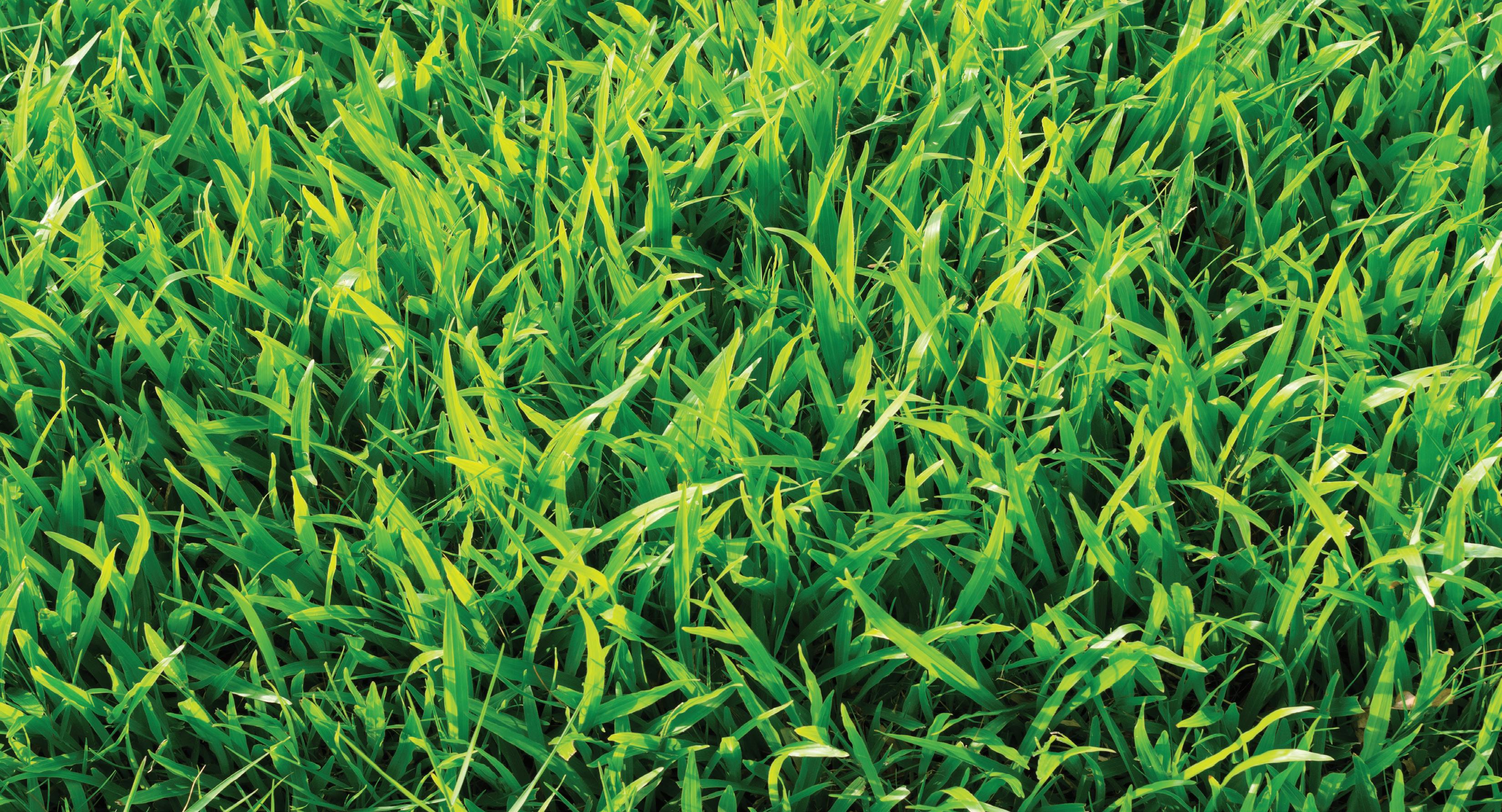






JOHN DEERE LAUNCHES NEW ONLINE COURSE DATA MANAGEMENT PLATFORM
ASTMA Gold Partner John Deere has unveiled Operations Center PRO Golf, the next evolution in its golf course management software allowing golf course superintendents to harness the full power of their fleet and crew. Operations Center PRO Golf streamlines features from the pre-existing OnLink program into John Deere’s Operations Center data management platform, to allow informed decisions to be made in real time from any device, on or off the course.
Stephanie Gersekowski, John Deere Australia and New Zealand’s production systems manager, says Operations Center PRO Golf lets users connect, guide and manage like never before. “We’ve taken all the great features of OnLink and combined it with Operations Center to create a product with more versatility, reliability and ease of use,” says Gersekowski. “There are many things to consider when managing a golf course, so having reliable, real-time data is crucial if you’re looking at making efficiency gains or becoming more sustainable.
“For example, using the Operations Center PRO Golf, superintendents can monitor their fleet’s schedule, customise fleet and crew reports, assign jobs and communicate with staff, manage labour costs, schedule maintenance and streamline servicing with a real-time parts inventory.”
The benefits are echoed by John Deere product manager in the United States, David Anderson, who says the cloud-based software is designed to improve communication among course staff, streamline efficiency and allow for more data-driven decision making. “All the jobs superintendents are currently doing, whether on a whiteboard, notebook or spreadsheet, can now be accomplished within the Operations Center PRO Golf platform and are easily accessible wherever they are, on any internet connected device,” says Anderson.
“John Deere’s golf course technology continues to evolve, as does technology
adoption within the industry, particularly among younger superintendents. They’ve grown up with the phone in their hand and expect to have instant access to information and they’re really pushing to learn more about their own operations. This platform gives them the flexibility to make crucial decisions in an instant, no matter where they are.”
Some of the features of Operations Center PRO Golf include;
l Equipment and location history: From any device, users can monitor their fleet, make assignments and schedule adjustments on the fly. Geofencing and curfew functions increase visibility across a fleet, allowing boundary limitations and machine movements to be handled from anywhere.
l Fleet and crew reporting: Remote access to fleet and crew reports optimises task tracking, with easy exporting of customisable reports helping superintendents to manage dollar allocation, staff hours, equipment engine hours, cost of ownership and more.
l Job board management and crew communication: Real-time job board management allows for staff adjustments and job assignments to be made from anywhere, including notes each crew member can access individually from their phone so they always know what they are responsible for.
l Labour cost management: Adjustable alerts for overtime hours help keep labour costs in check, while customisable reporting shows trends and potential issues to better balance workloads and manage crews more efficiently.
l Real-time parts inventory and dealer support: The integrated parts inventory automatically updates when service tickets are completed. John Deere dealers can be given access to critical fleet data to streamline servicing and ensure they always have the right parts ready.
l Scheduled maintenance and engine hours: Up-to-date factory-recommended schedules are integrated into the platform. Users can add their own work orders without having to manually enter engine hours for connected machines or manually track every piece of inventory.
To learn more about John Deere’s golf course management tools, visit www.deere. com.au/en/golf-sports-turf or contact your local dealer.
HURST JOINS ENVU
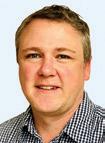
ASTMA Gold Partner Envu has appointed David Hurst (pictured) as a territory business development manager (Turf & Ornamentals) for Victoria, Tasmania and Western Australia. Hurst, who started his new role in the first week of May, comes to Envu with over 20 years of experience working in the industry across New South Wales, Victoria and in the United States.
Hurst began his career in Melbourne where he completed his apprenticeship and Diploma in Turf Management. This then led to an internship at the Los Angeles Country Club in California. Upon his return to Australia, Hurst demonstrated his leadership and operational abilities in a management role at Cromer Golf Club in Sydney. His dedication to the field led him back to Melbourne in 2021, where he contributed to the construction of The Furrows short course at Kingston Heath before his most recent role as territory manager in golf and turf for Brandt in Melbourne.
“We are very happy to welcome David to Envu,” says national sales and marketing manager (Turf & Ornamentals) Craig Burleigh. “With his extensive experience and passion for the turf industry, David brings a wealth of knowledge that will strengthen our ability to deliver innovative solutions to our end users in Victoria, Tasmania and Western Australia.” Hurst can be contacted on 0428 211 943 or email david.hurst@envu.com.
64 AUSTRALIAN TURFGRASS MANAGEMENT 26.3 AROUND THE TRADE
John Deere’s Operations Center PRO Golf data management platform allows superintendents to make informed decisions in real time from any device, on or off the course
NUTURF, JACOBSEN SIGN DISTRIBUTION AGREEMENT
ASTMA Bronze Partner Nuturf has become a national dealer for ASTMA Silver Partner Jacobsen’s range of mowing equipment. The collaboration expands on Nuturf Equipment Solutions’ machinery portfolio and reinforces its commitment to delivering high-quality solutions to customers across Australia.
As an ELiTE-accredited and authorised dealer for Jacobsen, Nuturf Equipment Solutions will carry a comprehensive selection of top-of-the-line mowers designed to meet the demanding needs of commercial landscapers, golf course managers, municipal parks and turf maintenance professionals. Jacobsen mowers are recognised worldwide for their performance, durability and innovation, making them the preferred choice for maintaining pristine landscapes.
“We couldn’t be more excited to partner with Jacobsen and bring their exceptional range of professional-grade mowers to our customers,” says Nuturf’s national business lead Liam Harper. “This partnership aligns perfectly with our mission to provide best-inclass solutions that enable our customers to achieve outstanding results. With Jacobsen’s industry-leading mowers and our commitment to customer service, we are poised to deliver unmatched value to the Australian turf maintenance market.”
The Jacobsen range offered by Nuturf includes a variety of models including the new Eclipse 360 ELiTE lithium triplex mower, SLF1 ELiTE five-gang lithium mower and LF range of fairway mowers. Being able to offer electric mowers from Jacobsen’s ELiTE range means turf professionals across Australia can benefit from Nuturf being a one-stop shop for sales, service and parts. Nuturf Equipment Solutions


A
NEW

is supported by Jacobsen’s ELiTE Approved Training and Service program, enabling the company to sell and support Jacobsen’s range of all-electric machines.
“We are excited to welcome Nuturf to the Jacobsen dealer network,” says Jacobsen’s Australia/New Zealand regional sales manager Peter Schumacher. “Their expertise, service support and dedication to customer satisfaction make them an ideal partner for representing our brand and serving the needs of turf professionals across Australia.”

In other Nuturf Equipment Solutions news, Matt Wrigley (pictured) has been appointed as the company’s new territory manager for Victoria and South Australia. Wrigley is a familiar figure in the Victorian turf industry, having an 18-year track record in customer-facing sales roles, including notable stints at Country Club International and ADE Turf Equipment. Wrigley can be contacted on 0498 019 917 or email matt.wrigley@nuturf. com.au.





Wrigley’s appointment follows closely on the heels of Justin Kelly’s recent promotion to the role of national operations manager for Equipment Solutions. Drawing on his wealth of experience in equipment sales and customer support, Kelly (pictured) will enhance Nuturf’s internal sales capabilities and operational efficiency within the equipment portfolio. He can be contacted on email justin.kelly@nuturf.com.au.
INDIGO’S DUAL APPOINTMENT


April saw Indigo Specialty Products announce two new regional account managers – Andrew Melville (pictured left) and Richard Herzina (pictured right). Melville is regional account manager for NSW/ACT, Qld and WA and will also take the lead in strategy development, implementation and management of lawn care distribution nationally. Based in Sydney, Melville can be contacted on 0418 146 810 or email andrewm@indigospecialty.com.
Herzina has taken a similar role covering Victoria, SA, NT and Tasmania and will take the lead in strategy development, implementation and management of the nursery and landscape markets. Based in Melbourne, Herzina can be contacted on 0459 256 884 or email richardh@indigospecialty.com.
“I am excited to have Andy and Richard join our team,” says Indigo’s Peter Kirby. “We are expanding our core markets, including a key focus on the vegetation management and rural retail sectors, as well as amenity horticulture and nursery and landscape sectors, with a vast range of existing products and a number of innovations in the pipeline.”


NAME IN THE AUSTRALASIAN TURF CARE MACHINERY MARKET
For nearly four decades Campey have supplied the latest market leading, innovative turf care machinery to many of the worlds leading turf care professionals, who are responsible for some of the worlds finest sports surfaces. We’re continually researching new techniques and refining existing practices. To find out more and view our latest cutting-edge turf care machinery visit www.campeyaustralasia.com

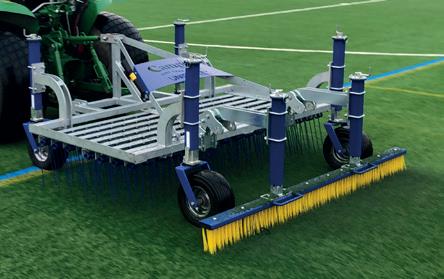

MAY-JUNE 2024 65
Nuturf’s Liam Harper (left) and Luke Furness (right) with Jacobsen’s Peter Schumacher and Karen Proctor
ASTMA RTO

As I reflect on the outstanding success of our first 12 months delivering training in the Certificate III and Diploma of Sports Turf Management courses, I can’t help but gain a sense of pride in what we have achieved so far. I have been overwhelmed with the level of support from the ASTMA Board, chief executive Mark Unwin and the amazingly dedicated people that make up the ASTMA team as we have navigated the first year as an accredited Registered Training Organisation.
I am often asked why the ASTMA made the decision to enter the training market? The answer is simply to meet the gaps that the industry was telling us, in providing all sports turf venues across Australia with access to quality training.
When you look at our qualifications during the last decade or more, there have been a number of centres who have walked away from delivering our major apprenticeship course (Certificate III), an example being South Australia and the Northern Territory. With the Diploma, students were unable to access this higher education qualification in several states, with the industry asking for assistance in filling this critical void.
Our vision was simple. In order to ensure our industry continues to have sufficient training opportunities for current and future generations of sports turf managers, we needed to provide access to training for all students and employers at facilities that previously had no access to the Certificate III and/or the Diploma qualifications.
Since our formal announcement in May last year that we had met the stringent requirements set by the Australian Quality Skills Authority (ASQA) to allow us to start delivery from July 2023, we have seen enrolments in both courses surge. To date, we have delivered and assessed a total of 15 units across stages one and two of the Certificate III course and seven units in the Diploma.
ON THE MOVE…
JAKE ANDERSON: Appointed as Melbourne & Olympic Parks Trust’s new AAMI Park and sports ground coordinator after spending the past three years as Carlton Football Club ground manager.
GLEN BEAUCLERC: From superintendent Oxley GC, Qld to superintendent Links Hope Island, Qld.
JAY INFANTI: Resigned as superintendent at Eastern GC, Vic.
SCOTT IRVING: The former Latrobe Golf Club superintendent of 16 years has been appointed team leader golf and sportsfields at Maroondah City Council, Vic.
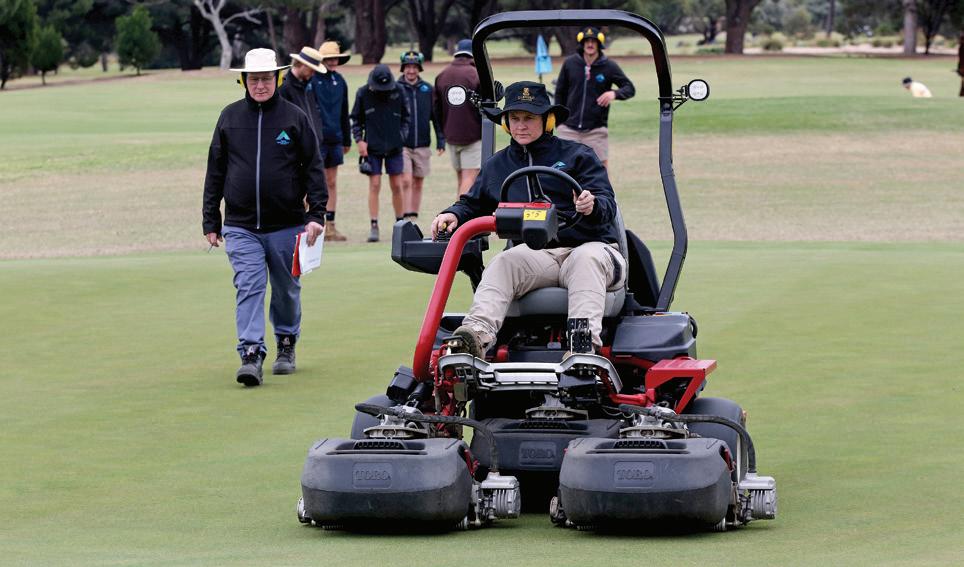
INDUSTRY ENGAGEMENT
One of the key take home messages from the year of planning was that we needed to be more transparent and provide more open dialogue to employers and students. From the feedback we receive this has been well accepted as we continue to work together collectively in the training partnership.
We have fostered all students in the Certificate III to gain an understanding of their Turf Management South Australia (TMSA) association and encouraged them to become members. We have also introduced them to aspects of the wider industry, such as attending the 2023 TMSA conference and trade day at The Grange Golf Club to help further their networking opportunities.
We have also exposed students to a variety of sports turf sectors including golf, sports fields, artificial surfaces and lawn tennis during our four assessment blocks as we aim to provide students with an insight into all sectors of industry across their training. These have been held at some of South Australia’s best venues including The Grange GC (superintendent Rowan Daymond), Glenelg GC (superintendent Tim Warren), Adelaide Oval (head curator Damian Hough) and Royal Adelaide GC (superintendent Nathan Bennett). We are indebted to these facilities for the time they have afforded our students.
Our aim is to offer greater flexibility in the training experience to meet the needs of the student and employer groups. We strongly believe that training is best undertaken at the workplace. In order to achieve this we have focused on enabling our employer groups with the tools they need to support apprentices throughout their training. We offer employers and students with the opportunity to enrol at any time throughout the year, with students joining the next scheduled classes before returning to the units missed before completing their training.
OTHER COURSES
In addition to the Certificate III and Diploma courses, the ASTMA also offers other courses, including the Cricket Pitch Curator Accreditation Program and Chemical User Refresher Training (AHCSS00074). The former is designed to certify cricket pitch curators as skilled, knowledgeable and committed to the consistent preparation of cricket surfaces. Accreditation ensures that curators meet specific criteria and provides a pathway to expand learning and development and foster more quality curators in Australia.
The curator program consists of four levels of certification, each building on the knowledge and skills of the level previous. It builds from an introductory foundation level for inexperienced or volunteer curators, through to in-depth training on advanced aspects of turf management for Tier 1 venues hosting national and international fixtures (see ATM Volume 26.1 pp34-37 for full program details – Ed).
The Chemical User Refresher Training course covers the skills and knowledge required to transport, handle, store, prepare and apply chemicals. Chemical user certificates have an expiry date and in order to renew their certificate a sports turf manager does not need to complete the full course again but instead complete an update/ refresher course to keep their certificate valid. This is delivered in workplace environments and can be conducted at any time during the year. See the ‘Education’ section on the ASTMA website – www.astma.com.au – for more details on all the courses we offer.
Finally, congratulations to all the state Graduate of the Year Award winners. I wish them all the very best for the judging of the national awards and look forward to seeing their careers in the industry develop.
66 AUSTRALIAN TURFGRASS MANAGEMENT 26.3 ASSOCIATION REPORTS
ALBERT SHERRY TRAINING MANAGER, ASTMA
Since becoming an RTO, the ASTMA has successfully delivered and assessed 15 units across stages one and two of the Certificate III for SA apprentices and seven Diploma units to students outside of Melbourne and Sydney
GCSAWA

The dry weather continues for Perth with the recent forecasts of rain eventuating to not a drop for the metropolitan area. Perth has recorded less than 30mm since October last year! Even as we get into the second half of May we have had seven days straight over 28 degrees with not a change in sight. A lot of courses are already feeling the pinch with their watering budget and this just adds a bit more strain on them. With bores and irrigation having to be turned off from 1 June for three months, the handwatering hoses might be getting a good workout.
May is a busy time for a lot of courses around the state with Pro-Am season kicking off. Bunbury moved their popular three-day event forward a month to kick it all off and were met with 100mm of rain the day prior to tee off which washed away a lot of the bushland roughs and bunkers, making it a huge clean-up for superintendent Dave Brennan and his team. The Pro-Ams include visits to Wembley, Kwinana, WAGC, Cottesloe, Geraldton, Sun City and Dunsborough before
ACTSTMA

The ACTSTMA was pleased to recently announce the winners of its Graduate of the Year awards, sponsored by Living Turf. Annabelle Southall, from Royal Canberra Golf Club, was named as golf winner, while Jacob Moodie, formerly of Green Options and now also at Royal Canberra, was recognised as our sportsfield winner. Both Annabelle and Jacob will now represent the ACTSTMA in the national finals to be judged on the eve of the upcoming Australian Sports Turf Management Conference in Brisbane.
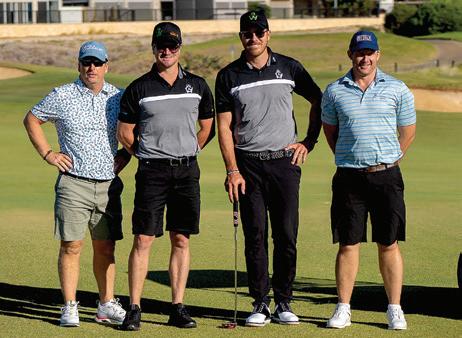
they make their way up north to Karratha, Port Headland and finally finishing in Broome. We wish all superintendents and crews the best for these events.
We held the GCSAWA Trade Challenge in mid-April with over 80 in attendance at Secret Harbour. Taking out the honours this year was the team from Green Workz with a total of 54.75. The team (pictured above) comprised former touring professional Steve Dartnall, Brent McPherson, Greg Jackson and Royal Perth Golf Club superintendent Pat Casey. They beat home the NewGround team (55.5) which contained local legend Neil Graham
Nearest-the-pin prizes went to Casey, Dartnall, Brendon Winterbourn (Environmental Industries), Rhys Whitling (Royal Perth GC) and Stewart Poole (Mandurah CC), with Matt Kennewell winning the longest drive.
In mid-May we held a two-day Chemical User Refresher Training course which was sponsored by Nuturf and ran by Northam TAFE. Fourteen people completed the course which focused on reading and understanding labels, chemical transport, application, storage and safety, nozzles and mixing. Our next event is the AGM and Living Turf Golf Day on 5 August at Lake Karrinyup Country Club (superintendent Fraser Brown).
A good number of WA supers and general managers have registered for the ASTMA/GMA conference in Brisbane, with many taking the opportunity to spend an extra few days in town visiting courses and going to the footy. I look forward to seeing you all in Brisbane.

Annabelle has been working at Royal Canberra throughout the duration of her apprenticeship and became the first female to win the award in the ACT/South Coast NSW region. Her performances at Canberra Institute of Technology (CIT) were consistently strong and match her growth as a greenkeeper at Royal Canberra. Well respected by her peers in class and throughout the industry, Annabelle is a very popular winner and has a bright future. Jacob (pictured left) was based primarily at the Australian National University maintaining and presenting a variety of surfaces including cricket, rugby, soccer and AFL to a very high standard. In what was a very strong field of finishing sports turf management students, Annabelle and Jacob deserve the accolades they’ve achieved and we wish them both well in Brisbane.
On 8 April the ACTSTMA held its annual Ambrose Day sponsored by Hutcheon and Pearce. We had a great turnout, with over

100 members and sponsors playing Gold Creek Country Club. Thank you again to all sponsors and delegates that supported the day. The ACTSTMA also proudly recognised Bruce Davies with life membership of the association. Bruce has given many years of service teaching at CIT and being part of the ACTSTMA committee. We can’t thank Bruce enough for all his time and dedication to our industry and educating so many of our tradies.
SIMON SNEDDEN COMMITTEE, ACTSTMA
GCSAQ I

t’s certainly been a wet start to the year across Queensland with solid rainfall in many areas. The reduction in temperatures has seen a welcome reduction in growth as many teams look towards the transition into winter with preventative applications and small course projects.
The association has an Irrigation and Spray Technician Education Day being held at Ballymore Stadium in Brisbane on 9 July targeting all golf and sports turf staff. This will involve speakers from Toro, Hunter and Rain Bird on their irrigation products, including new technology, servicing and troubleshooting, along with Syngenta outlining nozzle specs and water volumes for watering in products and boom spraying requirements to ensure product performance.
The second session will involve John Deere, Toro and Jacobsen sprayers out on the field with their distributors running through each machine’s innovative features that improve performance but also deliver accuracy and precision.
PRESIDENT, GCSAQ
ON THE MOVE…
CHRISTOPHER MCIVOR: From assistant superintendent The Glades GC, Qld to superintendent Helensvale GC, Qld. CAMERON SMITH: From superintendent Bonnie Doon GC, NSW to superintendent Sanctuary Cove G&CC, Qld.
MAY-JUNE 2024 67
SHANE BAKER PRESIDENT, GCSAWA
The Green Workz team collected the honours at the recent GCSAWA Trade Challenge at Secret Harbour
ACTSTMA golf Graduate of the Year Award winner
Annabelle Southall with Living Turf’s Scott Fogg
MARK HAUFF
VGCSA

After a very dry start to the year, the heavens opened in April with most parts of Victoria recording over 100mm of rain for the month. With the onset of cooler weather and plenty of moisture in the ground, most of us are now chasing Poa annua!
Following on from our March meeting at Metropolitan and Huntingdale, Yarra Yarra Golf Club (superintendent Clint Raven) hosted the 97th VGCSA Annual General Meeting in late April. Around 90 attended the day with 50 playing golf. Shaun Page (superintendent, Southern GC) picked up the Powell Trophy sponsored by Envu, while Hamish Buckingham (assistant superintendent, Metropolitan GC) won the Toro Cup handicap event. Alex Dosen (Anco Seed and Turf) took out the VGCSA Presidents Shield for the trade.
Channel 7 meteorologist Jane Bunn was guest speaker and gave a very informative presentation on weather factors and patterns they look for when forecasting and why we are experiencing weather extremes in recent years.
On the day we were delighted to acknowledge our annual award winners;
l Colin Foster (Barwon Valley GC) – VGCSA Superintendent Recognition Award; l Darren Wardle (Royal Melbourne GC/ Murray Downs G&CC) – VGCSA Apprentice of the Year Award; and l Nadeem Zreikat (Colin Campbell Chemicals) – VGCSA Trade Recognition Award.
The AGM saw a slight reshuffle of the VGCSA committee with Shane Greenhill stepping down from president to the general committee and myself moving into the president’s role. The full committee is:
l President: Adam Lamb (Commonwealth);
l Vice-president: Jeff Powell (Ballarat GC);
l Treasurer: Nicholas Douglas (Cranbourne);
l Secretary: Tay Wilson (Kooringal GC);
TMSA

Turf Management South Australia (TMSA) returned to The Grange Golf Club during LIV Golf Adelaide in April and what a remarkable event it proved to be! Course superintendent Rowan Daymond and his tournament crew had the course presented in wonderful condition. Additionally, the increase in tournament infrastructure added to the event’s grandeur and party atmosphere. Kudos to Rowan and his team along with everyone who contributed to making this event a resounding success.
As this edition was going to print, our second industry golf day was set to be held on Monday 20 May at the picturesque North Adelaide Golf Course, home to course superintendent Simon Work. We were thrilled



l Committee: Shane Greenhill (Sorrento GC), Geraldine O’Callaghan (Sandringham Golf Links), Clint Raven (Yarra Yarra GC) and Keegan Powell (The Sands, Torquay). Upcoming VGCSA meetings include the Course Staff Education Day at Southern Golf Club on Tuesday 4 June. The day will feature a live webinar with US agronomist Adam Moeller covering the topic of using data to develop aeration and topdressing programs. There will also be a panel session with young gun superintendents Tom Hogan (Flinders GC), Andrew Anderson (Ranfurlie GC) and Tom Lyon (Metropolitan GC foreman), plus presentations by Colin Campbell Chemicals, GTS, Apprentice of the Year winner Darren

to extend a warm welcome to both teams and sponsors and equally delighted that the event was a sellout!
Make sure to mark your calendars for the second annual TMSA Turf Seminar taking
Wardle, along with a course walk conducted by superintendent Shaun Page. Our Country Meeting is scheduled for late July at Cobram Barooga Golf Club. Among our guest speakers will be University of Tennessee professors Jim Brosnan and Brandan Horvath, agronomist John Neylan and Royal Auckland & Grange Golf Club director of agronomy Mark Hooker. The final event will be in September at Latrobe Golf Club which will feature a live webinar with Dr Shaun Askew (Virginia Polytechnic Institute & State University).
place at the Morphettville Racecourse on Tuesday 13 August. We have an excellent lineup of guest speakers, including keynote Jarrod Walsh, the renowned voice of live sport in Australia. Nationally, Jarrod is the match day MC for the Australian Socceroos, Cricket Australia and the Australian Boomers. Additionally, sponsors will be showcasing their offerings at the trade fair stand and machinery expo. Don’t miss this opportunity.
TMSA membership and sponsorship opportunities will also resume starting 1 July so please contact admin@turfmangementsa. com.au with any early enquiries.
NATHAN BENNETT PRESIDENT, TMSA
68 AUSTRALIAN TURFGRASS MANAGEMENT 26.3 ASSOCIATION REPORTS
ADAM LAMB PRESIDENT, VGCSA
Superintendent Recognition Award recipient Colin Foster (left) and Trade Recognition Award winner Nadeem Zreikat (right) with VGCSA president Shane Greenhill and CEO Mary Napier. Top – Yarra Yarra GC course walk
The Grange GC superintendent Rowan Daymond (left) and course staff during LIV Golf Adelaide
PHOTOS: JEFF POWELL


Hello friends...
The Masters at Augusta National Golf Club is on the top of every golf course superintendent’s bucket list.
After a four year wait, Leo Barber finally ticked it off his.
There has always been a sense of mystique around Augusta National Golf Club and the Masters tournament it hosts each year. Ever since I was a kid, it had this sense of ‘Willy Wonka’s Chocolate Factory’ about it. Not only was everyone searching for the tiniest bit of information about this patch of golfing utopia in the middle of America’s south, but most of us also dreamed about one day winning the lottery and getting the ‘golden ticket’ to step inside its gates.
I have looked forward to the Masters each year and its champions became my golfing heroes. As someone that has always enjoyed tradition, the Masters seemed loaded with history – the Champions Dinner, the honorary starters and the Green Jacket presentation to name but a few. When that familiar piano music came onto our TV screens each April and veteran broadcaster Jim Nantz greeted us with his immortal words, “Hello friends”, it

honestly felt like Christmas Day for golf fans –“a tradition unlike any other”.
I first met Steve Britton when he was 17 and I was 22 and we were both working on the groundstaff at Royal Melbourne. Steve has always enjoyed a rare passion for the history of
golf that was matched only by his enthusiasm for developing a career in turf management. We both ended up as superintendents – me at Paraparaumu Beach in New Zealand and Steve at Chevy Chase Club in Washington DC, USA – and despite residing in different countries we’ve kept in close contact and would often talk about attending the Masters together. Regarded as being one of the hardest tickets to obtain in sport however, it wasn’t simply a case of swiping a card.
Following a false start in 2020 when the world was coping with much more important issues than Leo Barber attending the Masters, this year I finally found myself making the longawaited trip. Among the despair of cancelled plans four years previous, I’ll forever remember the kind words of one of the suppliers that had arranged tickets, who passed a message back via Steve saying, “You tell your buddy, when the world gets back to normal, those tickets will still be there.” And they were.
70 AUSTRALIAN TURFGRASS MANAGEMENT 26.3 UP THE LAST...
AUGUSTA ATTITUDE
Exiting onto Augusta’s Washington Road it seemed almost incongruous that something so pristine as Augusta National Golf Club could reside in a neighbourhood of fast-food outlets and dilapidated motels. We were swept effortlessly into side streets by an army of paid volunteers and parked on land adjacent to the golf course that not so long ago had been home to hundreds of houses. Money can solve a number of problems and generous terms to residents eager to vacate had created an ease of access.
“Welcome to the Masters” was expressed by every official we passed as we made our way towards the gates. We joined the queue which was a theme for the day, but only at the Masters can a line that is thousands of people deep move so swiftly. Airport type security is the final hurdle and although cameras were allowed for practice days only, cell phones at all times are strictly prohibited. It was refreshing to just live in the moment and to be present alongside everything surrounding us.
There is no running inside the property and respect for staff, players and fellow patrons

is non-negotiable. Failure to adhere to basic courtesy can and does result in permanent cancellation of your ticket. No one dares to try test that resolve. People apologise for the
most minor infractions such as an accidental bump, no one jumps a queue and people are courteous beyond what feels normal. I couldn’t help but feel that the world could use a little more of the Augusta attitude in their lives!
The Masters feels like a series of smaller experiences and we set out on that first day to tick off as many as we could. Our first stop was the legendary concession stands to take on board some sustenance for the day ahead. Inflation seems to have affected almost everything except the cost of food and beverage at the Masters, with the classic Pimento and Cheese Sandwich just $1.50 and the Georgia Peach Ice-cream Sandwich $3. I saved both for lunch and went for the recommended Chicken Biscuit (read burger) for breakfast washed down with a lemonade. I can only imagine the production line out the back servicing the continuous queue of hungry and thirsty patrons throughout the day seeking out the age-old culinary Masters classics that were specially wrapped in green packaging and served up as they had been forever.
The two merchandise shops on the property also get punished from dawn to dusk with reports of the tills ringing up over a million dollars an hour. I purchased the obligatory apparel with the famous ‘map and flag’ but also went for some gifts that would last a

MAY-JUNE 2024 71
Opposite: Leo Barber (left) and Steve Britton outside the famous Augusta National clubhouse at this year’s Masters tournament
VERTI-DRAIN® 2519 Discover the performance of our high-speed aerator Compatible with a wide range of solid and hollow tines 1.90m working width and up to 25cm depth for efficient and deep aeration For more infomation visit www.redexim.com
Straight to the pool room… the popular Masters Gnome that made it back safely to the Barber residence in Paraparaumu Beach, NZ
little longer, such as glassware, a Christmas decoration and, one of the more recent traditions, the ‘Masters Gnome’ (pictured previous page) which appeared to be one of the more keenly sought after items, selling out before 8am each day. Purchased items can either be shipped home or stored for collection later in the day much like duty free.
AS SEEN ON TV
The first look at the course proper didn’t disappoint with wall-to-wall tightly-mown ryegrass overseeded into Bermuda. There was not one weed or imperfection evidenced, with 170 staff preparing its surfaces each day and the level of presentation astonishing. The landscape crew reportedly has even more staff and the areas outside of the course were immaculate, with some beautiful walks in behind wonderfully screened trees and so many different spring flowering plants.
The golf was great but, in some ways, it almost felt secondary to the thrill of being able to roam Augusta’s property. It is a great viewing course and there are half a dozen points where a number of holes, both front and back nine, intersect to allow for the opportunity to watch multiple groups without moving too far.
The elevation change in the property is extreme with the clubhouse at its highest point, dropping right down into the depths of Amen Corner. The 10th is massively downhill and 18th a big hike back up and I am sure the fitness of both player and caddy are the underrated factors of any victory. The greens are large but the effective pinnable areas are small. Loaded with severe undulation, the failure to settle in the correct part of the green screamed “three putt” loudly. You definitely

need a solid short game and a calculated ‘miss’. The walk from greens back to tees is noticeable as the club addresses the distance issue in its own unique way.
It was surreal to walk Amen Corner and I’m not sure why I was surprised, but it looked exactly as it did on TV! It was almost reassuring to confirm that it was not simply a large soundstage in some Hollywood basement, but a phenomenal stretch of real holes that once again factored in the final day’s play. I found myself time and time again following my favourite golfers through that stretch and even a few times without golf as a final walk back to the carpark at the end of the day with the shadows descending. On the Sunday, we positioned ourselves behind the famous 16th green and when eventual winner

Scottie Scheffler obliged with a birdie we cautiously joined that ‘Augusta roar’.
During our time at Augusta National we were fortunate to spend a good chunk of time in Berckman’s Place which is an exclusive hospitality zone hidden just off the side of the 5th hole. Five restaurants cater to your every food and beverage desire with bottomless fervour. The structure itself, built for $30 million, in many ways doubles as a museum with some wonderful memorabilia on display and even items that date back to the property’s former life as a nursery.
There are also three replica greens – the 7th, 14th and 16th – recreated to the exact specifications, maintenance regimes and contours for Berckman’s patrons to enjoy. You are assigned a caddy in full white overall regalia and with putter in hand you get to experience putting as the players would which gives a small appreciation of just how difficult of a task it really is.
Our last act of the week was watching the Green Jacket ceremony performed for the members and patrons on the putting green following the TV version inside Butler Cabin. Scheffler was a deserved champion but as I walked away back to the outside world after a great four days escaped from reality, it felt like everyone that had made it onto the Augusta property that week could feel equally pleased. It’s a hard ticket to get, and maybe that’s what makes it even more special once you have it.
Thanks to everyone that made it happen –you know who you are – and I hope everyone gets to experience the joy of the Masters, maybe, just once in their lives. “Yes sir!”
72 AUSTRALIAN TURFGRASS MANAGEMENT 26.3 UP THE LAST...
Back to reality… a bucket list adventure ticked off. Barber (right) with Bo Jumbercotta (Landscape Supply Co.), Britton and and Scott Furlong (RTJ Club)
Britton and Barber stationed themselves at Augusta National’s iconic par three 16th hole for the final round of the 2024 Masters. The duo first met more than 30 years ago when they both worked at Royal Melbourne Golf Club
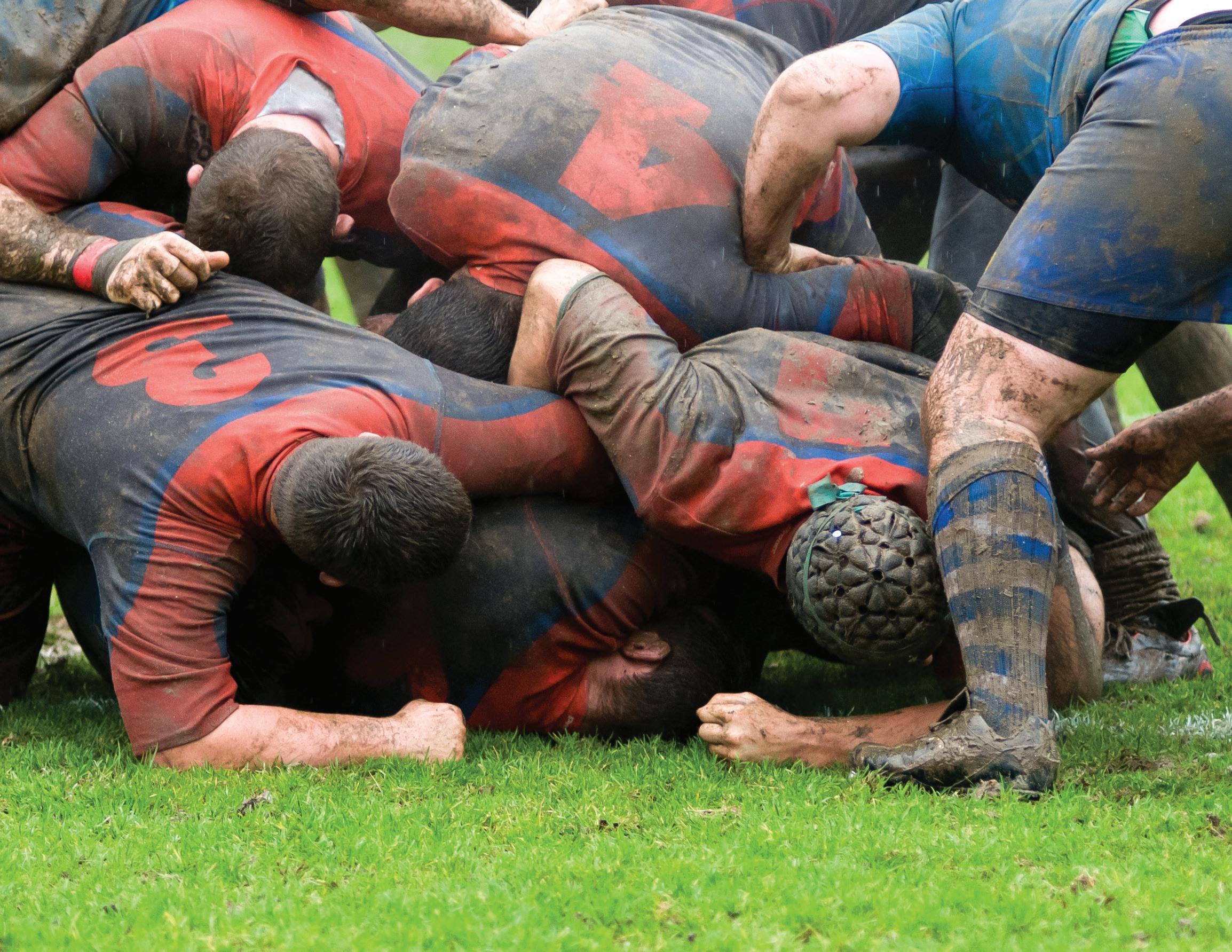

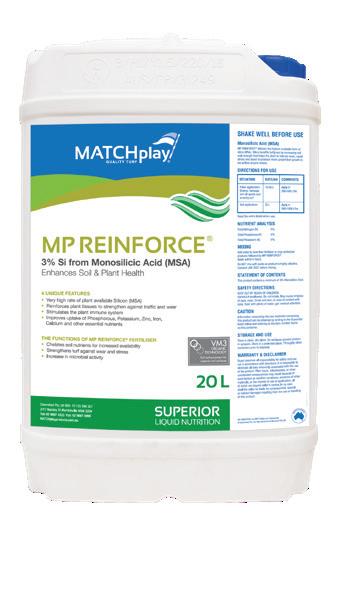



Give your turf the help it needs during the winter mauling. Build strength and resilience with MatchPlay Superior Liquids. Your turf can take a real pounding during the stresses of the winter sports season. Overuse, combined with the colder temperatures, can wreak havoc on your turf and undo all your hard work. But thankfully we have a solution, literally, for every problem. So whether you want to strengthen the leaf, shoot and root tissues of your turf, promote better recovery or build plant resilience, just call the go-to team behind your team. To find out how MATCHPLAY can help your turf, contact your friendly Living Turf Representative 1800 556 116 | livingturf.com.au GREENSHED Pty Ltd. ABN 70 105 996 307. PO Box 580, Leichhardt NSW 2040. LIVING TURF, MATCHPLAY, MP REINFORCE, MP REFRESH, MP SAFE K and MP NOURISH are tradenames of Greenshed Pty Ltd. NBW 24-2069


































































 Brett Robinson, Editor
Brett Robinson, Editor















































































































































































































































